
























On Sunday, we “sprung forward.” And despite schools starting an hour later on Sunday morning, I was still groggy that day. Monday? Forget about it! I could barely open my eyes in the morning. And the kids? Well, we just let them sleep a little late. No need to run for the bus when your body still thinks it’s in dreamland.
In the mornings in the week after we move the clocks in the spring, I have to force myself to lift my head off the pillow. And it didn’t help this week that the skies were gray and forbidding when we were supposed to wake up. There’s no tricking my body with earlier bedtimes; it doesn’t want to go to sleep any earlier than it usually does (which is never early, by the way). It takes me about a week of groggy mornings to slowly acclimate to the new times.
In the afternoons, though, I’m not complaining. There’s a certain freshness to greeting the kids in the broad daylight when they come home from school. It makes you want to still enjoy the day, even though the temperatures outside are freezing and the time on the clock is late. I find that the kids are more relaxed, spending more time on their “side projects” than rushing under their covers for bedtime.
Still, I know that they are looking forward to the spring’s (hopefully) balmy temperatures. I am, too. Today was frosty with frigid winds blasting through my coat. It took time to warm up the car, and I slipped on gloves so my hands wouldn’t be chilled when they touched the steering wheel.
But when I see the purple crocuses pushing through the frosted soil in my garden – even if they’re dusted with sprinklings of snow – I know that spring
is on its way. It’s a season of hope and renewal, a time of rebirth. It’s a breath of fresh air – literally and figuratively.
Along with the heralding of spring, comes the scent of Lysol and Mr. Clean. Because, for most of us, spring means that Pesach is on its way.
When I grew up, during the weeks before Pesach, we all pitched in to help clean the house. Each one had their job to do, and even though it was “work,” there was a certain excitement knowing that Pesach was on its way.

My kids feel it, too. There are groans when I tell them that their room is “next,” but I know that they secretly love to have their room deep-cleaned and organized. They go through all their stuff, throwing out mounds of objects that used to be so precious but have lost their luster over the past few months. We clear out their closets, making way for the new season. They go through old papers and reports. The decluttering is liberating and invigorating for them.
Before Pesach, while cleaning, there are certain things that I do in my home just as my family did when I was growing up. No, I do not take every crystal off the chandelier and rinse them in a vinegar solution. If I had a chandelier like my parents do, though, I probably would be doing that, as old habits die hard. But, chometz or not, the windows still get washed, the ceiling fans dusted, and the silver shined. Yes, I know it’s not necessary, but if I’m cleaning everything else, I might as well do that, too.
Wishing you a wonderful week, Shoshana
Yitzy Halpern, PUBLISHER publisher@fivetownsjewishhome.com
Yosef Feinerman, MANAGING EDITOR ads@fivetownsjewishhome.com
Shoshana Soroka, EDITOR editor@fivetownsjewishhome.com
Nate Davis
Editorial Assistant
Nechama Wein
Copy Editor
Rachel Bergida
Shana Brecher
Lani White
Design & Production
Gabe Solomon
Distribution & Logistics
P.O. BOX 266
Lawrence, NY 11559
Phone | 516-734-0858
Fax | 516-734-0857
Classified Deadline: Monday 5:00PM classifieds@fivetownsjewishhome.com
text 443-929-4003
PAYMENT VIA CREDIT CARD MUST BE SUBMITTED ALONG WITH CLASSIFIED ADS
The Jewish Home is an independent weekly magazine. Opinions expressed by writers are not necessarily the opinions of the publisher or editor. The Jewish Home is not responsible for typographical errors, or for the kashrus of any product or business advertised within. The Jewish Home contains words of Torah. Please treat accordingly.
Friday, March 17
Parshas Vayakhel/Pikudei
Candle Lighting: 6:45 pm

Shabbos Ends: 7:46 pm
Rabbeinu Tam: 8:17 pm

Dear Editor, I am so grateful that you featured “Country Yossi” in your paper this week! I grew up listening to Kivi and Tuki tapes (yes, tapes) and loved his show. His magazine was outstanding. Despite what he says in the interview with him, I still believe that Kayla Kuchleffel was his brainchild. The column was brilliant and laugh-out-loud funny.
But what I really loved about your article was how it brought out so many facets of Country Yossi and his journey. I was amazed to read that he is “shy” and does not have an outgoing personality. It just goes to show that you should not feel limited by your personality or certain character traits. You can accomplish things outside your “wheelhouse” if you set your mind to it.
I always tell my children and grandchildren that they should reach for the stars. Even if something seems out-ofthe-box or out of their zone, if it’s something they want to do, they should do it.

Sincerely,
Yaakov Herman Brooklyn, NYDear Editor,
Your article on Country Yossi was wonderful but one line really struck me.
In the article, Country Yossi was talking about his rebbe, Reb Shlomo Freifeld, zt”l, and how he said to him one time, “Yossi, you made my day!” Yossi then says that those words still “reverberate” for him until this day.
Reb Shlomo made this small comment many years ago, and it still affects Yossi now, decades later. It just goes to show that one small comment can affect a person’s life. True, Reb Shlomo was Yos-
si’s rebbe and he held his rebbe in high esteem. But we need to remember how our words can uplift someone and can really change their lives (hopefully for the better!).
A really good lesson to keep in mind.
Shira RothbergerDear Editor,
I recently had the zechus to be at the burial of a very important person. That week, I happened to also have heard a shiur discussing different aspects of jealousy. The question is asked how Yosef knew with such confidence that his bones would be intact when Bnei Yisroel left Mitzrayim, for he made them swear to it many years earlier. The verse proclaims that the bones of the jealous rot. Yosef was the epitome of one who trusted in G-d, which rejects the tenent of jealousy, and therefore his bones were sure to be intact.

Coming off of Purim, a question is asked why Esther didn’t tell Achasveirosh about Haman at the first party. Why did she wait until the second? The answer is that at the first party, she saw Haman was on top of the world, in great happiness, and she felt nothing could topple such simcha. At the next party, it turned out Haman was already humiliated and therefore his spirit was low, a ripe time to strike. Happy people are of the type who are not jealous and therefore remain untouchable. Why does jealousy exist? Only because one doesn’t recognize that everything is exactly as it’s supposed to be. With such probing eyes, one must list their precise blessings and realize that just as it’s important that you have those G-dly blessings, it’s necessary for some-
Continued on page 10
35% Cocoa Fruity

Continued from page 8 one else to have theirs. This leads to a perfect world.
Steven GenackUnder President Joe Biden, Senate Majority Leader Charles Schumer, and Department of Homeland Security Chief Alejandra Mayorkas, over 5 million people illegally crossed into our nation at the southern border. Now, more are attempting the same at our Canadian border.
On March 8, 1911, President William Taft sent 20,000 U.S. Marines to the border in response to the Mexican Revolution. Why doesn’t President Biden send some of our 160,000 military stationed abroad, 482,000 Army Activity duty stationed in the USA or 337,000 National Guard to both our Mexican and Canadian borders? They can assist our overwhelmed U.S. Customs and Border Patrol and local law enforcement to regain control of our borders.
Sincerely,
Larry PennerEvery year, as Pesach approaches, there are those who feel it is important to announce to the world that they already


finished cleaning for Pesach three weeks before the Seder and that their table is almost completely set for the Seder already. Although you can understand that these people are a bit over-the-top, it’s not comfortable for other people to hear such stress-inducing announcements. Are these people so insecure that they have to announce their “accomplishments” to everyone within earshot? Why is that so important to them? Why do they feel the need to rub it in everyone’s faces?
Truthfully, we all may be guilty of this type of thing in a smaller fashion. But I beg of you, please refrain from talking AT ALL about your Pesach prep. It is not helpful for anyone to hear how “far along” you are right now. No one needs to hear about your cleaning timetable. Everyone will get to the Seder at the same time and at their own pace.
This is not just a reminder to keep quiet and limit the boasting to in-person conversations. Social media is just as dangerous (if not more). Don’t post how your shelves are lined for Pesach or how all your bedrooms are now clean. No one needs to know (except your kids, so they don’t eat Cheerios in their beds).
Wishing everyone a stress-free pre-Pesach season!
Talia W.
They also plan to reimplement a security pact signed 22 years ago under which both parties agreed to cooperate on terrorism, drug-smuggling, and money-laundering, as well as reviving a trade and technology deal from 1998.
The announcement is a victory not just for the two Middle Eastern countries but also for China, who has not had much influence in the Middle East.
Talks had been ongoing since March 6 in Beijing between Iranian national security chief Ali Shamkhani, Saudi national security council adviser Mosaed Bin Mohammad Al-Aiban, and China’s top diplomat Wang Yi, according to Iranian state media.

Video of the signing ceremony aired by Iranian media showed officials seated around tables on opposite sides with the Saudi Arabian, Iranian, and Chinese flags around them.
not limited to the Ukraine issue,” while emphasizing that the fate of the Middle East should be determined by the people of the Middle East.
Saudi Arabia and Iran had previously held talks aimed at reconciliation in Oman and Iraq.
Riyadh severed ties with Tehran in 2016 after Iranian protesters stormed the Saudi embassy in the Iranian capital following the execution of a Shi’ite cleric in Saudi Arabia. Since then, they have fought a proxy war that has embroiled a number of neighboring countries, bringing the region ever closer to war.
started in September.


Iran’s main international ally, Russia, is preoccupied with the war in Ukraine, while China, its other ally, has lately been courting Tehran’s archrival Saudi Arabia.
In December, Chinese President Xi Jinping was welcomed in Riyadh in an extravagant ceremony as part of a visit that brought together 14 Arab heads of state. That was just months after a relatively low-key meeting with U.S. President Joe Biden, whose relationship with Saudi Arabia has been frosty.
In a historic announcement on Friday, the countries of Saudi Arabia and Iran agreed to reestablish diplomatic ties after years of hostilities.
The agreement was mediated by China.
Riyadh and Tehran plan to reopen their embassies within two months.
“We will continue to play a constructive role in properly handling hotspot issues in today’s world in accordance with the wishes of all countries and demonstrate our responsibility as a major country,” Wang said, adding that Chinese President Xi Jinping supported it since the beginning.
In an apparent dig at American influence, Wang said that “the world is
In Yemen, the two countries have supported opposite sides of a civil war that has been described by the United Nations as one the world’s worst humanitarian crises. From there, the Houthi rebels have fired missiles at both Saudi Arabia and the United Arab Emirates, targeting oil infrastructure that is vital to their economies.
Tehran finds itself increasingly isolated on the global stage. Talks to revive Iran’s 2015 nuclear pact with world powers are frozen, and relations with Western states have faced further strains due to the Islamic Republic’s brutal crackdown on protests that


Ramaphosa committed no wrongdoing in connection with the theft of more than a half-million dollars stashed in a sofa at his game farm three years ago.
The finding is a major victory for the president, who has been bedeviled for the past 10 months by accusations that he tried to cover up the theft to avoid scrutiny over having such a large sum of U.S. dollars stored at his property.
Ramaphosa still faces investigations by an elite unit of the national prosecutor and by the South African Reserve Bank, which is looking into whether there are any violations related to foreign currency exchange. But the public protector’s investigation was one of the last major legal hurdles for him regarding the incident.
The conclusion came from a report of preliminary findings by Kholeka Gcaleka, South Africa’s acting public protector. A statement issued by a spokesperson for Gcaleka on Saturday said the office could not reveal any contents of the preliminary report, which has been distributed to parties involved in the case so they can have time to respond. But The New York Times obtained a copy of the 191-page report.
The parties have 10 days to respond to the preliminary findings, and the public protector will consider the responses in
issuing her final report, according to the statement from her office.
A spokesperson for Ramaphosa confirmed that the president had received the report but did not comment on the specifics in it.
“As stated before, we reiterate that the president did not participate in any wrongdoing, nor did he violate the oath of his office,” the spokesperson, Vincent Magwenya, said in a statement. “Instead, the president was a victim of a crime that he duly reported to the relevant authorities.”
The report said Ramaphosa had properly reported the theft of $580,000 to Maj. Gen. Wally Rhoode, head of his presidential protection service and a member of the South African Police Service. In doing so, it said, the president had fulfilled his legal obligation to report the burglary, which occurred in February 2020.

“The public protector could not find any evidence upon which to conclude that after reporting this crime to General Rhoode, the president abused his power in utilizing state resources,” the report said. (© The New York Times)
It’s been three years, but now, China is finally reopening fully to foreign visitors, including tourists.
In a Chinese-language statement posted on its website on Monday, China’s Embassy in the United States said the country would resume issuing all categories of visas for foreigners starting on Wednesday.
Travelers holding multi-year visas issued before March 28, 2020 – the date China closed its borders to most overseas visitors in an attempt to keep Covid-19 out – would be allowed to use them so long as they had not expired, the statement said.

Last month, Chinese authorities declared a “major and decisive victory” in their handling of the coronavirus outbreak that had swept the country following an abrupt relaxation of Beijing’s “zero-Covid” policy late last year.
Beijing is trying to revive its economy and its domestic tourist industry after a year of tepid growth.
China scrapped quarantine measures for international arrivals in January in a partial reopening – news that was met with an outpouring of joy and relief from citizens including the hundreds of millions isolated inside the country for the past three years and those overseas separated from their loved ones.
Travelers to the country are still required to take a Covid test 48 hours before departure and need to fill in the results in their customs health declaration forms.
In an advisory updated March 10, the U.S. State Department urges American citizens to reconsider any travel to China, including Hong Kong and Macao, due to “arbitrary enforcement of local laws” and the risk of wrongful detention.
People in the Philippines are collecting human hair to help clean the ocean. Barbers, especially, are collecting any leftover hair in their salons to help contain an oil spill along the coast.
Two weeks ago, an oil tanker capsized off the coast of Oriental Mindoro province, spilling 800,000 liters of industrial oil. Since then, the slick has been dispersing towards the waters of Palawan some 100 miles away. Palawan, an island province composed of an elongated landmass and thousands of tinier islands, is home to famous white-sand beaches frequented by international tourists. It’s considered by UNESCO to be the country’s “last ecological frontier.” Now, the oil is threatening the pristine beaches.
The human hair – along with other items – is being used by residents to skim the oil from the water.
Hair has actually been scientifically proven to treat oil waste thanks to its porousness as well as oil’s natural affinity to it.
“Hair is adsorbent not absorbent,” according to the San Francisco-based organization Matter of Trust, which has been making oil cleanup booms from hair, pet fur, and fleece since 2000. “Hair doesn’t swell up like a sponge. Instead, the oil coats the entire surface area of the hair, and because of the sheer volume, it is a very efficient material.”
This isn’t the first time the Philippines has collected hair to clean oil waste: in 2006, a nationwide drive even prompted prison inmates to shave their heads and chests to help mop up some 189,000 liters of industrial fuel off the central island province of Guimaras.

Stomach pain, constipation, diarrhea, vomiting, bloating — these are symptoms frequently reported by people with long Covid.
Now a large new study reports that

Covid patients were significantly more likely to experience gastrointestinal problems a year after infection than people who were not infected.

“There seems to be some dysregulation that points to a major imbalance in acid production,” said the senior author of the study, Dr. Ziyad Al-Aly, chief of research and development at the VA St. Louis Health Care System and a clinical public health researcher at Washington University in St. Louis.
available.
The study, published last Tuesday in the journal Nature Communications, compared medical records of 154,068 Covid patients in the Veterans Health Administration system with about 5.6 million patients of similar age and other characteristics who had not contracted the coronavirus. Covid patients were 36% more likely to have long-term gastrointestinal problems that they did not have before their infection, with 9,605 of them experiencing issues affecting the digestive system, intestines, pancreas, or liver.
The most common diagnoses were acid-related disorders, like gastroesophageal reflux disease (known as GERD) and peptic ulcer disease, which were identified in more than 2,600 patients.
Serious inflammatory illnesses — like acute pancreatitis and cholangitis, which is inflammation of the bile duct system — affected a much smaller percentage of patients, but they were nonetheless more common among those who had Covid than those who did not.
Long Covid patients were also at higher risk of gastrointestinal symptoms, the most common being constipation, abdominal pain, and diarrhea.
The study, like others drawing on the database of veterans, involves a patient population that is largely white and male with an average age of about 61. Still, the same patterns were seen among the study’s 37,000 post-Covid Black patients and nearly 17,000 post-Covid female patients.
The patients became infected during the pandemic’s early waves, testing positive for the coronavirus between March 1, 2020, and January 15, 2021, the overwhelming majority before vaccines were

There are several reasons coronavirus infections may fuel long-term gastrointestinal problems. A protein the virus attaches to on some cell surfaces, called the ACE2 receptor, is abundant in the lining of the small intestine. Those receptors might provide a way for the virus to directly enter the digestive system. It’s also possible that some viral fragments remained after infections resolved, keeping patients’ immune systems activated and generating inflammation-related symptoms. (© The New York Times)

Nepal is home to eight of the world’s tallest mountains, but it is also known for its beautiful rural trekking regions. From now on, travelers who hope to trek in remote regions must hire a government-licensed guide or join a group.
Lost hikers have led to many search and rescue missions in the country. As such, while the trekking industry is one of the country’s biggest moneymakers, the cost of those missions for solo hikers who get lost is significant.
“When you are traveling solo, in case of emergencies there is no one to help you,” Mani R. Lamichhane, Director of the Nepal Tourism Board, said. “It is fine if they are traveling in the cities, but in the remote mountains, the infrastructure is not adequate.”
Lamicchane added, “When tourists go missing or they are found dead, even the government cannot track them because they have taken remote routes.”
Five years ago, Nepal banned solo adventurers from climbing Mount Everest. Now, its government is expanding the restriction to the whole country.
In addition to the challenges caused when hikers go missing in rural areas, Lamichhane says that unlicensed tour guides and companies are also an issue. These companies who do not register with the government do not pay taxes and, the tourism director alleges, take jobs away from Nepalis.
“There have been some cases where



the trekking association has been requesting us to stop these unauthorized trekking operations. This has been a demand from tourism associations for a long time,” he said.
tricts.”
“The threat of heavy flooding and damaging winds remains very high,” the report added.
On Tuesday, Charles Kalemba, a commissioner for the Department of Disaster Management Affairs agency, said that the situation had worsened in southern Malawi.
“It’s worse today. A number of places are flooding, and a number of roads and bridges are cut. Visibility is almost zero. Electricity is off and also network is a problem. It’s becoming more and more dire.”
He added, “It’s tough. We need to use machinery (for rescue operations) but machines cannot go to places where they were supposed to excavate because of the rains.”
dinated effort of the Israel Police, Border Police, and the Nature and Parks Authority National Wildlife Crime Prevention Unit.
At least 190 people were killed after Tropical Cyclone Freddy smashed through southern Malawi this week. Additionally, at least 584 people were injured, and 37 people are still reported missing.
The Malawi Ministry of Natural Resources and Climate Change said on Tuesday that the cyclone is “weakening but will continue to cause torrential rains associated with windy conditions in most parts of Southern Malawi dis -

The deadly cyclone has broken records for the longest-lasting storm of its kind after making landfall in Mozambique for a second time, more than two weeks after the first. At least ten people were killed in the African country, with more than 99,000 people being displaced by the storm.
Cyclone Freddy is the strongest tropical cyclone on record, according to the World Meteorological Organization.
Israeli actor, singer and Israel Prize laureate Chaim Topol passed away last week at the age of 87.
You may not have known his name, but you knew his songs. Topol was best known for his portrayal of Tevye, the lead role in both the stage musical “Fiddler on the Roof” as well as the 1971 film adaptation.

The actor was diagnosed with Alzheimer’s disease several years ago.
Topol was born on September 9, 1935 in Tel Aviv. He began his acting career during his Israeli army service in the Nahal entertainment troupe, and later toured Israel with kibbutz theatre and satirical theatre companies. He was a co-founder of the Haifa Theatre.
His breakthrough film role came in 1964 as the title character in Sallah Shabati, by Israeli writer Ephraim Kishon, for which he won a Golden Globe for Most Promising Newcomer—Male. Topol went on to appear in more than 30 films in Israel and the United States, winning a Golden Globe for Best Actor.
He was nominated for an Academy Award for Best Actor for his 1971 film portrayal of Tevye and was nominated for a Tony Award for Best Actor for a 1991 Broadway revival of “Fiddler on the Roof.”
In 2015, Topol was awarded the Israel Prize for lifetime achievement. He also received an honorary doctorate from Haifa University and Bar Ilan University.
Israeli authorities have busted a massive black-market operation featuring rare and exotic animal species, the Nature and Parks Authority said on Tuesday.

The Jerusalem-area raid was a coor-
“Thanks to the cooperation of the Israel Police and Border Police, we were able to stop a breeder that was illegally keeping a large number of animals, some of which were kept in poor condition,” said Nature and Parks Authority National Wildlife Crime Prevention Unit official Yaniv Shalom.
The animals, worth tens of thousands of shekels, were either set to be sold or were being kept by individuals. Those in poor condition were transported for veterinary care.

The suspect was transferred for questioning and a criminal investigation was opened.
Among the animals seized were redeared sliders—the most popular pet turtle in the United States and one of the most popular pets around the world—and the Boiga genus of rear-fanged, mildly venomous snakes, which are commonly known as cat-eyed or cat snakes. (JNS)
Researchers from Tel Aviv University and the Israel Institute for Biological Research have developed the world’s first mRNA vaccine effective against bacteria. Scientists used mRNA technology that had been used to fight Covid and other viral infections. They then developed a single-dose vaccine that would protect mice against the Plague, the lethal disease that killed millions of people during the Middle Ages and is still around today, especially in parts of Africa and Asia.
The researchers hope to adapt the


vaccine for other diseases, especially ones caused by antibiotic-resistant bacteria that could lead to a fast-spreading pandemic.
The study was published last week in Science Advances.

“There are many pathogenic bacteria for which we have no vaccines. Moreover, due to the excessive use of antibiotics over the last few decades, many bacteria have developed resistance to antibiotics, reducing the effectiveness of these important drugs,” said Prof. Dan Peer, VP for R&D and head of the Laboratory of Precision Nano-Medicine at the Shmunis School of Biomedicine and Cancer Research at TAU.
“Consequently, antibiotic-resistant bacteria already pose a real threat to human health worldwide. Developing a new type of vaccine may provide an answer to this global problem,” he said.
The scientists focused their study on the Plague-causing Yersinia pestis. But scientists say that other microbes are now a priority.
“The next step is to focus on bacteria that are more relevant for the general public now like Staphylococcus aureus and certain kinds of resistant Streptococcus,” said Dr. Edo Kon, the study’s lead author.
The advantage of mRNA vaccines is that they are now familiar, effective, and can be quickly developed. In the case of Covid-19, it took only 63 days to move from the publishing of the virus’s genetic sequence to clinical trials of the vaccine. Both the Moderna and Pfizer vaccines were mRNA vaccines.
But viruses and bacteria differ in a key way. Viruses depend on external (host) cells for their reproduction. They insert their mRNA molecule into human cells and use them as factories for producing viral proteins based on their genetic material.
“In contrast, bacteria don’t need our cells to produce their own proteins. And since the evolutions of humans and bacteria are quite different from one another, proteins produced in bacteria can be different from those produced in human cells, even when based on the same genetic sequence,” Kon said.
As a result, attempts by scientists to synthesize bacterial proteins in human cells resulted in low levels of antibodies that produced an insufficient immune response. The TAU and IIBR teams worked to bypass these problems. Their methods worked on the Plague bacteria. Now, they are working on other types of bacteria.
ing in parts of northern Samaria.
The 2005 Gaza disengagement led to the destruction and evacuation of the Israeli communities of Sa-Nur, Homesh, Ganim, and Kadim in northern Samaria, as well as 21 communities in Gaza.
The bill, sponsored by Likud Knesset member Yuli Edelstein, seeks to restore freedom of movement to Israelis in the four Samaria communities. It passed by 40-17.
A former aide to Yasser Arafat who was the oldest Palestinian prisoner in an Israeli jail was released on Monday after serving 17 years for arms smuggling, according to local media reports.

Fuad Shubaki, 83, was released from Ashkelon prison and was being transferred to Palestinian Authority-controlled Ramallah beyond the Green Line, said the reports.
Shubaki, a senior member of PA chief Mahmoud Abbas’s ruling Fatah faction, was sentenced for his role in attempting to smuggle weapons from Iran to the Gaza Strip aboard the Karine A
The ship, seized by Israeli forces in 2002, was carrying 50 tons of weapons, including Katyusha rockets and anti-tank missiles supplied by Iran and its Lebanon-based terror proxy Hezbollah.
Shubaki dealt with financial affairs for then-Palestinian leader Yasser Arafat and was convicted of purchasing the weapons through a foreign agent.
He was first detained by Palestinian security forces in 2002 and held in Jericho under U.S. and British supervision.
In 2006, the prison was raided by Israeli forces and Shubaki was taken to Israel, where he was tried in a military court and sentenced to two decades in jail.
His sentence was later reduced to 17 years. (JNS)
“There is no longer any justification to prevent Israelis from entering and staying in the evacuated territory in northern Samaria, and therefore it is proposed to state that these sections [of the disengagement law] will no longer apply to the evacuated territory,” reads the introductory text to the bill.
Knesset member Yuli Edelstein and National Missions Minister Orit Strook sponsored the measure at the request of Samaria Regional Council chairman Yossi Dagan, who was himself among those expelled from the Samaria communities.
The proposed legislation will now return to the Knesset Foreign Affairs and Defense Committee to be prepared for the second and third readings required to pass into law, including a discussion on whether to change the bill’s name to reflect that it does not apply to Hamasruled Gaza.
All Jews were forcibly removed from the Gaza Strip in 2005.
“This is the start of…correcting a historical injustice. I expect the law to be completely repealed. This is a struggle we have been waging for 18 years and we finally see the light at the end of the tunnel,” said Dagan last month as the bill was making its way through Knesset committees.
“The deportees of [northern Samaria] – heroes who are standing with us as the tip of the spear in this struggle – will yet see recompense for their actions. The residents of the communities of Ganim, Kadim, Homesh and Sa-Nur will return within their borders,” he added, referencing Jeremiah 31:15-16.
A game of cat and mouse has taken place between the IDF and former residents and supporters since the Disengagement, particularly at Homesh, where a yeshiva has operated out of caravans and tents. Troops have dismantled the yeshiva several times over the years.

The Knesset approved on Monday night its first reading a bill repealing sections of the 2005 Disengagement Law that prevent Israelis from entering or liv-
The coalition agreement between Likud and the Religious Zionism Party, led by Minister of Finance Bezalel Smotrich, requires the government to reverse parts of the Disengagement and allow for the Homesh Yeshiva to remain as a first step towards rebuilding the four communities. (JNS)


Sayfullo Saipov, the terrorist who killed eight people on a New York City bike path by ramming his van into them, will now spend the rest of his life in prison. A jury had declared him to be guilty in the 2017 attack but could not come to a unanimous decision on the death penalty.

The jury convicted Saipov in January of all counts against him for the fatal terror attack he committed on October 31, 2017. The terrorist drove a rented U-Haul truck into cyclists and pedestrians on Manhattan’s West Side bike path, then crashed the vehicle into a school bus, authorities said.
After leaving the truck while brandishing a pellet gun and paintball gun, he was shot by a New York Police Department officer and taken into custody.
“This evil act was fueled by Saipov’s allegiance to ISIS, an allegiance which Saipov proudly maintained after the attack and up through his trial. Today, a jury has declined to authorize the death penalty for Saipov, and accordingly the defendant will be subject to a mandatory sentence of life imprisonment without the possibility of parole,” U.S. Attorney Damian Williams said.
Saipov is expected to serve his life sentence at the Federal Bureau of Prisons ADX facility in Florence, Colorado, in solitary confinement at least 22 hours a day.
Want to leave work for a few days and still get paid? Move to Illinois.
This week, the Land of Lincoln became one of three states to offer paid time off for any reason. Gov. J.B. Pritzker signed the law on Monday that will take effect next year.
Starting January 1, Illinois employers must offer workers paid time off based on hours worked, with no need to explain the reason for their absence as long as they provide notice in accordance with reasonable employer standards.

Only Maine and Nevada mandate earned paid time off and allot employees the freedom to decide how to use it. Illinois’s law reaches even further – unencumbered by limits based on business size. Similarly structured regulations that require employers to offer paid sick leave exist in 14 states and Washington, D.C., but workers can only use that for health-related reasons.
Illinois employees will accrue one hour of paid leave for every 40 hours worked up to 40 hours total, although the employer may offer more. Employees can start using the time once they have worked for 90 days. Seasonal workers will be exempt, as will federal employees or college students who work non-fulltime, temporary jobs for their university.
After signing the bill, Pritzker said, “Too many people can’t afford to miss even a day’s pay ... Together we continue to build a state that truly serves as a beacon for families, and businesses, and good paying jobs.”
Proponents say paid leave is key to making sure workers, especially low-income workers who are more vulnerable, are able to take time off when needed without fear of reprisal from an employer.
But critics say the law will overburden small businesses already struggling to survive the post-pandemic era amid the high inflation that has gripped the nation for nearly two years.

Cardona said.
A handful of countries in which avian influenza is endemic, including China, Egypt, and Vietnam, already routinely vaccinate poultry against it. The vaccines are typically injected into individual birds and require more than one dose, said Dr. Leslie Sims, an international veterinary consultant on the prevention and control of zoonotic diseases who is based in Australia. (© The New York Times)
The Biden administration, keeping a watchful eye on an outbreak of avian influenza that has led to the deaths of tens of millions of chickens and is driving up the cost of eggs — not to mention raising the frightening specter of a human pandemic — is contemplating a mass vaccination campaign for poultry, according to White House officials.
The bird flu outbreak, which began early last year, is the biggest in the nation’s history, affecting more than 58 million farmed birds in 47 states, as well as birds in the wild. It has already spilled over into mammals, such as mink, foxes, raccoons, and bears, raising fears that the virus that causes it, known as H5N1, could mutate and start spreading more easily among people.

Experts at the Centers for Disease Control and Prevention, whose focus is human health, say the risk of a pandemic is low. As a precaution, the agency has sent drug manufacturers flu virus samples that could form the basis of vaccines for people. The CDC is also exploring whether commercial test manufacturers would be willing to develop tests for H5N1, similar to those used for the coronavirus.
Bird flu infections in humans are rare, and transmission of bird flu between humans is extremely rare. Cases typically involve people exposed to poultry. In the United States, the CDC, in partnership with state and local public health departments, is monitoring people who are exposed to H5N1.
Farm birds are already vaccinated against infectious poultry diseases, such as fowlpox. But an avian influenza vaccination program would be a complex undertaking, and poultry trade associations are divided over the idea, in part because it might spawn trade restrictions that could destroy the $6 billion poultry export industry. Dr. Carol Cardona, an expert on avian health at the University of Minnesota, said that the fear of trade bans was a huge barrier to the mass vaccination of poultry.
“This is the undeclared war — trade,”

On Monday, the U.S. Justice Department filed a lawsuit against Rite Aid for allegedly violating the Controlled Substances Act, claiming that the company “knowingly filled unlawful prescriptions for controlled substances.”
In a statement, Attorney General Merrick Garland said the Department of Justice is “using every tool at our disposal” to hold Rite Aid accountable for contributing to the opioid epidemic.
Associate Attorney General Vanita Gupta added, “Rite Aid’s pharmacists repeatedly filled prescriptions for controlled substances with obvious red flags, and Rite Aid intentionally deleted internal notes about suspicious prescribers. These practices opened the floodgates for millions of opioid pills and other controlled substances to flow illegally out of Rite Aid’s stores.”

In the complaint, the Justice Department alleges that from May 2014 to June 2019, Rite Aid filled thousands of unlawful combinations of prescriptions known as “the trinity” which included prescriptions for “excessive quantities of opioids, such as oxycodone and fentanyl.”
Rite Aid pharmacists were accused of ignoring obvious signs of misuse and intentionally deleting some pharmacists’ internal warnings about suspicious prescribers, such as “cash only pill mill???”
“These practices opened the floodgates for millions of opioid pills and other controlled substances to flow illegally out of Rite Aid’s stores,” Associate

Attorney General Vanita Gupta said.
Rite Aid is one of the country’s largest pharmacy chains, with more than 2,330 stores in 17 U.S. states.
The Justice Department accused Rite Aid of violating the federal False Claims Act by submitting false prescription claims to government health care programs such as Medicare and Medicaid.
It joined a whistleblower lawsuit filed in 2019 by two pharmacists and
a pharmacy technician from Rite Aid stores in Pennsylvania, North Carolina, and West Virginia.
The Justice Department has also sued Walmart and drug distributor AmerisourceBergen Corp over their alleged roles in the nation’s opioid crisis.
More than 500,000 people died from drug overdoses in the United States from 1999 to 2020, including more than 90,000 in 2020 alone, according to the U.S. Centers for Disease Control and Prevention.

More than $10 billion in losses from online scams were reported to the FBI in 2022, the highest annual loss in the last five years, according to a new report from the bureau.
2022 saw $3 billion more in reports of online fraud than the year before. The FBI says those numbers are due to
a near-tripling in reports of cryptocurrency investment fraud.
The FBI’s Internet Crime Report tallies a wide variety of fraud complaints – from marketing scams to ransomware – and is a metric for U.S. policymakers in measuring how much hacking and other schemes are costing the American economy.
Unfortunately, the majority of those scammed were elderly, with people over 60 accounting for $724 million, or more than two-thirds of the reported losses from “call center fraud.” Such fraud occurs when scammers call someone impersonating tech support or government agencies.
Ransomware, which locks computers until hackers are paid off, accounted for about $34 million in adjusted losses reported to the FBI last year. The relatively modest figure compared to other forms of fraud could be due to the fact that many victim organizations still do not report ransomware attacks to the FBI.
While ransomware tends to get the headlines, a different hacking scheme known as business email compromise (BEC) leads to far more money stolen from victims in aggregate. A BEC scheme typically involves someone tricking a victim into wiring them money, often by impersonating a customer or a relative.

One of the more high-profile examples of BEC fraud last year cost the city of Lexington, Kentucky, about $4 million in federal funding for housing assistance.
BEC scams accounted for about $2.7 billion in adjusted losses in 2022, compared to about $2.4 billion in 2021, according to FBI data.
It was the second-largest failure of a financial institution in U.S. history. On Friday morning, California regulators closed down Silicon Valley Bank and put it under control of the U.S. Federal Deposit Insurance Corporation (FDIC).
The unraveling of the tech lender began on Wednesday, when SVB an -
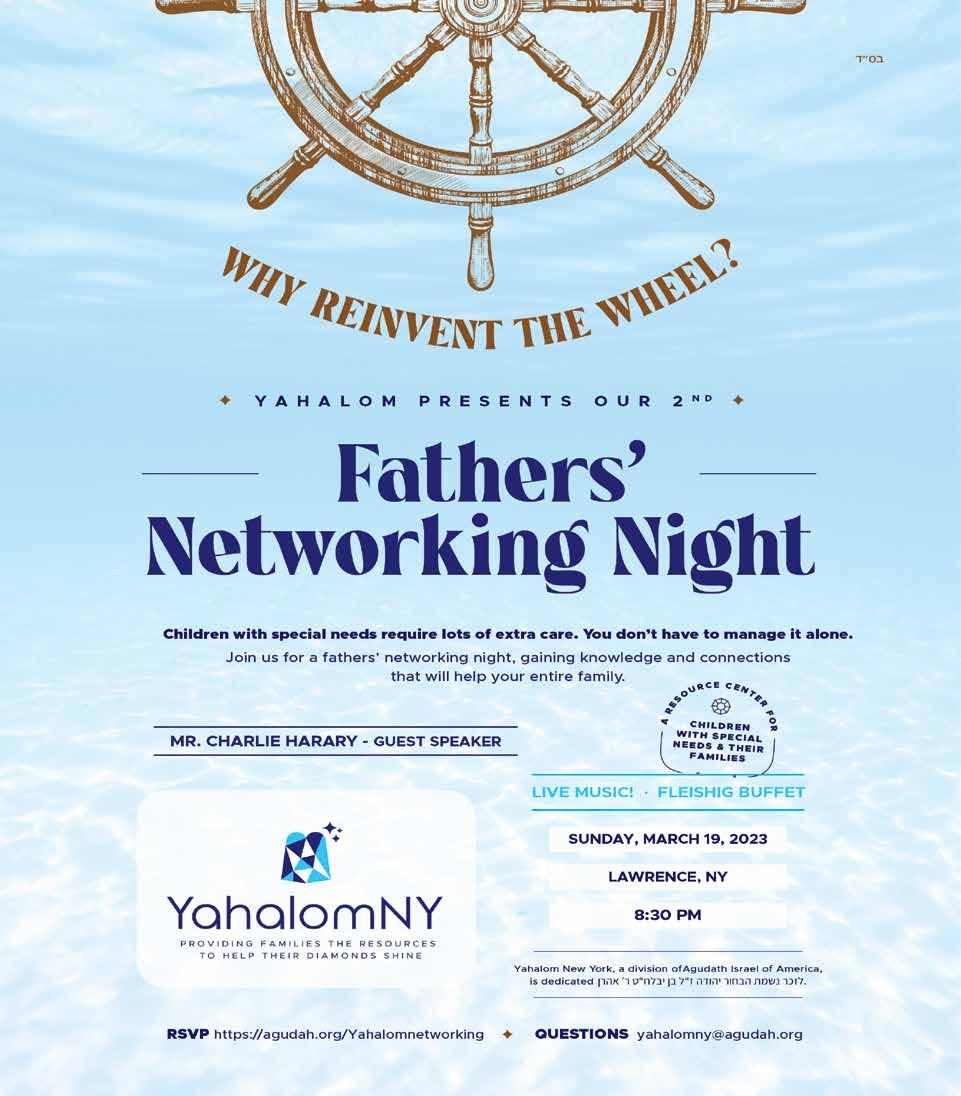
nounced it had sold a bunch of securities at a loss and that it would sell $2.25 billion in new shares to shore up its balance sheet. That triggered a panic among key venture capital firms, who reportedly advised companies to withdraw their money from the bank.
The company’s stock cratered on Thursday, dragging other banks down with it. By Friday morning, SVB’s shares were halted, and it had abandoned efforts to quickly raise capital or
find a buyer. Several other bank stocks were temporarily halted Friday, including First Republic, PacWest Bancorp, and Signature Bank.
The mid-morning timing of the FDIC’s takeover was noteworthy, as the agency typically waits until the market has closed to intervene.
“SVB’s condition deteriorated so quickly that it couldn’t last just five more hours,” wrote Better Markets CEO Dennis M. Kelleher. “That’s be -

cause its depositors were withdrawing their money so fast that the bank was insolvent, and an intraday closure was unavoidable due to a classic bank run.”
What led to the bank’s decline? It was partly due to the Federal Reserve aggressively raising interest rates over the past year.
tion, the value of those assets fell, leaving banks sitting on unrealized losses.
When interest rates were near zero, banks loaded up on long-dated, seemingly low-risk Treasuries. But as the Fed raises interest rates to fight infla -
Higher rates hit tech especially hard, undercutting the value of tech stocks and making it tough to raise funds. That prompted many tech firms to draw down the deposits they held at SVB to fund their operations.
Deputy Treasury Secretary Wally Adeyemo on Friday sought to reassure the panicked public about the health of the banking system after the sudden collapse of SVB.
“Federal regulators are paying attention to this particular financial institution and when we think about the broader financial system, we’re very confident in the ability and the resilience of the system,” Adeyemo said.
SVB was among the top 20 American commercial banks, with $209 billion in total assets at the end of last year, according to the FDIC. It’s the largest lender to fail since Washington Mutual collapsed in 2008.

This week, the Biden administration approved the Willow oil project, clearing the way for one of the largest new oil and gas developments on federal land in Alaska in 20 years despite fierce opposition from environmental activists. But in a nod to those who champion climate change, President Joe Biden also signaled future action to bar offshore drilling on 2.8 million acres in the Arctic Ocean.
The $8 billion Willow project, planned by Houston-based petroleum company ConocoPhillips, marks a shift in the Biden administration’s handling of major fossil fuel projects after approving few without con-


gressional or court intervention.

The Willow project is targeted for land within the National Petroleum Reserve-Alaska, an approximate 23-million-acre pristine area on the Beaufort Sea north of the Arctic Circle and about 200 miles west of existing oilfields at Prudhoe Bay.
ConocoPhillips proposed five drilling sites, three of which were approved. With the denial of the other two, the project was cut by about 40%. In return, the company agreed to relinquish 68,000 acres of existing leases in the National Petroleum reserve-Alaska, reducing its footprint in the reserve by one-third.
In anticipation of a backlash from climate activists, the Biden administration on Sunday proposed rules to block future oil and gas leases within more than 13 million acres of the National Petroleum Reserve-Alaska.
Alaska officials widely support the Willow project, which would bring an estimated 1,000 construction jobs and 400 permanent jobs to the state, while also ensuring the Trans-Alaska Pipeline System keeps operating. Oil revenues provide about one-third of the state’s annual budget and allow the state to provide an annual dividend to residents, set at $3,284 last year.
opened fire in a dance hall on January 21, killing 11 people and injuring nine others.
The United States faces more than 40,000 gun deaths each year.
A Reuters/Ipsos poll last year found 84% of respondents supported background checks for all firearms sales and 70% backed red flag laws. That survey was taken immediately after a gunman opened fire at a school in Uvalde, Texas, killing 19 students and two teachers.

ally licensed gun dealers to comply or educating others who may not realize they are required to run background checks under existing law, the White House said.

On Tuesday, President Joe Biden issued an executive order that reinforces background checks for gun buyers.
The order will also strengthen federal support for red flag laws intended to stop gun sales to people deemed dangerous that have been passed by 19 states and the District of Columbia.
Other aspects of Biden’s order would encourage the safe storage of guns and ask the Federal Trade Commission to analyze how gun manufacturers market firearms, including to minors.
Biden also met with gun violence victims who had been in the attack in Monterey Park, California, where a shooter
Some gun rights advocates oppose background checks, saying they infringe on constitutional rights to possess arms while failing to stop criminals from getting them. They also contend that many red flag laws trample on due process rights.
Biden’s order also proposes that the federal government respond to mass shootings in a coordinated fashion, similar to the way Washington reacts to a natural disaster, a senior aide said. Biden has asked his cabinet to develop a federal response that would provide trauma counseling or financial assistance, for example, to a community upended by a mass shooting.

The background check aspect to Biden’s order will be implemented to prevent felons or domestic abusers from buying guns, largely by leaning on feder-
On Tuesday, the U.S. Coast Guard in San Diego, California, called off its search for missing migrants after two smuggling boats were found capsized along the shore over the weekend. At least eight people have been confirmed dead in what officials called “one of the worst maritime smuggling tragedies” the city has seen amid a spike in human trafficking.
It is thought that one boat was carrying 15 people; the other boat was carrying eight. They were originally from
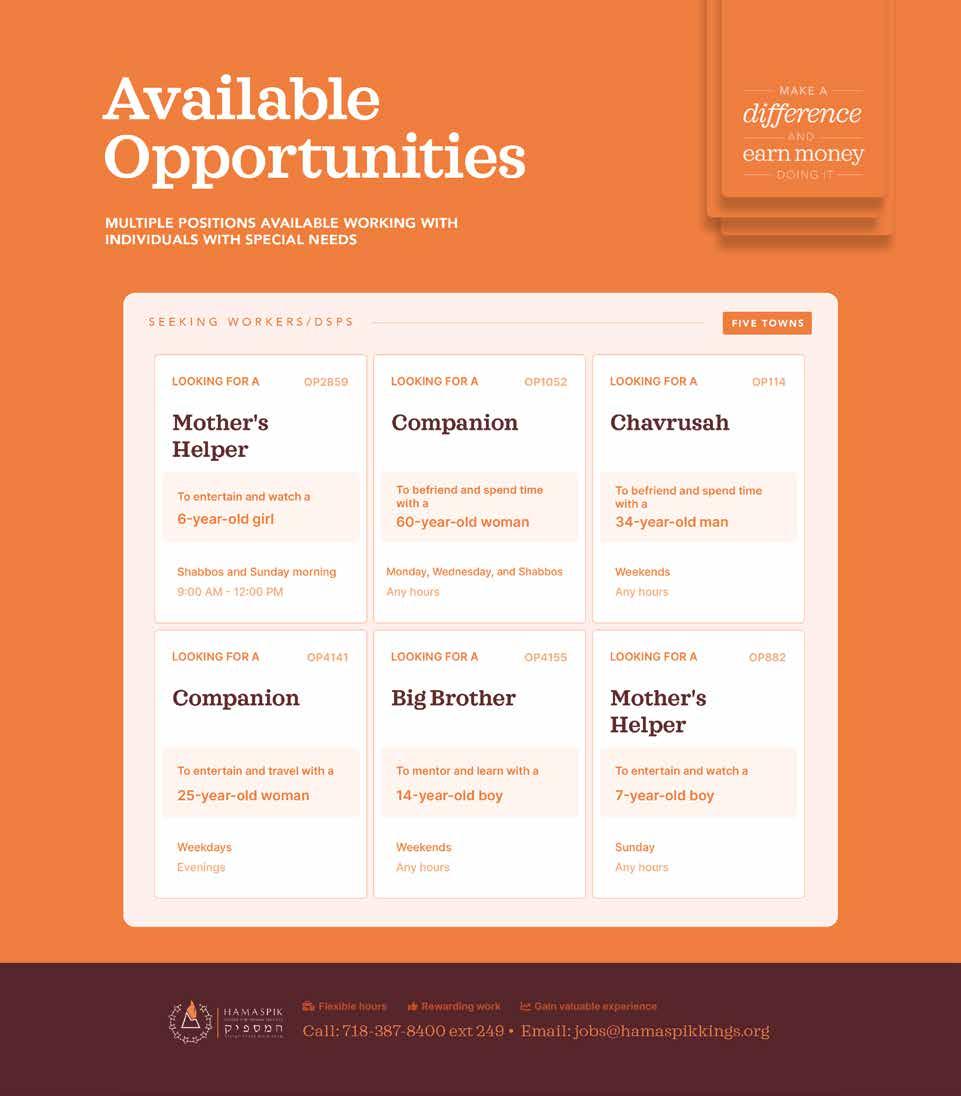
Mexico. None of the bodies found had on life jackets.
Although authorities have given few details about the passengers or their voyage, the incident marks another tragedy as human trafficking along the Southern California coast has spiked since 2017, said Capt. James Spitler, sector commander for the U.S. Coast Guard in San Diego.
“This is not necessarily people trying to find a better life,” he said, referring to boats transporting migrants. “This is part of a transnational criminal organization effort to smuggle people into the United States. These people are often labor-trafficked … when they arrive.”
Other deadly incidents involving suspected smuggling boats along San Diego’s coastline include the death of one person and the detention of at least 15 others after authorities rescued them in 2021 near Point Loma. At least three people also died that year after a suspected smuggling boat carrying 32 people overturned near Point Loma.

An estimated 50,000 Black people live in San Francisco, but it’s not clear how many of them would be eligible for financial reparations. The recommendations lay out a number of possible criteria, such as living in San Francisco during a certain time period and descending from someone incarcerated in the police war on drugs.

chelin-starred Spanish restaurant.
The heist took place back in 2021 and was planned in “minute detail,” officers said at the time of the offense.
A controversial draft reparations proposal that includes a $5 million lumpsum payment for each eligible Black person could make San Francisco the first major U.S. city to fund reparations.
Tuesday’s meeting of the San Francisco Board of Supervisors will include a presentation by San Francisco’s African American Reparations Advisory Committee, which released its draft report in December. The $5 million-per-person payment is among more than 100 recommendations ranging from offering grants to buy and maintain homes to exempting Black businesses from paying taxes.
Supervisors can vote to adopt all, none, or some of the recommendations and can change them.
Critics say the payouts make no sense in a state and city that never enslaved Black people. Generally, reparations opponents say taxpayers who were never slave owners should not have to pay money to people who were not enslaved.
Reparations advocates say that view ignores a wealth of data and documentation showing how even after U.S. slavery officially ended in 1865, government policies and practices worked to imprison Black people at higher rates, deny access to home and business loans, and restrict where they could work and live.
Eric McDonnell, chair of San Francisco’s African American Reparations Advisory Committee, said he’s disappointed by people who don’t understand the legacy of U.S. slavery and how structural racism reverberates through institutions today.
“There’s still a veiled perspective that, candidly, Black folks don’t deserve this,” he said. “The number itself, $5 million, is actually low when you consider the harm.”
Black residents once made up more than 13% of San Francisco’s population, but more than 50 years later, they account for less than 6% of the city’s residents — and 38% of the city’s homeless population.
The couple had visited the restaurant three times in the months preceding the robbery. On the night of the theft, the woman checked in to the adjacent Atrio small luxury hotel using a fake Swiss passport. Her husband did not check in.
Hours before the heist, they enjoyed a 14-course dinner at the restaurant, followed by a guided tour of the wine cellar.
At about 2 a.m. the woman called the front desk, requesting a salad from room service, and later a dessert. The clerk, who said he was alone at the hotel, finally agreed to the orders, leaving the front desk unmanned. It was during this time that the husband stole an electronic key from the front desk to open the wine cellar.
The couple left the hotel with the stolen bottles at about 5 a.m. They had wrapped the precious vintages in towels and shoved them into travel bags and drove off.
A few months later, in July 2022, they were arrested on the border of Montenegro and Croatia.
Police say that the wine is in the wind and have not been able to recover the special bottles.
The court sentenced the woman to four years in prison and the man to four-and-a-half years for armed robbery. It also ordered them to pay €753,000 in damages.
I’m sure they’re whining about that.
Forty-five bottles of wine is a lot –especially if you have to steal them.

A Mexican woman and her husband have been sentenced to four years in prison for stealing 45 bottles of wine worth $1.17 million from Atrio, a Mi -
As international and national fans tune in to the World Baseball Classic, they get to catch a glimpse into the cultures of players around the world.

Even so, Italy’s team took many by surprise when they heard that the dugout for the team came equipped with an espresso machine.
“We are kind of shocked, actually, because this is something in Italian culture that’s sort of like water. I mean, coffee

would be right after water,” Italy manager Mike Piazza explained.
Piazza is happy that he has his java but is not so pleased about the cup it’s being put in.
“I don’t like espresso out of a paper cup. It’s kind of sacrilege,” Piazza said. “But when it’s the only option you have, you have to deal with it. Maybe next time we’ll bring the metallic machine with the copper eagle on the top and someone in there knocking espressos out. You have to make the most with the tools you have.”
Andre Marcon, the president of the Italian Baseball Federation, is pleased with the exposure Italian baseball is getting — even if it’s for its coffee habits.
“Right now, we are the most followed national team for a series of things which took place connected to our ‘good old Italian customs,’” Marcon said.
How about some good, ol’ fashioned slices of pizza?
ing yummy taste.”
Micolino admits that many customers are staying away from the interesting item. But then there are those who can’t get enough of the cricket cuisine.
“Those who try it are very enthusiastic,” Micolino said. “I have customers who come here every day and buy a scoop.” Crunch.
I scream, you scream, we all scream when we see cricket ice cream.
Yup, you read that right. A German ice cream parlor now has an interesting offering on its menu: cricket-flavored scoops with dried brown crickets on top.
The Thomas Micolino store is known for its unusual selection of frozen confections. In the past, they’ve offered liver sausage and Gorgonzola cheese ice cream as well gold-plated ice cream for 4 euros ($4.25) per scoop.

“I am a very curious person and want to try everything,” Micolino told dpa. “I’ve eaten a lot of things, including a lot of strange things, and crickets were something I still wanted to try, also in the form of ice cream.”
A new European Union regulation allows for the use of the critters in food. Under the regulation, crickets may be frozen, dried, or used as a powder. The EU already allowed migratory locusts and flour beetle larvae as a food additive.
Micolino’s ice cream is made of cricket flour, heavy cream, vanilla extract, and honey, and he tops it with dried whole crickets. According to the store’s Instagram account, the dessert has a “surpris-
Dean Brown, a code enforcement official in North Carolina, had a scare this week when he inspected a home under construction.

When he made his way to the attic, the official saw a large figure at the side that he thought was a stuffed animal.
“I thought it was a stuffed animal that someone threw up there as a joke,” Brown told Fox 35 Orlando. “So, I just went about my inspection.”
But as he got closer to the figure, he realized that it was an 8-foot-long alligator and was very much alive. The reptile appeared to be sleeping, and Brown shined his flashlight over its face. It was then that the alligator opened his eyes wide.
“I was about two feet away from stepping on its head,” Brown shared with Fox 35.
Brown then ran to tell a group of workers who were eating lunch in a room nearby about his frightful discovery, but they laughed at him, thinking it was a joke.
“They laughed at me! They thought I was crazy,” Brown said.
But when the workers saw the alligator for themselves, they called 911. Animal control officials arrived to capture the large reptile.

“I thank G-d for keeping me safe,” Brown said. “This [is] a lesson to keep your doors closed and don’t feed the wildlife.”
And also a lesson that alligators know how to climb stairs…



Abig thank you to the amazing young rabbis and volunteers who read the Megillah over 150 times during the 24 hours of Purim for thousands of Five Towns residents! Here are some of the incredible Chabad of the Five Towns Purim numbers.

1,200 Mishloach manot distributed through Chabad!
300 Mishloach manot were hand delivered to Friendship Circle families and volunteers!
19 Expert Megillah readers!
112 Home and office Purim Megillah
readings!
47 Megillah readings at Chabad in 24 hours!
90 Public school kids heard Megillah at Cteen Parties!
4,500 people heard the Megillah with Chabad!

65 lbs. of hamantashen eaten!
12,000 homes received beautiful Purim magazines!
Over 100 Hebrew School students and their friends participated in the pre-Purim Hamantash Bake!


2 AWESOME Purim parties!


Congratulations to the HANC Girls’ Varsity Volleyball team and Coach Danielle Ben-Hamo ‘19 on winning the MYHSAL championship!
The Hurricanes had an unbelievable year
going 10-0 in the regular season and then defeating Maayanot, Ramaz and Frisch in the playoffs, winning an astounding 39 out of 45 sets this season.
With the coming expiration of the current lease at the site located at 270 Lawrence Avenue in Lawrence, the two respected organizations have come together in response to a Nassau County RFP for a new lease for the five-plus acre site. The site is to house the new Greater Five Towns Community Campus.
The new campus, once completely renovated by the JCC, will contain an updated gymnasium, new health and wellness center, an enhanced outdoor athletic complex and multi-purpose flexible meeting and event space. The current buildings will be completely renovated as well.
ized space and for the opportunity to collaborate with the Gural JCC.”
The Marion & Aaron Gural JCC, which operates three sites in the Five Towns, has long outgrown their main location at 207 Grove Avenue in Cedarhurst.
“The Gural JCC is in need of a larger footprint to meet the needs of the growing community” said Stacey Feldman, Executive Director of the JCC. “The additional space will enable us to expand our programs and services and become the full-service JCC that the community needs and wants,” Feldman added.
What do board games and books have in common? The fifth grade boys at YOSS can answer that question!

Last week, the Yeshiva of South Shore’s fifth graders had an incredible Game Day. Every boy in the fifth grade read an adventure novel and had to design a board game based off of the book they read. The creativity was incredible! Every board was colorful and care -



fully designed to include details from the adventure novels they read. Directions, game objectives, and pawns were produced, too! Some of the games were modeled after games the boys were already familiar with, while others were complete products of their imaginations. Spending the afternoon together as a cohesive grade reinforced the fifth graders sense of teamwork. What an adventurous project!
“Our proposal brings together two tenured and respected organizations that currently serve the greater Five Towns, who will collaborate and share one community campus. This ‘coming together’ of two unique social service organizations will only benefit the residents of the greater Five Towns,” said David Kaye, President of the Marion & Aaron Gural JCC.
Gwynn Campbell, President of the Five Towns Community Center and lifelong Five Towns resident, is excited for what the future holds. “We were devastated when we found out that our lease would not be renewed. Everyone at the Five Towns Community Center is excited that we’ll be able to serve the community from our newly renovated and modern-
“The plan is to provide the Five Towns Community Center with beautifully renovated space to accommodate its services and programming, and to continue to operate independently. The Community Center will have its own main entrance and lobby, an enhanced gym and newly renovated space enabling it to continue to provide critical programs and services to the community. My Board and I are proud to support this proposal to enhance the lives of all residents of the Five Towns,” said Cal Nathan, President of the Community Chest of the South Shore.
The Marion & Aaron Gural JCC has committed a minimum of $7 million dollars to the project.
For further inquiries, please contact Stacey Feldman, Executive Director, The Marion & Aaron Gural JCC at 516-5696733 or stacey.feldman@guraljcc.org.

At last week’s parlor meeting to build out the Special Children’s Center’s new home in the Five Towns
As we reflect on the first yahrzeit of Rav Chaim, zt”l, we are so inspired by his gadlus in Torah, tefillah, and love for every single Jew. His humble home in Bnei Brak became a magnet for all Yidden across the globe, and his unwavering commitment to limud haTorah continues to inspire young and old!
This past week, YOSS Mechina talmidim were fortunate to hear divrei zikaron from HaRav Aharon Pessin, a close talmid of Rav Chaim, zt”l. Rabbi Pessin described the true impact of a tzaddik, and the reason why we must be mechazeik ourselves now that he is no longer here. He told personal stories of Rav Chaim’s gadlus in Torah and endless drive to learn. He highlighted Rav
Chaim’s love and concern for every Jew and the incredible humility that defined him. Rav Chaim was a living Sefer Torah and inspired all who came in contact with him to strive for more!

Rabbi Pessin shared that Rav Chaim believed that everyone had the capacity to become a gadol baTorah. He related that
one day a young boy asked Rav Chaim for a bracha that he become a talmid chacham. Rav Chaim answered him by saying, “If you want, you will be!” It was a real chizuk for that child, and Rabbi Pessin said that it should become our slogan for life!
After he spoke, Rabbi Pessin spent

The students of Bais Yaakov Ateres Miriam High School arrived at school, Monday, Rosh Chodesh Adar, with the hallways covered in smiley faces posters, each indicating “Mi’she’nichnas Adar…marbin b’simcha!” The girls then proceeded to Shacharis, followed by Hallel and Mussaf, indicating the special Rosh Chodesh Day.
They next joined with G.O. Coordinator, Ms. Hodaya Kuighadoush, for a delicious breakfast of fresh bagels, spreads and treats baked by Mrs. Sokoloff, their principal. Staff member Mrs. Elisheva Shapiro honored us all with a heartfelt dvar Torah, in which she highlighted the importance of Rosh Chodesh for women and the special month of Adar.
This was followed by personal invitations to BYAM HS gala Purim Chagiga. Our theme, “Meihodu V’ad Kush,” was introduced as “Around the World of Pu-
rim.” Each student chose a country to represent via costume.
On Thursday evening, March 2, the lunchroom in our school building was transformed into an oasis of virtually every country on the globe. All staff (and their children) were invited to partake in our “international” refreshments, including a Chinese dinner and Italian ices for dessert.

The program began with a hilarious spoof (Mrs. Sokoloff, via video, dressed up as a queen, greeting her “subjects.”) Her “royal greetings” opened the evening of fabulous costumes and fun. Mrs. Yonina Blassberger, staff member, was the evening’s speaker who spoke eloquently on the topic of “hester panim,” the hidden nes of Purim.
The evening was fun-filled, with a trivia game (based on a teachers’ survey), music and dancing. As one staff
member commented, “You could feel the simcha in the room!” Special shout-out to the joint efforts of Miss Kuighadoush, and our Chagiga heads: Chana Pantiliat, Yael Hasgall and Shulamis Mann.


What’s ahead at BYAM HS? With a
time speaking with talmidim, answering shailos, and giving brachos. It was a powerful and inspirational program that gave the boys a window into Rav Chaim’s world and will allow them to continue to connect to the eternal legacy of Ram Chaim, zt”l.
thought-provoking Yom Iyun prior to Pesach, and finishing touches being applied to our very own 9th grade Haggadah Divrei Torah publication, BYAM HS truly enriches every facet of our students’ school experience.
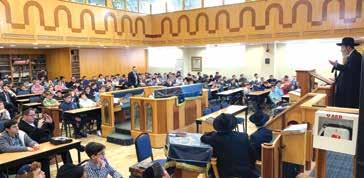


Purim is a time of joy and celebration, and nowhere is this more evident than at the annual DRS Purim Chagigah. The event welcomes students, parents, and community members for an evening of fun, excitement, and inspiration.

The night began with Megillah reading led by Rabbi Kaminetsky in DRS’s beautiful Beit Medrash. The reading was followed by a break-fast meal in the gym and a siyum made by students who completed Masechtos this year. It was inspiring to see high school students accept this great project upon themselves in honor of the holiday and celebrate the fact that the Jews at that time willingly re-accepted the Torah.
As the night progressed, DRS students and rabbeim, decked out in Purim costume, danced for hours to the lively music of Neshoma Orchestra. The energy
in the room was infectious, and everyone was swept up in the excitement of the celebration.
Following the dancing, everyone enjoyed the annual Student-created comedy videos, and a comedy performance of “DRSNEWS” by some of the DRS rabbeim. The night faded away as the student body burst into

laughter.
The annual DRS Purim Chagigah is a highlight of the year, and it’s not hard to see why. The event brings together the entire community in a spirit of joy and celebration, and everyone leaves feeling uplifted and inspired.


The 11th season of the FM Home Loans 5 Towns Flag Football League is underway. This season, we have over 35 teams playing with the Pre-1A division run by Rabbi Jeremy Fine. We are so excited for this season as it is promising to be action packed with so much competition in every division. Each week, we hope to print a weekly recap of the games played in this paper, with highlights and updates from each division.
This season, we are fortunate to have
The transition into spring coincides with an exciting time at Central, which includes Purim, Pesach, Senior Seminar, and all of the high-energy programming marking the months leading to the school year’s end. Students look forward to Purim, in particular, and Central celebrated with festivities throughout the entire month of Adar.
Last week, the school combined fun with chesed in hosting this year’s Disney-themed Yachad carnival, held for the benefit of students from Ivdu Elementary School for Girls. Seniors spent the week before Purim celebrating with themed


so many great sponsors. The league sponsor is FM Home Loans who will also be sponsoring sublimated flag football sweatshirts for every participant. Our other team sponsors are Gourmet Glatt, S. Adelsberg Accounting, Maidenbaum Tax Reduction, Holy Schnitzel, Moshe Warsawsky Entertainment, Mr. Softee, Vogue Optical, Fialkoffs Pizza, and Avid Homes.
The schedules and teams have been posted on 5townsflagfootball. com, and the staff and officials have been
assigned their jobs and now we are just waiting for opening day. We can’t wait to greet all of you on kickoff day. Iy”H, it will
be a safe, healthy, and fair season. Check back shortly for updates throughout the season, as this season will be special!
dress-up days, including “dress like a celebrity” day and, most notably, “dress like a teacher” day – excellent preludes to this week’s parade of fashion. Central students have always embraced the traditional Purim custom of costumes, with many students planning their outfits for dress-up days months in advance.
On Wednesday, March 8, the school featured a special Shushan Purim schedule, and a flood of aliens, angels, cows, one giant shark, an enormous T-rex, one walking Twizzler, Bob the Builder, Morticia Addams, the entire cast of the 1985 movie Clue, and one student riding to

classes atop a giant inflatable flamingo came to celebrate. The day’s highlights included a chagiga with Azamra DJ, a senior game of panoply, and, of course, Central’s legendary Purim shpiels, featuring a senior-made production exploring life at Central (notable points: Central trivia, including pressing questions like: “How many times has Ms. Konzack’s class fish been replaced?” and “Name that Famous Past Central Faculty”), as well as a faculty versus students generation game. As always, the events were a hit.
And it doesn’t stop there – upcoming events include the junior Shabbaton,

the spring musical, field trips, and much more.



If you have a current estate plan, I’ll bet you plan to leave your assets to your children outright and unprotected by age 35, or maybe a little later. Go take a look at your estate plan, and see what it does right now. And, if you don’t have an estate plan, and you have children or other people you care about, contact us today and let’s get that handled for you.
If you do have a plan and it distributes your assets outright to your kids – even in stages, over time, some at 25, then half of what’s left at 30, and balance at 35 (or something along those lines) – you’ve overlooked an incredibly valuable gift you can give your children (and the rest of your offspring for generations); a gift that only you can give them. And a gift that, once you’ve died and left them their inheritance outright, is lost and cannot be reclaimed.
Leave your kids a nest egg protected from lawsuits, divorce, and estate taxes.
You may think your children’s inheritance doesn’t need to be protected and can’t ever imagine them getting sued. You may be right, but you may also be overlooking one of the most common “lawsuits” that causes inheritances to be lost every day, and that’s divorce. If you want to protect the money you are leaving
to your children from their future divorces, even if you love their spouses, you can easily do so using a protected trust.
And, if your child is ever involved in a lawsuit, for example, a simple car accident, or if a business transaction goes bad, what you leave to your child can be protected from all future lawsuits or claims against them.
The best part is that if your child has their own taxable estate when they die, your planning now could save your family 40 cents on every dollar (or more) handed down from one generation to the next. As of 2023, the current federal estate tax rate is 40% -- meaning that every dollar passed on over the estate tax exemption rate is taxed at 40%. And it has been as high as 55%. On top of that, many states have estate taxes as well.
This all adds up fast and can decimate your family’s inheritance, over time. For every million dollars you leave outright to your children, if your children have a taxable estate when they die, could result in your grandchildren receiving only $550,000, with $450,000 going to the government ... unnecessarily.
So, if you want to know that everything you’ve worked so hard to create will stay in your family for generations to come and not be lost to outsiders, leaving your assets to your children protected in a trust we call a Lifetime Asset Protection Trust instead of outright is the way to go.
And, it can be easily built into your existing estate plan or trust – you just need to ask us to include it in your plan.
But how will my kids get to use what I leave to them?
Here’s the best part about leaving your assets to your children in a Lifetime Asset Protection Trust. Not only is what you leave protected, but your children control what you leave them when you decide they are ready. You can decide when your child is mature enough to act as a Trustee.
After your death, the assets you leave behind will pass to your children (and your grandchildren, great-grandchildren, and so on for successive generations) in a Trust that your child can control, as the Trustee of the Trust.
As the Trustee of the Trust, your child decides how what you’ve left is invested and what to do with the Trust assets. And your child will even be able to determine the amount of control vs. the amount of asset protection he or she wants based on his or her specific circumstances.
Is this still important if I don’t have much money?
If you only leave your children a small amount of money, this is still incredibly valuable for protection, if you are leaving assets that will be invested and grown and not just spent right away on con-
sumables. Some might say it’s even more important because your family has less to lose to taxes, lawsuits, and divorce each generation. And the impact of such losses is much greater.
Imagine that you leave just $10,000 to your child in a Lifetime Asset Protection Trust, and instead of spending that $10,000 or losing it in a divorce, they invest that $10,000 in creating their own business inside their trust, and then grow that business into a million dollar or multi-million dollar venture because of how you chose to leave your child that $10,000 gift … and it’s fully protected for generations.
Secure the future of your family today by speaking to us. We review estate plans and inherited funds with you, ensuring that all legalities are in place so generations can enjoy the benefits according to your wishes. Don’t wait, get peace of mind now; contact us today to get started.
Monet Binder, Esq., has her practice in Queens and Brooklyn, New York, dedicated to protecting families, their legacies, and values. All halachic documents are approved by the Bais Havaad Halacha Center in Lakewood, under the direction of Rabbi Dovid Grossman and the guidance of Harav Shmuel Kaminetsky, shlita, as well as other leading halachic authorities.



HAFTR High School spent an entire week focusing on students’ well-being during our annual Health Week. Beginning on Monday, February 13, and concluding on Friday, February 17, students participated in informative programs and activities that raised awareness of their overall emotional and physical health.
Students had opportunities to learn and experience health in many different forms. On Monday, students wore green to raise awareness of mental health. During their first period classes, the

On February 16, the Middle School held a special edition of the new TNL – Thursday Night Learning program. This time, it was not only for the boys, but it was also for their fathers/ grandfathers/special persons. It was a success with close to 90 people attending the event.
The evening started with a delicious buffet from Sauly’s that included garlic knots, pasta, pizza, salad and French fries. The food was plentiful and delicious. Next, Rabbi Hecht gave out source sheets. The topic of the night was: Is the Torah given on a silver platter or do we need to work for it? It was beautiful seeing the different generations work together and learn in such a meaningful way. It was also a great opportunity for
entire school joined together on Zoom and played a very informative and fun Kahoot, which asked questions pertaining to mental health. On Tuesday, junior and senior boys were privileged to hear words from Mr. Ike Dweck, who empha-
the adults to get a taste of our great learning. Next, Rabbi Hecht gave a short, interactive shiur which brought all of the sources together. The evening concluded with benching and Maariv. On the way out, all of the adults received a babka for Shabbat.
A very special thank you to Mrs. Aryana Ritholtz, Community Outreach Manager, for coordinating the program. A big yashar koach to the evening’s sponsors: Eric Ehrenhaus, in memory of Noah’s grandfather, Nachman Yosef Ben Avraham Menachem Mendel, on his upcoming first yahrtzeit, and Mordy Hackel, l’ilui nishmat Dr. Benny Kraut z”l, Yair Holtzman, Matt Lerner, Yitzy Ritter and David Wayne.
sized the importance of healthy behaviors and guarding against addiction. On Wednesday, HAFTR had the opportunity to participate in Sharsheret Pink Day. Mrs. Riva Goldschmiedt, a HAFTR parent and breast cancer survivor, was the keynote speaker on behalf of Sharsheret, a nonprofit organization that supports Jewish women diagnosed with breast cancer and ovarian cancer. Mrs. Goldschmiedt recounted her experience with students and shared an uplifting message of positivity and faith. Students came to school in their pink outfits in recognition of breast cancer awareness. They sold raffle tickets, doughnuts, apparel, pink

lemonade, and even potato kugel to raise money for Sharsheret.
In addition, throughout the week, students were encouraged to participate in a HAFTR Guinness World Records tournament, where they tried to set and beat records by doing physical activities in gym classes. Thursday was dedicated to self-care. Sophomore girls had the opportunity to hear from Mrs. Gila Glassberg, a dietician, to learn about healthy eating habits. The entire school then participated in a gratitude challenge by writing thank you letters to someone else. On Friday, the week culminated with students discussing these ideas in their health classes.
Throughout the week, HAFTR High School students were able to learn about mental health, raise awareness and money for a cause, participate in physical challenges, and learn how to take care of themselves. It was a unique and special experience where students learned lessons for their lives today as well as in the future.






Over 150 community members from Old Woodmere and Hewlett Neck participated in the first

Purim celebration with Chabad of Hewlett Neck and Old Woodmere and Rabbi Mendle and Goldie Gordon at Woodmere
Lanes complete with a delicious dinner, bowling, entertainment and megillah!


More information about Chabad HNOW can be found at ChabadHNOW.org










MTA talmidim have the unique opportunity to come to yeshiva for a night of revelry and fun following megillah reading and an incredible break-fast. First, MTA talmidim enjoy a chagigah in the MTA gym, where they can dance with friends and rebbeim while getting into the spirit of Purim. After the high school chagiga has concluded, MTA talmidim, along with their rebbeim, make their way over to the Max Stern Athletic Center for the annual Yeshiva University Purim Chagiga. The

YU Pruim Chagiga is renowned for its lively atmosphere, and MTA talmidim are privileged to participate. While the music and dancing are enough of a draw, the opportunity to celebrate Purim with the Roshei Yeshiva of YU makes this opportunity particularly special.


The celebration did not end after the Chagigas had concluded. On Purim day, talmidim visited their rebbeim, delivering mishloach manot and sharing in the simcha of Purim with their rebbeim.

This past week, in preparation for Purim, the world famous singer Yaakov Shwekey, made a surprise visit to Mesivta Netzach HaTorah in Woodmere. Following the end of the school day, and just before Mishmar was set to begin, the Menahel, Rabbi Yitzchok Yurman, called the boys down for a special address, at which Yaakov Shwekey entered the room to the excite -
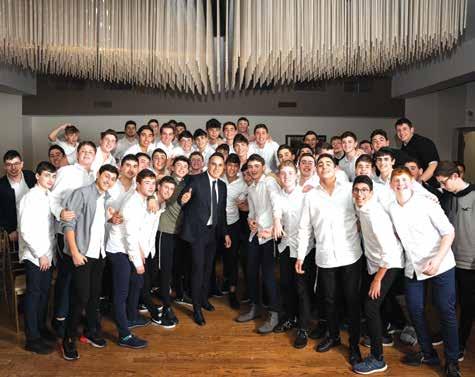
ment and surprise of everyone. Yaakov sang his new song in memory of Rabbi Zlotowitz, with the words expressing the importance of talmud Torah and sincere connection to Hashem. The singer then shared some words of inspiration and insight into the Megillah and Purim, after which the rebbeim and talmidim danced together, closing out a beautiful surprise event to get everyone in the Purim spirit!

This year’s Middle School Shabbaton was amazing. The excitement while the students were boarding the buses was palpable. The first stop was bowling. Students enjoyed the bowling and the arcade cards as well. Next stop was the beautiful Holiday Inn in Piscataway, NJ. Once we arrived, the students filed in with all of their belongings. The rooms were given out, and students had time to relax and prepare for Shabbat.
The davening on Friday night was beautiful, especially singing Yedid Nefesh and Lecha Dodi. The Friday night meal was delicious. In fact, the food throughout the weekend was excellent. A big kudos to Shloime Meisner and Meisner’s catering. After the meal, the boys had an activity called Join The Party and the girls had an activity called Shmooze. Both of these activities had
their more serious moments and their more humorous ones. The night concluded with a delicious oneg filled with singing and stories.
Shabbat day included davening, kiddush, the meal and a fantastic game of Family Feud - HANC Style with questions like what is the most popular snack in the vending machine and which teachers went to HANC. Shabbat concluded with a beautiful Havdalah.
The night activity had two parts to it. There was separate swimming and the Happy and Hilarious Challenge. Sunday morning included davening and a delicious breakfast. The students arrived back at school happy after an incredible weekend. A big thank you to all of the faculty members, their families, and the chaperones who helped make the Shabbaton such a great success.
 By Rachel Sales
By Rachel Sales
North Shore Hebrew Academy
High School took home the most awards at the Annual Yeshiva Model Congress Tournament this past week at HAFTR, with students arguing eloquently about pressing issues in today’s society. Model Congress gives students an opportunity to understand how the U.S. Congress functions by role-playing simulations, including writing bills to present and defend in committees. Students are also assigned to committees as delegates and must strategize how to get the votes needed to pass their bills. Under the guidance of dedicated faculty advisors Dr. Victoria Allen and Ms. Estee Bodner, the team had an impressive showing at this year's competition.
More than 200 students from 17 schools competed in last week’s tournament, on topics ranging from closing


private prisons, allocating more federal funding to protect consumers’ data, creating more effective suicide prevention programs for veterans, developing a national service program, and discontinuing the use of the penny.
NSHAHS students took home 11 awards, including Ilana Greenberg, who placed third overall with her bill to regulate air traffic in order to reduce the impact of non-CO2 aviation emissions. Other students who received first or second places in their respective committees included Jordana B., Chloe Mastour, Elizabeth Mirharoon, Mayah Rosenzweig, Abby Rutta, and Ryan Winkler.
“Model Congress helps students sharpen their research and debate skills and also enables them to develop an expertise in a specific topic of their interest,” said Dr. Victoria Allen. “Students can be creative and write about issues that really concern them. We are so proud of them!”

Over two hundred families in the greater Five Towns area were delighted to receive their custom Purim gifts – a music speaker with attached microphone and a USB loaded with hours of lively music. The gifts were beautifully packaged together with a mishloach manos that included an assortment of goodies, a box of hamantashen, and some crafts. The packages were either delivered to each client’s door, or if clients preferred (for privacy’s sake), picked up from the local Hamaspik headquarters, located on Columbia Avenue in Cedarhurst.
This thought-out gift was uniquely suited for the Hamaspik clients, who were transformed into celebrities as they pranced around on Purim, holding their
The JSL 2023 Winter Playoffs by FM Home Loans are well underway with some exciting finishes!
The basketball teams have completed their semifinal games, and the hockey teams have finished the first round of the playoffs. The NY Rangers generously provided swag to the league, and we also gave gifts to our incredible coaches. We are eagerly anticipating the championship games, which will take place this coming Sunday and Monday.
JSL Juniors
K/P Hockey: Ezra Gruen scored a game-winning goal with just 2 minutes left on the clock, leading Arg to a 2-1 victory over Simcha Day Camp. Meanwhile, Gourmet Glatt jumped out to an early 2-0 lead against Home and Stone, but the latter team managed to tie it up in the second half. In an epic comeback, Home and Stone then scored two straight goals in the final minute to secure a thrilling 4-3 win, with MVP Dovid Levitan netting the game-winner.
K/P Soccer: Shua Sod was on fire, making an incredible 15 saves to lead Future Care to a 4-1 victory over ARG.
1st Hockey: 1st Grade started their end of season tournament on Sunday. 4 Seasons had a 2 goal lead for the majority of the game when Yumi Ehrlichman tied it at 4 and Mordechai Kirchner scored the go-ahead goal and an insurance goal for ARG, which gave them the win 6 to 4 and a spot in the Championship game
music speakers and singing merrily into the microphone.
Tens of heartwarming pictures and messages were received by the Hamaspik coordinators after Purim, and demonstrated how perfect the gift was:


“We really enjoyed the Purim speakers! We played music across the house. It was so cute. My son held the mic, and he kept calling people to come take a turn to sing. It was so helpful and a great idea,” said one mother.
Hamaspik, Comfort Health, Integrated Health, Milestones, and the rest of the Hamaspik Kings brands were happy to be able to inject some more joy into this most joyous day of the year.
next Sunday. Island roofing got out to an early 5 to 2 lead. However, Built by Nate scored 2 goals but was Island Roofing held strong and will play ARG in the Championship game.
It was the Semi-Finals on Sunday, and the boys were ready to play.
3rd/4th: Uriel Cohen had an establishing 6 points for Maidenbaum who won the consolation game. Shlomo Licht’s pump fake and step-through layup proved to be the difference-maker as Island Roofing defeated Arg 11-9, and Noam Rosman’s phenomenal put-back sealed the deal for Built by Nate in their 22-8 win over Town Appliance. Built By Nate will play Island Roofing in the Championship game on Sunday.
5th-7th Basketball: Yoni Schaffran continued his incredible season with a tremendous performance in the Semi-Final round against Maidenbaum and what a game it was. The game went back &
forth with Maidenbaum ultimately being able to hold on 26-24 and move on to the Championship round where they will play against a fierce Five Towns Orthodontics team who dominated Extreme Vent Cleaning. Aden Carucci’s had the play of the day with a wicked and-one for 5 Town Orthodontics.
The 2nd-8th Hockey leagues began the playoffs this past Sunday with some incredible games.
2nd/3rd: Tani Polansky was like a brick wall in net for MoldPro putting on a clutch shutout performance as MoldPro won 3-0 over Alpert Financial and advanced to the next round. Elegant Lawns & 925 Sterling played a hard-fought game. The game was tied as it headed into the 3rd period when Dovid Schwadel scored his 3 goal of the game to give Elegant Lawns the 4-3 victory.
4th/5th Hockey: Marciano came out guns blazing, taking a commanding
2-0 lead early on. But 925 Sterling had other plans, staging a remarkable comeback to tie the game in the second period. The game was tied up in the third period until 925 Sterling went on a scoring spree, putting them ahead with just three minutes to go. They held on to clinch a sensational 4-3 win over Marciano, who fought valiantly until the end. Meanwhile, Auto Click put on a dazzling display of offensive firepower, defeating Posh Home + Bath 7-2 to book their spot in the next round.
6th/8th Hockey: 6th-8th Hockey was off this week as they gear up for the Semi-Final games this Sunday.
It was game two of the Spring Season this past Sunday. Team ARG exploded for 72 points with over 20 points from the talented Jeremy Brody. The young phenom Simcha Klien dropped a pair of 3s in the 2nd half in Westwood Realty’s win and Nussie Felder went off in the 2nd half to help his team pull away from Stone Group. Shelby Rosenberg was awarded the Fall 2022 MVP and then went on to have another dominant performance in John’s Automotive wins over a talented Built By Nate squad.
Game MVPS: Ezra Gruen, Dovid Krigsman, Ezra Rosman, Shlomo Licht, Tani Polanski , Noam Rosman, Eliyahu Ruzorsky, Zachary Obadiah , Shmuel Zidele, Jack Spector, Chaim Weinberger , Jake Ruvel, and Dovid Levitan


How Long Have You Lived In The Village of Cedarhurst?
What is Your Profession?
I have lived in the Village of Cedarhurst for 25 years with my wife. We have proudly raised two children in this community. I am Chairman and CEO of New York Automotive and Diesel Institute - The College of Transportation Technology located in Jamaica, Queens.
What Have You Accomplished Professionally and Personally?
For 26 years, I served as a member of the Advisory Council for Licensed Private Career Schools. During the last 12 years, I was appointed Chairman by three different Governors. The Council came into Education Law in 1990 and can be found in Section 5010 Education Law. I have also been a member of a Regents Advisory Council for access to higher education for students with disabilities. I am currently serving my 4th term as an elected official, in our community, on the Lawrence School Board. As a Cedarhurst resident and ad-
vocate, I recently became active in opposing the Use Variance application by Maximillian Holding, who wanted to build 17 two-bedroom two-bath apartments on a lot zoned for a one family home on Washington Avenue. This property is diagonally across the street from the Lawrence-Cedarhurst Fire Department and directly across from HAFTR Elementary and Pre-School. I advertised in the community and asked the community whether this was a good idea for the project on Washington Avenue, and 224 members of our community replied that they were strongly opposed. And this use variance application was unanimously denied, by the Cedarhurst Zoning Board, on Feb 14, 2023. Your voices were heard!
Why Do You Want to be a Village of Cedarhurst Trustee?
I want to be a Village of Cedarhurst Trustee so I can bring my years of experience, and knowledge to village leadership. To represent the community with full transparency. I will listen to your concerns and represent you in the
boardroom.
What Is Your Campaign Platform?
Stop Over-development. Abide by the mission statement of the Cedarhurst Zoning Board.
Improve safety and security. Transparency in our village government. All Board meeting minutes will be posted on the village website.
What are Your Goals as a Trustee?
I want to represent the interests of the residents and listen to them. I want to improve safety and security in the Village of Cedarhurst. Security cameras in our village would be an important start, as well as improving traffic flow. Right now, a priority is to stop over-development. We can’t afford surprise developments in our community. Look at what’s happening by the Lawrence Woodmere Academy, right now (Woodmere Blvd and West Broadway). Neighbors were in shock to discover the building of 17 homes. I would strive for
inter-village and Town of Hempstead communication regarding development and projects going forward.
Cedarhurst Residents?

I would make myself available to the Cedarhurst residents via email and telephone. The Village of Cedarhurst should have a user-friendly website that also posts the meeting minutes of all Board meetings. I would also encourage the creation of a Cedarhurst Homeowners Association.
Regarding Governor Hocul’s High Density Housing Plan for Long Island?
Say “NO” to her plan to urbanize our suburbs by calling Governor Hocul’s office at (518) 474-8390 to voice your objection. There is also a petition on change.org “Stop Kathy Hocul’s Expanded Urbanization Plan!” for all to sign.

On Wednesday evening, March 1, the Sands in Atlantic Beach became a historical landmark as TAG celebrated its 60th year of achievement in providing a Bais Yaakov chinuch for six generations of young ladies. The more than one thousand attendees were mesmerized by the many displays depicting a kaleidoscope of world events that coincided with milestone accomplishments at TAG fused together with a table that was bedecked with delicacies that were inspired from that era as well.

While TAG itself was indeed the honoree, the moving tribute to the “Mother of TAG,” Rebbetzin Toby Weitman, a”h, provided an extra layer of meaning to the whole event. She was interwoven in TAG’s success in every way and was a role model
for all the talmidos, faculty, and the entire community at large. All who left the dinner were inspired by the Rebbetzin’s life and vast accomplishments. May this tribute serve as a merit for her lofty neshama.
Rabbi Yehuda Deutsch lent his creative abilities to many aspects of the dinner. Mrs. Soshie Hirth worked tirelessly to assist Mint Media in producing the moving and beautiful videos. Rabbi Baruch Lovett was on “call” both day and night ensuring the financial success of the dinner. Mrs. Malky Klein, Rabbi Lovett’s administrative assistant, kept everyone on target and did the essential record keeping, while sharing her ideas about the focus of the dinner. Rabbi Moshe Zimberg spent hours calling for reservations and managed an entire team
of volunteers who did an amazing job. Of course, Rabbi Meyer Weitman was at the helm as always doing his part to make the dinner both profitable and meaningful event.
The evening’s musical performer, Baruch Levine accompanied by Aryeh Kunstler’s strings quartet, was an added attraction and the two beautiful songs he sang, with lyrics by Machon Sarah High School’s own Morah Evalee Gross, depicted TAG’s journey to this milestone, as well as a musical tribute to the life of Rebbetzin Weitman, a”h.
Many thanks to our dinner chairmen, Mr. Gadi Fuchs, Mr. Dovid Gamzeh, and Mr. Akiva Glazer and the Journal Chairmen, Mr. Yitzi Gross and Dr. Ernest Isaacson, and the entire dinner committee.
Their active involvement in so many aspects of the dinner was the catalyst for its success.
Special hakaras hatov to the corporate sponsors: Stone Group Gourmet Glatt, Safra Judaica, Lightwater Capital, Moish Warsh D.J., and Blaivais Associates. TAG is truly grateful to all its supporters and was gratified that this was its most successful dinner to date.
The success of the dinner galvanizes TAG, who played such a pivotal role in the development of the community, to stay at the forefront in chinuch habanos and continue to produce, b’ezras Hashem, the high caliber Bais Yaakov girl that is the hallmark of a TAG talmidah.
For the first time since the store opened in 2018, KolSave Market has set up its Kosher l’Pesach grocery section in a large warehouse space that opens up at the rear end of the store. Boasting nine-footwide aisles and an extensive selection of basic and specialty Pesach products, the newly situated section offers customers a simpler and more comfortable shopping experience.
But store manager Mendy Herz observes that the advantages of a specially designated Pesach area don’t end there.
“Having our Pesach products in a single, separate space allows us to keep our chometz shelves stocked and accessible until right before Yom Tov,” he said.
For families with hungry kids who

want their morning cereal, he jokes, that’s a pretty big deal.
A price- and value-centered kosher superstore, KolSave Market draws Pesach and year-round shoppers from throughout the Five Towns/Far Rockaway area, Queens, Brooklyn, and even as far away as Westchester.


“We’re always working to provide our loyal customers with the best possible shopping experience,” says Mendy, “and we think the new Pesach section helps accomplish that goal.”
For special sales and expanded Pesach shopping hours, go to www.kolsavemarket.com.







The children in HANC’s Elementary School in West Hempstead have had a very eventful week with programming that ranged from STEM experiments, vocabulary exploration, and a Purim carnival. The fourth grade students, under the leadership of HANC’s science teacher Mr. Jonathan Eisenkraft chose a topic of interest to them and following the scientific method, designed their own experiments and recorded the data. The creative students explored topics that ranged from experiments with bubble gum, slime and eggs, to bearded dragons and guinea pigs. Each student then created a trifold display that explained their hypothesis, steps of the experiment, data that they collected, and conclusions based on their data.
On the day of the Science Expo, the auditorium was transformed into a world of discovery where the fourth graders
shared their knowledge with second, third and fifth graders, as well as with parents who came to visit in the evening. This year’s Science Expo was bigger and better than ever and the children were commended on all of the hard work they put in at home to create such extraordinary exhibits.
In honor of Reading Appreciation Day, the Kindergarten through third graders took part in the HANC Vocabulary Parade. Inspired by the book, The Word Collector by Peter H. Reynolds, each child dressed up depicting a word of their choice.
With extraordinary creativity, the children depicted words such as: blossom, emotional, smitten, absorbent, moderation, and mimic, just to name a few. The excitement could be felt as the children marched out of the school and turned toward Collins Avenue. To their
great surprise, all along the parade route, parents and grandparents were lined up in the street to cheer them on and to marvel at the creative costumes. When the parading students returned to the back playground, they were surprised again to see the fifth and sixth graders cheering for them as they concluded their tour and returned to the school building. The children were so proud, and the adoring fans made them feel so special.
Shushan Purim was a day of pure delight! All of the students and staff came dressed up in costumes, which created a fun atmosphere all day long. As the children entered the school, festive Purim music was playing in the lobby. In addition to fun filled Purim activities in the classrooms, the sixth grade boys created and ran the Purim Carnival for the entire school.
The children were also treated to cot-
ton candy and popcorn that they could enjoy while they played all of the games in the Carnival. It was clear by the expressions on their faces that this year’s Shushan Purim in HANC was spectacular.
On Tuesday, March 14, the yeladim at HANC ECC had a special treat. Renowned children’s book author Ann Koffsky came to school to share with us how she gets her ideas for writing and illustrating her books. She read two of her Pesach books to the yeladim, including her newest book, Under-the Sea Seder.

Did you know?
The largest flower in the world is the titan arums, which produce flowers 10 feet high and 3 feet wide. They are also known as corpse flowers.
“Under the Sea Seder” with Ann KoffskySimchas Purim at Rabbi Mordechai Stein’s house
Purim 2023 at the Young Israel of Jamaica Estates saw the community’s largest and most festive celebration ever.

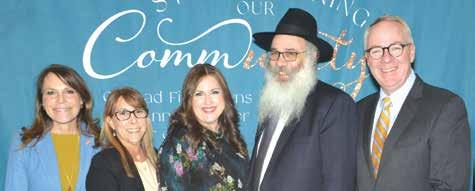
Purim night saw three packed minyanim for Megillah reading for all ages with Rabbi Dr. Dov Lerner presiding in the main sanctuary. An outdoor petting zoo and “Mordechai Pony Ride” sponsored by All My Children Daycare greeted young children as they arrived. After Megillah, a delicious buffet of pizza, falafel, salads, ice cream and, of course, hamantaschen was served in the downstairs banquet room where the YIJE sisterhood distributed “Family Game Night”-themed Mishloach Manot to members. In the main ballroom, the Sara Domb Youth Department annual
Purim carnival rocked the house with fun games and treats for young and old. In addition to traditional carnival game booths, there was a giant bounce house, game tables, cotton candy, popcorn and lots and lots and lots of dancing led and encouraged by YIJE Youth Director Jacob Herskowitz. A professional laser light show delighted the kids as well as the adults, and surprised everyone when the laser lights spelled out COLOR WAR...
This year, the Youth Department’s Color War, which engages the kids and teens with Torah challenges, athletic events and creative competitions, features an appropriately titled theme of Sasson and Simcha. Twenty different Color War events lay ahead over the next two weeks to hold the kids over till Pesach.


The Yeshiva of Central Queens is thrilled to announce that Rabbi Stephen Knapp has been appointed the inaugural Principal of YCQ’s Junior High School, effective July 2023. This is a newly created position that will elevate the Junior High School (JHS) to even greater heights.
Rabbi Knapp is a well-respected and distinguished Jewish educator with decades of teaching and administrative experience. For the past six years, he has served as the principal of Grades 1-8 at the Hillel Yeshiva in Deal, NJ. Under his leadership, Hillel achieved unprecedented growth in academic initiatives, student engagement, culture, and student registration.
“I am honored and excited to join the leadership team of YCQ, an iconic institution in our community, known for its rigorous academic program, rich Torah education, and warm and supportive culture,” remarked Rabbi Knapp. “I have already had the pleasure to visit the ye -

shiva on multiple occasions and I have observed firsthand the kindness, the energy and diversity of YCQ. These are special qualities that I hold dear and aspire to in both my personal and professional life,” he added.
Rabbi Knapp possesses an unparalleled passion for Jewish education, and particularly has significant experience educating students in Grades 6-8. He previously served as the Assistant Principal of Middle School and Assistant Principal of Judaic Studies at Westchester Day School and Middle School Principal at North Shore Hebrew Academy.
He recognizes that these years are a critical juncture in one’s life and is excited to facilitate the growth and development of YCQ’s Junior High School students. He is looking forward to helping guide students as they develop their personalities, aspirations, and strengths, inside and outside of the classroom.

“Rabbi Knapp is deeply committed to tapping the potential of each student, de -
veloping a love of learning, and a love of Yiddishkeit,” noted Rabbi Mark Landsman, principal of YCQ. “Not only is Rabbi Knapp an extraordinary educator, he is an ideal role model for our community,” he added.

Informal education experience is also one of the many skills Rabbi Knapp wields in his toolkit. He served as the Director of Chinuch at Camp Nesher, and most recently served as an educator on the United States delegation to the Maccabiah Games in Israel. He also credits his experience with NCSY for leading him towards a path of Jewish education. He recognizes that education is not limited to the four walls of the classroom and will work to enhance the already strong atmosphere of positive Jewish experience throughout YCQ.
Rabbi Knapp’s presence in YCQ will be a homecoming for his family. Rabbi Knapp’s father-in-law, Dr. Raphael Levine, was a student in the very first graduating class of the yeshiva, and Mrs.
Marcia Levine, the grandmother of Rabbi Knapp’s wife, was a longtime English Language Arts teacher in YCQ’s JHS. The YCQ community looks forward to formally welcoming Rabbi Knapp in the coming months and is confident that he will inaugurate the position with tremendous success.





Classes are not in session on Purim, but our dedicated students can’t be kept away from Mercaz Academy! Children and their families were invited to a gala, child-friendly reading of Megillat Esther followed by a “Breakfast Seudah” spread of French toast, scrambled eggs, bagels and fixings, and (of course!) hamantashen.
The Megillah was skillfully read by Mercaz parent Adam Farber, who threw in some entertaining tunes that caused giggles in the audience and kept everyone engaged with frequent pauses for noise to drown out the name of Haman. Most of the crowd wore colorful and creative costumes, and the majority of ra’ashanim (graggers) had been made on campus, to the delight of all.
Afterwards, the crowd enjoyed the delicious food and the impromptu costume
parade caused by the buffet line. This Megillah reading is so popular with students that it was attended by many alumni and their families, long after a “child-friendly” reading is no longer necessary for them. Further, several in attendance were not
(yet) affiliated with Mercaz Academy but had been drawn by the family-oriented nature of the event, and it was enjoyed by all comers, old and new.
We look forward to continuing this tradition far into the future, when current
Mercaz Academy students will bring their own children to this megillah reading, b’ezrat Hashem (with the help of Hashem). Thanks to the Mercaz Academy PTA, who made the event a beautiful, fun experience for the whole community.
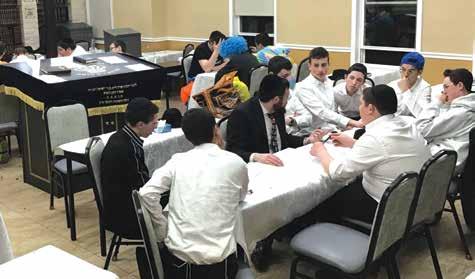

Sunday, March 5, was the New York City championship of the FIRST Tech Challenge, an international robotics competition for high school students. Out of 100+ teams in the city, the top 24 advanced to this competition after succeeding in the qualifier and super-qualifier competitions. MTA’s team, Lionotics, secured their spot here with a solid record winning most of their matches at the February 5th competition. Over the last few weeks, the students have been hard at work making improvements to their robot. With new sensors and increased dexterity, their
robot was able to reliably drive around the field, pick up game pieces, and put them down on tall, narrow poles, with both speed and precision. During the first 30 seconds of each match, the robots are not controlled by humans, rather they operate autonomously, running a prewritten program. Our robot placed 2 or even 3 game pieces in that short time, before using computer vision to park in the designated area. After the autonomous period, the students have the opportunity to control their robots with wireless controllers. This is an exciting 2 minute period where robots
work together to score more points and determine the winner of the match.
Lionotics came out strong, winning their first match of the day. But the competition was very stiff—these are the best teams in the city- and we ended the day with a record of 3 wins and 3 losses. This record, combined with our impressive autonomous program, earned us the number 11 spot in the rankings. Out of 24 teams in the championship and 100+ in the city, the Lionotics return proud of their accomplishments and excited about their incredible season.

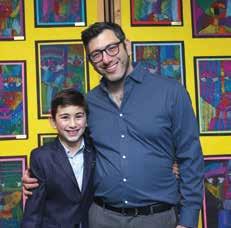
On Wednesday, March 1, HAFTR Lower School hosted their annual Evening of the Arts event. Hundreds of guests came to the school to enjoy a night of both visual and performing arts. HAFTR art teacher Mrs. Royce Maron and assistant art teacher Ms. Naomi Elterman worked hard to tap into each child’s artistic talent resulting in a beautiful showcase of student work. Guests got to walk through the beautiful gallery of student artwork which included sculptures and paintings.
The fourth grade sang the Star-Spangled Banner and Hatikvah before launching into a musical performance entitled, “Man of Sushan: a Purim Shpiel,” written

by HAFTR music teacher, Janet Goldman, and her husband, Judge Ronald Goldman. Rabbi Schwab, fourth grade rebbe, created the innovative and attractive lighting for the performance. The beautiful performance was a great way to gear up for Purim and allowed students to connect to the holiday on a deeper level by exploring the story and experiencing it through the arts.
After the performance, the audience was invited to participate in the creation of an installation art piece for the school, designed by Rabbi Yitzchok Moully. The piece, a clear glass house structure, is entitled, the Habitat for Divinity. Students and their guests traced and cut out color-
ful shapes that depicted mitzvot and Judaism and mounted them on the walls of the house.
Art offers a means of exploration for students. It helps them to connect to concepts learned in other subjects and further solidifies their understanding of them through exploration. Through the arts, students are taught to grow and explore the world. HAFTR would like to thank the following event sponsors for making this worthwhile event possible: Sara & Lee Bienstock, Irene & Andrew Goldberg, and Melisa & Chaim Lazarus. Thank you to the following Partner Sponsors: Debra & Moshe Davis (in memory of Max Davis, a”h), Lisa & Daniel Kuflik,
HALB’s seventh grade boys celebrated their bar mitzvah with their parents and rebbeim on Sunday. They enjoyed a delicious break-
fast, put together a beautiful presentation, and ended the morning with enthusiastic dancing. Mazal tov!
Gesher had an amazing month with visitors from our parent body! Throughout the month, parents from all different careers came in and taught our classes about their pro fessions. We had nurses, dentists, ther apists, and PAs, just to name a few. The children got a hands-on learning expe rience about what their parents do and had the opportunity to ask questions about the process of becoming a profes sional and what they enjoyed most about their professions. Thank you to all the parents for coming in to enhance our learning.



Over the last few weeks, the Pre1A boys at Yeshiva of South Shore learned all about different brachos. They tasted assorted grape juice and different types of bread. They cut, sliced, and chopped vegetables and created fruit shish kabobs.
They also enjoyed hands-on math lessons as they baked cupcakes, added in chocolate chips, and had a delicious lesson while sorting and counting Mike and Ikes.
The unit culminating with a Brachos Hunt at Gourmet Glatt as well as a detailed kashrus lesson by Rabbi Feivish Rotbard at the Ossies Fish Department.
The boys learned more math as they purchased food with their specific bracha and brought it back to school for a delicious Amen party.


In celebration of the Jewish holiday of Purim, the BACH Jewish Center partnered with the Long Beach Police Department to bring joy and deliver holiday care packages to the elderly residents of the Grandell Rehabilitation and Nursing Center.
Rabbi Benny Berlin of the BACH Jewish Center, joined by Long Beach Police Lt. Brett Curtis and Officer Matt Scheer, visited with residents, distributing mishloach manot – care packages filled with holiday treats – and handwritten notes and pictures from the children of the BACH.
The routine of dropping off Purim treats has now become an annual tradition for the BACH, as this year marks the
third in a row that the BACH has included the facility’s residents in their Purim celebrations, among other programs to help residents celebrate Jewish traditions and holidays throughout the year. This year’s Purim initiative, however, not only marked the first in-person Purim celebration they have shared post-pandemic but also included a partnership with the Long Beach Police Department.
“We’re extremely thankful to Rabbi Berlin and the BACH Jewish Center for inviting us to join them to create a memorable holiday celebration for some of the most vulnerable members of our community,” said Commissioner Ronald Walsh of the Long Beach Police Department. “Through initiatives like these, we
are able to show Grandell residents that the police department and faith-based communities care about them and welcome them to our community.”

“The Jewish holiday of Purim is a time to spread happiness and holiday cheer, not just through giving gifts, but also through directly engaging with members of our community,” said Rabbi Berlin. “It was wonderful to stop by and have a chat with our friends and exchange some laughter and smiles, and I am so grateful to Commissioner Walsh, Lt. Curtis, Officer Scheer and the entire Long Beach Police Department for joining us in this important holiday celebration.”
The collaboration comes on the heels of a separate joint initiative by the two

On Sunday, March 5, SKA participated in the annual Yeshiva League Model Congress hosted by HAFTR along with students from all over the tri-state area. Over the course of the day, preparation from the weeks leading up to the event was displayed through numerous speeches, questions on the proposed bills, and the resolutions that were debated.
The SKA students played prominent roles in the action of the day. Yashar koach to Libby Benjamini, Annabelle Engel, Tamara Fuchs, Chaya Furst, Ruth Ginsburg, Tali Goodstein, Chani Hei-

mowitz, Navi Hurwitz, Batya Kimyagarov, Hadassa Klahr, Tamar Lewin, Rachel Loike, Sarah Owadeya, Tamar Pinchasov, Sima Romima Shakoui, Sima Ross, Daphna Steinmetz, Yael Szlafrok, as well as Presiding Officers Avigail Nassir, Ariana Rossman, Avital Sojcher, and Tzipora Witner.
Congratulations to Sima Ross and Batya Kimyagarov who were placed as winners in the delegation, as well as Sarah Owadeya, Ruth Ginsburg, and Rachel Lokie, who won in their committee!
The event was a great success for SKA as the girls exemplified their dedication and secured their rank as the outstanding second best school overall! A huge
thank you goes out to Coach Shani Butler and Captain Batya Kimyagarov who,
organizations to drop off holiday toys to hospital bound children in late December, a testament to the burgeoning relationship between the institutions.
through their endless support, led SKA's Model Congress Team to victory.

The next time Eli got together with his friends and fellow volunteers at Magen David Adom, he told them about an idea that had been brewing in his mind. It was an idea that he would end up referring to many more times throughout his life.
“The only way we’ll be able to save lives,” he said, “is if we figure out a way to reach a patient within ninety seconds.”
The others looked at him as if he were crazy.
“How on earth are you going to be able to get volunteers to people’s homes within ninety seconds? It doesn’t make sense!”
“If you have enough volunteers living in a certain neighborhood, you could reach anyone in that neighborhood within ninety seconds.”
They looked at him, not sure where he was going with this.
“Let’s say you have an apartment building, and there are ten volunteers living in that building. If there’s an emergency call, then it goes without saying that a bunch of the volunteers will be able to get there within ninety seconds, right?”
They nodded.
“Well, it’s the same thing with neighborhoods. The key is to have enough volunteers in every neighborhood. If you have that, you’ll be able to reach everyone around the country in ninety seconds, and you’re able to save the lives of every person when they need you most.”
Though no one really took his idea seriously, Eli wasn’t discouraged. Especially since he had another idea that he wanted to try.
***
Eli had always prided himself on the fact that he wasn’t afraid to do anything. He was a person who had the chutzpah to suggest ideas others wouldn’t suggest and to try things other people shied away from. After serving as a volunteer for many months in the back of an ambulance and having learned so much about how to save people’s lives, he suddenly had a major breakthrough.
Israel might be able to boast of having one of the best ambulance services in the world, but if the ambulances weren’t able to reach patients in the critical window of time before all was lost, it didn’t matter how great a service it was. People were
dying every day despite their best efforts to reach them on time. In Eli’s opinion, the system was broken and needed to be rebuilt.
At that moment, Eli had one of his outof-the-box brainstorms.
What if he were to go to the national radio station — Reshet Bet was the only major station at the time — and deliver his message to the citizens of Israel.
“Every day,” he imagined himself saying, “there are numerous life-threatening health emergencies occurring all over Israel. If we could convince Magen David Adom to share emergency information with the radio, like if a baby is choking on a certain street in Tel Aviv, then anyone listening to the radio who is a medical professional would be able to drop what they are doing and run over to save a life if the person is close enough and they could get there in time.”
At that time, everyone in Israel listened to the radio because there weren’t as many options for entertainment as there are today. Which meant that if Reshet Bet made such an announcement, and television’s Channel One did the same, all their bases would be covered, and a staggering number of lives could be saved.
Eli shared this idea with his fellow volunteers at MDA. Without exception, every single one advised him not to waste his time trying to pitch the idea to the Israeli media. They would never agree to work with them.
In the end, Eli told himself that his friends were right. There was no way that the radio would interrupt a news program for such an announcement, especially since it wouldn’t have been just a one-time announcement but a constant stream. Instead, he had another idea. It was simple, but he thought it might just work.
What if he went to all the volunteers at Magen David Adom and asked every one of them to carry a pager? (This was the prevalent technology at the time. A short voice message was delivered to the intended recipient.) Whenever an emergency call came in to the dispatcher at MDA, all they needed to do was send out a message to all the pagers, and whoever was in the area of the emergency would drop whatever they were doing and run.
***
Armed with the chutzpah that would
eventually turn United Hatzalah into one of the most effective lifesaving forces in the world, Eli Beer sought to arrange a meeting with the head of Magen David Adom — a man named Chaim. Eli asked Chaim’s secretary for a meeting, and she penciled him in obligingly. Chaim was a nice guy, and Eli genuinely liked and respected him. Eli was hopeful that Chaim would see things his way and agree that what he was proposing was a good idea.

But Chaim didn’t see things Eli’s way.
Not even a little bit.
“It’s not a good idea,” he told Eli bluntly.
“Why not?”
“For one, we can’t give out emergency information that comes into the dispatcher. Our insurance wouldn’t allow it. Besides, people can’t just walk into a patient’s house without an ambulance.”
When Eli put forth his counterarguments, Chaim’s response was, in a nutshell, to go away and stop bothering him.
“When I saw that I wasn’t getting through to him,” Eli recalls, “I pulled out my log book and showed Chaim the numbers I had written down detailing the details of every call I had gone on — in real time.
“‘These are the real numbers,’ I said. ‘These are the times from the moment a call comes into the dispatcher, not from the minute the ambulance leaves the station. I’ve been keeping this log for the last year and a half. This tells the real story.’”
But Eli could see that he still wasn’t getting through to the boss.
“Chaim,” he said, a hint of desperation coming through, “I can help you save lives! All I need is for you to allow the dispatcher to send the emergency information to the pagers that every volunteer will have.
“Give me the go-ahead, and I’ll start working on recruiting more volunteers so that we have a better chance of getting to every emergency in time to save lives — even if there is traffic on the road and the ambulance is having a hard time making it there.
“I can help you save lives! I can help! Let me be your liaison with the volunteers. You have nine ambulances in Yerushalayim, but I’ll be able to arrange for another thirty or forty volunteers all over the city. All I’m asking is for you to give me the goahead and I’ll get to work!”
Chaim’s reply was instantaneous and
resolute.
“It’s not going to happen.”
There was no room for negotiation. The answer was no. In Chaim’s opinion, there was no need for volunteers to be available to run to the scene of an emergency — even if they would be able to arrive there before the ambulances. Eli’s idea had never been done before in Israel, and people have a hard time changing the status quo.
But even though change can take a long time to implement, that doesn’t mean you don’t try. Eli wasn’t ready to give up.
“Chaim, I can help you save lives,” he insisted.
Chaim was impatient with the kid who wouldn’t leave his office.
“Are you suggesting that we’re not saving lives?”
“Of course, Magen David Adom is saving lives,” Eli said, trying to contain his frustration. “But there are major emergencies happening all the time, and we’re just not reaching the people in time. In all the time that I’ve been volunteering with Magen David Adom, I haven’t had the chance to bring a person back to life, and that’s because by the time the ambulance was able to get through traffic, it was too late.”
Now Chaim was really mad. “You know what,” Chaim said at last, truly angry at this upstart teen who was wasting his time, “I think you’re bored. Why don’t you go work in a falafel shop?”
***
Chaim wasn’t the only angry one. Eli left the office, furious. He had a revolutionary idea and no agenda other than his burning desire to save lives. When he had

Twenty years ago, he was a yungerman in Ponevezh, known more for diligence than his oratory prowess, a scion of the rebbes of Lelov who reflected the energy and joy of his ancestors. Some American bachurim in the Slabodka Yeshivah discovered the thirty-somethingyear-old Rav Elimelech Biderman and formed a private chaburah with him. They started eating Shabbos seudos at his home, speaking to him in learning and about life, and found that interactions with him left them feeling rejuvenated, a bit better about themselves.
When one of the chaburah members continued on to Mir, he missed the weekly shmuess, and so he asked Reb Meilech to start coming up to Yerushalayim as well. On Thursday nights, a chaburah was formed near the Mirrer Yeshivah in Yerushalayim, a small group gathering in the apartment that had once belonged to Rav Shloim’ke Zhviller, one of the great tzaddikim of Yerushalayim — and a greatgrandfather of Reb Meilech, who is married to the daughter of the Zutchker Rebbe, himself a son-in-law of Ray Mordechai of Zhvil, grandson of Ray Shloim’ke.
The Torah of Reb Meilech seemed to come from a place without boundaries, a rush of halacha, chassidus, and Kabbalah, classic mussar and drush, stories and lomdus. The people responded to his
walked into Chaim’s office, Eli had genuinely thought the CEO was going to jump at the idea. The only thing he was asking for was the willingness to share the information needed to make the idea a reality. Now he was upset and disillusioned. After seeing a boy who had choked to death on a hot dog, part of him wanted to stop volunteering even though that had been his whole life until that point. Suddenly he didn’t see any reason to volunteer if he couldn’t save lives.
While he was standing in Chaim’s office, many traumatic scenes had flashed through his mind. It was like a movie with the sound turned off — just scene after scene after scene.
One scene he recalled was the aftermath of the first terror attack where he served as a volunteer for MDA. It happened on Jaffa Road. He could still hear the words of the dispatcher over the radio.
message, their hearts captured by his vision of what a Yid is, how precious every small tenuah that a Yid makes is, how beloved each Yid is to the Master of the universe. They found strength and courage in the steady, continuous flow of emunah that came forth, learning not just to accept, but to appreciate, to revel in the challenges and joyfully triumph.
Over the last two decades, Reb Meilech’s voice has spread, with derashos delivered in both Yiddish and Hebrew in Meah Shearim or the Ponevezher Kollel, in a yeshivah for Americans, at a Tel Aviv “chaburah” of secular high-tech entrepreneurs, at the famed Sephardic Yazdim beit haknesset, and in small neighborhood shuls. Clips and translations of his weekly shiurim are lifting neshamos across the world. His reach and impact have grown, but he himself remains the same, without a formal beis medrash, yeshivah, or kollel, without organizations or websites, dancing through life, from the deepest corners of his beloved Meron to side rooms at the Itzkowitz Shtieblach in Bnei Brak.
He is hard to pin down, his days a trail of tefillah and chizuk: in hospital wards, offering words of hope, at a shivah home telling mourners that the sun will rise again, in the center of a throbbing circle at the wedding of someone who didn’t have it easy, adding new dimensions of simchah
“All ambulances to 40 Jaffa Road. There’s a terrorist with a knife stabbing people at the bus stops.”
When they arrived, they found an elderly man lying on the ground, the terrorist’s knife still lodged in his back. Eli performed CPR on the man — with the knife still in his back. But he died.
Then there was the car accident on Herzl Boulevard. The car was totaled before they got there, and the driver was no longer alive.
So many traumas — but he had never managed to save anyone. It happened again and again. Eli knew that he couldn’t save everyone. But too many times it was only a matter of getting there sooner.
When Eli left the office that day, he said one last thing.
“Chaim, I will do this with you or without you. But it’s going to happen.”
Chaim would end up becoming good friends with Eli Beer. There would come a
He can be standing on a Bnei Brak street corner listening to the suffering of an individual or hidden away in the back of an out-of-the-way beis medrash, humming by an open Gemara.
That’s the schedule — Torah, chizuk, emunah, simchah, little particles of life flowing from him to others, giving them a new burst of chiyus
He is restoring the pride, the innate joy, the valor that comes with being a Yid. When he is dancing on the table, the wall of people around him soaring along with him, together they are reaching higher, dreaming of more, celebrating what they have.
This is the call of Rav Meilech Biderman and this is the call of a brand new Haggadah published by ArtScroll, the lyrics of a whole year becoming full-throated song on the night of Pesach. Written by bestselling author Yisroel Besser, there is a theme that runs through the pages of Reb Meilech on the Haggadah, and it is one of clarity, courage, and most of all, freedom — the freedom of becoming His.
Becoming His, and understanding that He is ours as well.
He is watching, He is listening, He is waiting, and He is cherishing each word we say.
Reb Meilech has touched all of Klal Yisrael with his messages of chizuk,

bringing us uplift and hope, filling us with confidence that we can make good things better.
Reb Meilech on the Haggadah brings his message of emunah and hope to our Seder table.
Reb Meilech will enliven our Seder as only he can, with beautiful divrei Torah, delightful stories, and wise insights. This Haggadah will fill your home with Reb Meilech’s unique brand of simchah, the happiness of being part of Klal Yisrael, the joy of becoming aware of Hashem’s gifts all around, and the delight of knowing how much our Creator loves us and takes pleasure in all the good things we do.
day when Hatzalah even presented Chaim with a trauma bag for his car sporting the Hatzalah logo — a gift he gratefully ac-
cepted. That, however, was all in years to come.
A policeman is interrogating three guys who are training to become detectives. To test their skills in recognizing a suspect, he shows the first guy a picture for five seconds and then hides it. “This is your suspect. How would you recognize him?”

The first guy answers, “That’s easy. We’ll catch him fast because he only has one eye!”
The policeman says, “Well...uh...that’s because the picture I showed is his side profile.”
Slightly flustered by this ridiculous response, he flashes the picture for five seconds at the second guy and asks him, “This is your suspect. How would you recognize him?”
The second guy smiles, flips his hair, and says, “Ha! He’d be too easy to catch, because he only has one ear!”

The policeman angrily responds, “What’s the matter with you two?! Of course, only one eye and one ear are showing because it’s a picture of his side profile! Is that the best answer you can come up with?”

Extremely frustrated at this point, he shows the picture to the third guy and in a very testy voice asks, “This is your suspect. How would you recognize him?
He quickly adds, “Think hard before giving me a stupid answer.”
The third guy looks at the picture intently for a moment and says, “The suspect wears contact lenses.”
The policeman is surprised and speechless because he really doesn’t know himself if the suspect wears contacts or not.
“Well, that’s an interesting answer. Wait here for a few minutes while I check his file and I’ll get back to you on that.”
He leaves the room and goes to his office, checks the suspect’s file on his computer, and comes back with a beaming smile on his face.

“Wow! I can’t believe it. It’s TRUE! The suspect does, in fact, wear contact lenses. Good work! How were you able to make such an astute observation?”
“That’s easy...” the third guy replied. “He can’t wear regular glasses because he only has one eye and one ear.”

1. Freelance photographer Dilish Parekh of Mumbai has the largest camera collection in the world. Approximately how many cameras does he have?
a. 700
b. 4,600
c. 19,355
d. 100,220
2. Why did Kodak founder John Eastman name his company Kodak?
a. Because Kodak means photo in Scandinavian, which is where he is from.
b. Because his father’s name was Kodak Eastman and he inspired him to start the company
c. He made up a word that started with the letter K because he thought that the letter K sounded strong.
d. He named the company for a phrase “Kodak moment” from a Ralph Waldo Emerson book, which means to suddenly capture something.
3. In what year was the first digital camera invented?
a. 1975
b. 1989
c. 1996
d. 2001
4. The photo below of a ribbon was the first picture ever taken. What year was it taken in?


a. 1824
b. 1861
c. 1893
d. 1917
a. $184,382
b. $296,508
c. 1,250,000
d. $4,338,500
5. The image below, taken in 1828, is the first picture to ever capture a person in it (a person getting shoes shined). Where was the photo taken?

a. Strangely enough, it was taken on Central Avenue in Cedarhurst
b. Paris
c. Washington, D.C.
d. Munich
7. According to a study at Wake Forest University, which side of their faces do people prefer to take pictures of because they exhibit greater emotion?
a. Left
b. Right Answers
6. In 1999, Andreas Gursky took the below photo of the Rhein River. How much did it sell for in 2011?

Wisdom Key
7-8 correct: I see the wide smile on the left side of your face!
3-6 correct: You are not exactly John Eastman, but not bad.
0-2 correct: “A picture says a thousand words.”

The book of Shemot that began with such high drama just a few months ago ends this week on a rather “bland” and apparently purely technical note. The Torah once more reviews and recounts for us the details of the construction of the Mishkan and an exact account-
ing of the material goods that were used. Through the ages, the commentators have dwelt long and hard on these parshiyot in the holy Torah – where every letter and word is eternal – in an attempt to justify this seemingly superfluous repetition. I will not attempt to review all of the
different approaches to explain this issue. They are all satisfactory and yet somehow short of the mark as well. There is an obvious teaching that all of the commentators agree with that does derive from this review and repetition regarding the construction of the Mishkan.
The Mishkan had the miraculous quality of being built exactly and unwaveringly according to its original plan. Many times in life, people and institutions set out to create structures, organizations, and policies that will be of great benefit to society upon completion. Rarely, if ever, does the
missing screw, nail, or hook can lead to later disaster. This is true in the physical mundane life of people and is doubly true regarding the spiritual and moral character of a person and a community. Only in the completion of the details is the whole person or project seen.

The measure of an artist, whether in pictures or music, is always in the nuances – in the details. The avoidance of shortcuts that invariably lead to shabbiness is the true hallmark of the gifted performer. Moshe lovingly records for us every piece of material that came together in the holy
finished product match exactly the plans and true intentions of those who initiated the project.
All human plans and blueprints are subject to change, alteration, and even to cancellation. The plans for the Mishkan, shrouded in the spirituality of G-d’s commandments, were not subject to such changes. Bezalel and Ahaliav and the Jewish people were complimented for their strict adherence to the original plans given to Moshe for the construction of the Mishkan.
Every detail of the construction of the Mishkan is reviewed in the parshiyot of this week. All builders are aware of the importance of detail in their work. A

Mishkan. In kabbalistic thought, every detail in the construction of the Mishkan is truly an influence on the general world at large.
Though the Mishkan is no longer physically present with us, its lessons and greatness still abide within the Torah we study and in our value systems. By reading the Torah’s description of the Mishkan and studying the underlying principles that it represents, it gains life and influence within us individually and collectively.
May we be strengthened by this eternal knowledge.
Chazak chazak v’nitchazek and Shabbat shalom.Only in the completion of the details is the whole person or project seen.

Remarkably, between the parshios of Terumah-Titzaveh and Vayakhel-Pikudei, the Torah spends over 400 pesukim describing the details of how the Mishkan should be – and actually was – built. There is no other mitzvah regarding which any comparable amount of time is spent. Neither tefillin, Shabbos, yom tov, nor anything else has so many pesukim devoted to it. Why is that? Why must the Torah repeat all of the details of the Mishkan and vessels in Vayakhel-Pikudei when all of these specifications were already laid out in Terumah-Titzaveh? The Torah could simply state that the Jewish people built everything just as they were commanded. Why spend another 200 pesukim repeating everything?
The Lubavitcher Rebbe, zy”a, based on a Yerushalmi, says that the specifications regarding how the Mishkan and its vessels should be built in Terumah-Titzveh describe the Mishkan in the world above – in Heaven. And Vayakhel-Pikudei describes the details of how the Mishkan below was actually built – here in this world. There are two separate sets
Adapted for publication by Binyomin
Wolfof specifications for each because one cannot simply assume that the physical reality here in this world corresponds exactly with what it is supposed to be.
The architectural plan for the Mishkan is found in Terumah-Titzaveh. This is the artist’s rendering. Yet the Torah separately describes the actual construction in Vayakhel-Pikudei to teach us that the two are not necessarily the same. Why is this so? What happened in between which can explain the potential discrepancy?
Perhaps it is because Parshas Ki Sisa, which describes the Sin of the Golden Calf, is interposed between the two. Our own failures and shortcomings create the difference between what we could do and what we actually accomplish.
It is like this with respect to all areas of life. The ideal one plans for does not always pan out. When a couple marries, each of them, and the bride in particular, has a specific image of what married life will look like. It sometimes involves beautiful, white Shabbos tablecloths, elegant silver candlesticks, well-behaved children listening attentively to Abba’s dvar Torah,
and singing zmiros beautifully together. The groom, as well, may have images of a beautiful, spotless home in his mind. He may picture a life in which his beautiful wife and children wait adoringly for him as he comes home, thanking him for providing such a beautiful life for them. He may imagine that he davens in a shul where three months never go by without the gabbai giving him an aliyah on Shabbos morning. But real life seldom looks exactly the way the bride and groom imagine.
It is the same in one’s spiritual life. At Neilah, one may imagine that this year, he will be holy and pure, free from all of the filth with which he contaminated himself the previous year. And sometimes the realities of life bear a passing resemblance to one’s plans. But very often, it is completely unrecognizable.
We find another anomaly in the Parshas Pikudei. No less than nineteen times, the Torah repeats that the Jewish people built one or another part of the Mishkan and vessels “just as Hashem commanded Moshe.” Why is this done in
this context, whereas it is not done anywhere else? Rav Yitzchak Zev HaLevi Soloveichik, zt”l of Brisk explains that there is a dispute in the Gemara whether it is possible for people to make anything the Torah commands with exact precision or not. In other words, can we make the Ark the required 2.5 amos long without making it 2.50000001 amos long? Can we say that two events, in halacha, occur at exactly the same moment, and not 0.0001 seconds apart?
The Brisker Rav explains that we follow the opinion of the Chachamim that it is not possible to achieve exact precision. Accordingly, even though the way we built the Mishkan may not have been exactly as the Torah commanded to the thousandth of an inch, to make sure that we do not worry that we have not fulfilled Hashem’s will with respect to the building of the Mishkan and its vessels, the Torah repeatedly reassures us that we did the job “just as Hashem commanded Moshe.”
In fact, the Minchas Chinuch (109) says regarding all of the requirements of the Torah involving specific measure -


ments that Hashem only wants us to do our best to act according to those measurements, and that by doing so, we are doing the job exactly as He commanded. He knows our capabilities and chose to give the Torah to us and not the angels above.

Hashem commanded us to build the Mishkan but concomitantly reassured us that our best efforts to meeting the specifications were all He wants from us. He wants us to know that “there is no righteous man in the earth who does [only] good and does not sin” (Koheles 7:20). Hashem wants us to know that He does not expect absolute perfection from us so that we will be able to move forward in our service of Him and not beat ourselves up or become discouraged because of our lack of perfection.
The entire reason our souls descended from the upper world into the Mishkan below of our bodies is to give us opportunities to do our best to reveal Hashem’s Presence and holiness in the messy scrum of this world.
While the actual city of Chelm was filled with great Torah scholars, a number of apocryphal stories are told which portray the city is if it were filled with fools. In one of those stories, there was a de -

bate in the town beis medresh regarding whether the sun or the moon were more powerful. After a full day of arguments, the Rav finally stood up, banged on the shtender, and announced that he was settling the issue: the moon was stronger than the sun. When asked the reason for his decision, he explained, “The moon is powerful because it has the strength
we are not able to accomplish everything to the thousandth of an inch. Not only is Hashem not upset with us when we do our best but fall short, this is exactly what He wants – exactly what He had in mind when setting up the world the way it is.
The Kotzker Rav, zy”a, and Rav Yitzchak Vorker, zy”a, are two tzaddikim from the world of Peshischa and were
underlying foundation of the service of G-d for both of them was truth. Because of the Kotzker’s love for truth, he was completely intolerant of even the slightest admixture of falsehood. And because of Rav Yitzchak Vorker’s love for truth, if he encountered even the slightest point of truth within a person, he was overcome with joy at encountering that truth.
to light up the night. The sun, however, must not be very powerful because it only attempts to light up the daytime when it is already light outside anyway. It must therefore be weaker.”
Our job, like the recounting of the building of the Mishkan in Vayakhel-Pikudei, is to do the best we can, without driving ourselves crazy, to bring light into the darkness of this world. Even if
the closest of friends, though they could not have been more different. The Kotzker was known as being a fiery zealot for truth with absolutely no tolerance for even the slightest trace of dishonesty or self-deception. Rav Yitzchak, however, was known as the gentlest, kindest Rebbe in the world.
Because both were students of Rav Simcha Bunim of Peshischa, zy”a , the
The way of the Kotzker is too difficult for most of us. We must follow the opinion of the Chachamim in our service of Hashem, recognizing that absolute precision is not asked of us. Rather, Hashem only asks that we do our very best even though we often fall short. We must continue trying and bringing more light into the darkness of this world. May Hashem help us continue growing and trying to bring His light into our lives more and more and not listen to the inner voice which tries to discourage us by telling us that whatever we do is not good enough.
Our own failures and shortcomings create the difference between what we could do and what we actually accomplish.

He had been controlling himself for so long, had come so far, but he just couldn’t hold himself back anymore. Everyone else was asleep, so no one else would even have to know. Internally, he was struggling, pulled in every direction, unable to make a decision. On the one hand, there was a convincing and confident voice persuading him to do it, to give in to the urge, “If you eat it, it will feel so good!” On the other hand, there was a quieter, more subtle voice attempting to use reason and judgment. “But this is ridiculous. It’s wrong, destructive, childish, just foolish. You’ve done this before, and hated yourself afterwards; you felt disgusted, ashamed. You know that you’ll feel the very same way in about five minutes if you do it again. This has never ended well for you.” As a bead of sweat drips down the side of his cheek and he stares at the chocolate cake, he tries to weigh his options.
Before he can really get a handle on the situation, the confident voice pipes up again, this time sounding even more convincing than the first time. “Just think about how good it will feel. You only live once. Who really cares about the consequences? How can you not do this?!”
Suddenly, the second voice stops giving good answers. (Or maybe he’s just not listening anymore.) Now, he only sees one side of the equation. He lets desire cloud his judgment. With a feeling of resignation, he gives into temptation. If he had been watching someone else do this same act, he would have been screaming at the top of his lungs for them to stop this insanity. But he has
become blinded by desire, lured into the trap of instant gratification, and has fallen prey to his lower self. A moment later, he awakens from his intellectual slumber, regains awareness, and, as his higher self predicted, looks in the mirror with total disgust and revulsion, promising himself it won’t happen again. He can’t bear the hypocrisy, the two-facedness. For a moment, he does not look at himself from within, but from without, as an onlooker, an observer, and he does not like what he sees.
Maybe he has a smear of chocolate on his lips after breaking his diet, or maybe it was something else. The details are not important. This is the story of life: struggle, sometimes with small defeats, and other times, small victories. Most of life is fighting for inches. We take a
step forward, then two steps back; three steps forward, another one back. Life tends not to be about giant leaps or falls, but rather a question of inches. This being the case, we need to take a deeper look at the Cheit Ha’egel.
Cheit Ha’egel, the Sin of the Golden Calf, is perhaps the most infamous event in the Torah, a sin compared to the original sin of Adam HaRishon and one that has repercussions throughout Jewish history. Yet, what is most striking about this sin is not the act itself but its timing. The Jewish People had just experienced the fantastic miracles of Yetzias Mitzrayim, the earth-shattering wonders of K’rias Yam Suf, and had just received the Torah from Hashem Himself. They were
elevated to the angelic state of Adam HaRishon before he ate from the Eitz Ha’daas, and they were therefore able to eat the angelic food of manna, which the Ramban explains was crystalized, condensed Shechinah. As Rashi quotes, even the maidservants at K’rias Yam Suf received prophecy and had a higher level of understanding of Hashem than Yechezkel — who saw an image of Hashem Himself (Rashi, Shemos 15:2). If so, how could the Jewish People commit such a terrible sin at this moment? Even worse, they not only committed this sin immediately following Matan Torah but did so in the very same spot, at Har Sinai, the very place where we “married” Hashem! Chazal compare this to a kallah (bride) betraying her husband under the chuppah! As the pasuk says, they strayed “quickly” (Shemos 32:8). How could Klal Yisrael fall so rapidly and drastically right after Matan Torah?
While this requires a much lengthier discussion, let us briefly explain the sin of idolatry. Many think of idolatry as the worship of statues and inanimate objects. However, any intelligent person can see that a piece of wood or stone carved out by a human being could not possibly hold any power over him. The deeper understanding behind the worship of idolatry, as the Rambam (Mishneh Torah, Avodah Zarah, perek 1), Ramchal (Derech Hashem), and many others explain, is the worshiping of intermediaries instead of sourcing oneself back to Hashem Himself.
Hashem created the world in such a




way that there are levels of reality. Hashem is the ultimate Source, and the intermediaries receive energy from Him, which they then manifest into the world. Avodah zarah is when you don’t recognize Hashem as the Source but rather trace things back only as far as the intermediaries. The statues that idolaters “worship” are merely tangible representations of the higher forces they serve.
What is the purpose of idol worship? What compels a person to commune with the intermediaries rather than seeking the ultimate root, Hashem Himself? The answer is simple. Why go back to the source when you can get everything you need from a middleman, especially if the middleman demands so little in return? True service of Hashem means a life of obligation, whereas idolatry is one of entitlement and freedom from obligation.
Similarly, the psychological draw to nihilism is freedom from obligation. A religious life is one of obligation (to the truth), where everything in one’s life has meaning. A life of nihilism is one of no obligation – but nothing in one’s life has meaning. The trade-off for freedom from obligation is a life of slavery
to emptiness. Only one who is a slave to the truth, i.e., who embraces meaningful obligation, is truly free.
The mechanism of avodah zarah can be compared to a man who walks into a large store and sees an expensive item he desperately desires. However, he isn’t willing to pay its $1,500 price tag, so he walks over to the cashier and makes him a proposition: “I’ll slip you $150, and you
did require some form of obligation, as they were still required to “appease” the intermediaries, this required much less responsibility than a life devoted to Hashem, a life devoted to the truth.]
However, avoiding Hashem in this way, avoiding the truth, is the absolute worst sin in the entire Torah. The prohibition against avodah zarah is the first mitzvas lo saaseh (negative command-
inappropriate for them to do so. (This connects to the deep topic of “Gadol ha’metzuveh ve’oseh mi’mi she’eino metzuveh ve’oseh — Greater is one who is commanded [and does something] than someone who is not commanded [and does it of his own volition].” Sometimes, taking the initiative into your own hands reflects ego and self-assertion, as opposed to selfless devotion.) It is clear, though, that the Ramban and Rabbi Yehudah Halevi downplay the severity of the Cheit Ha’egel and do not view it as a transgression of the prohibition of avodah zarah
can quietly pass over the goods.” In other words, this man wants the goods, but he isn’t willing to pay for them! Instead, he tries to cut a deal with the middleman. So, too, idolatry was man’s way of receiving “the goods” without paying for them. Why go all the way to Hashem to ask for rain, health, and prosperity when that would demand a life of obligation in return? [While it is true that idolatry
ment) in the Aseres Hadibros. As many commentators explain, avodah zarah is the root of all the other negative commandments. All other sins are merely a subcategory of idolatry, whereby you serve your own selfish needs and desires instead of sourcing yourself back to Hashem. The Sin of the Golden Calf was the worshipping of idolatry, which means that the Jewish People went from the highest of heights to the lowest of lows in mere moments. This completely contradicts our starting principle from the introduction, namely, that spiritual falls occur slowly, in small steps. How did this happen?
Some commentators, such as the Ramban and Rabbi Yehudah Halevi (Sefer HaKuzari), suggest that the Jewish People did not commit genuine idolatry. Rather, after Moshe Rabbeinu failed to descend from Har Sinai, the Jewish People believed that their leader, who served as the medium of connection between them and Hashem, was gone forever. In desperation, they attempted to create a new physical medium of connection, i.e., the Golden Calf. This idea itself is not inherently wrong, as we see that the Jewish People are told to build an Aron, a physical vessel, to serve as a connection between them and Hashem. The Aron (Holy Ark) had two Keruvim (cherubs) on top of them, and the Torah states explicitly that Hashem spoke to Moshe through the Keruvim (Shemos 25:22). The Ramban and Rabbi Yehudah Halevi therefore explain that the problem was not the motive but the method of achieving their goal. Because Hashem did not command them to create a physical medium of connection, it was
However, many commentators, including Rashi, believe that the Cheit Ha’egel was genuine idolatry. This means that immediately following Matan Torah, the Jewish People fell prey to the worst sin imaginable, i.e., avodah zarah , failing to source themselves back to Hashem. According to this line of thinking, we are back to our original problem: how did the Jewish People, who had achieved such great spiritual heights, undergo such a rapid, astounding fall? Spiritual falls tend to occur slowly in small steps. In this case, however, the Jewish People went straight from the highest of heights to the lowest of lows; from angelic to broken. How did this happen?
In our next article, we will delve deeper into this fascinating topic and try to explain Rashi’s unique approach.
Rabbi Shmuel Reichman is the author of the bestselling book, “The Journey to Your Ultimate Self,” which serves as an inspiring gateway into deeper Jewish thought. He is an educator and speaker who has lectured internationally on topics of Torah thought, Jewish medical ethics, psychology, and leadership. He is also the founder and CEO of Self-Mastery Academy, the transformative online self-development course based on the principles of high-performance psychology and Torah.
After obtaining his BA from Yeshiva University, he received Semicha from Yeshiva University’s RIETS, a master’s degree in education from Azrieli Graduate School, and a master’s degree in Jewish Thought from Bernard Revel Graduate School. He then spent a year studying at Harvard as an Ivy Plus Scholar. He currently lives in Chicago with his wife and son where he is pursuing a PhD at the University of Chicago.
To invite Rabbi Reichman to speak in your community or to enjoy more of his deep and inspiring content, visit his website: ShmuelReichman.com.

The trade-off for freedom from obligation is a life of slavery to emptiness.

Rebbe Eliezer ben Yaakov said, “From where do we know that a woman should not go out to war with weapons?” The Torah says, “A man’s utensils should not be on a woman” (Devarim 22:5). The simple understanding of the verse is that a woman may not wear a man’s clothing. However, Rebbe Eliezer understands the verse to be referring to weapons (Nazir 59a).
This has relevance to the story in Tanach of the heroine Yael. Yael welcomed the fleeing enemy general Sisera into her tent with feigned hospitality. After drinking a refreshing beverage, Sisera lay down and soon sank into the sleep of the weary. While he lay asleep, Yael crept stealthily up to him, holding a tent peg and a mallet. She drove it through his temples with such force that it entered into the ground below.
The Mefaresh on Nazir explains why Yael killed Sisera with a tent peg rather than a sword. She didn’t want to wield a weapon that is generally used by men and thereby violate the aforementioned prohibition.
Torah.org has an unattributed article that discussed this topic and makes the following observations.
In a moment of crisis, with the Jewish future at stake, Yael justifiably could have resorted to the most expeditious, though masculine, means of achieving her goal. Instead, understanding the profound spiritual repercussions of this route, Yael takes a more difficult tack. She risks her personal safety, preserves her spiritual integrity, and redefines what it means to be a “woman of the tent,” using the tent stake and even the tent itself to carry out her startlingly “modest” murder of Sisera. Yael maintains her own internal integrity even in a situation mandating that she act ruthlessly. In this way, she accomplishes both her immediate mission—to kill Sisera and to redeem the Jewish people— and her eternal mission, which is to serve G-d with modesty and compassion.
The Torah.org article assumes that Yael willingly chose a peg as her weapon of choice as opposed to a sword, thereby putting herself in personal peril. Indeed, the Tiferes Tzion seems to concur with this understanding. He notes that it would have been safer for Yael to kill Sisera with a sword. Though Sisera was sleeping, he might have woken up at any
Torah prohibitions are waived. Certainly here there was an additional concern that Sisera would regroup or form a new army. If he did so, many lives would then be in danger. Violating a Torah prohibition in this scenario would certainly be justified. The Avnei Tzedek says that, based on this consideration, Yael would have used a sword if she had one available. Since it
use a man’s sword to protect herself from Sisera. The raincoat accomplishes a utilitarian task just as a sword would. He answers that since Yael had another option available, namely a tent peg, she couldn’t use the sword. We can surmise that the Maharsham likewise did not assume that Yael put herself in any additional danger by using a tent peg in the place of a sword. Even though she may have been filled with fear and trepidation about what she was about to do, she still calmly and resolutely weighed her options. She determined that under the circumstances she should use a tent peg.
In tense moments, it can be very difficult to think clearly, and the tendency is to act rashly, making decisions we may come to regret. We should learn from Yael that even under the extreme pressure of the situation, we should still attempt to calmly consider our actions and make proper choices.
The Yalkut Yehudah notes the juxtaposition of the admonition against women using weapons to the mitzvah of shiluach ha’kan in Parshas Ki Seitzei. Mothers may feel slighted that while the men go and fulfill the mitzvah of conquering Eretz Yisrael, they are stuck home with the kids! The Torah therefore teaches us that caring for offspring is so dear to Hashem that He doesn’t even allow us to take a bird that is caring for her young. The mitzvah of caring for children is more precious to Hashem than conquering Eretz Yisrael. Hence, even for the sake of taking possession of our Holy Land, we should not draft someone involved in the cherished mitzvah of child-rearing.
moment. She should have chosen the quickest weapon available, but she didn’t because of the admonition against women wielding the weapons of a man.
Still, it seems hard to fathom that with her life and the lives of many innocent people at stake, she would choose to risk it all for the sake of one prohibition. There is a rule that when one’s life is in danger,
was a man’s implement, she didn’t have one handy. Hence, she was forced to use a tent peg.
The Maharsham notes that there is a machlokes ha’poskim about whether a woman may wear a man’s raincoat just to protect herself from the rain. The Maharsham asks, according to those poskim who permit it, why Yael couldn’t

She risks her personal safety, preserves her spiritual integrity, and redefines what it means to be a “woman of the tent.”


 by Ronit Segev and Avi Schwartz
by Ronit Segev and Avi Schwartz
It was lunchtime one Sunday when my WhatsApp pinged with a bizarre question on the town’s group: does anyone know what happened in Huwara?
Huwara is a large, sprawling Arab town in northern Samaria. It sits right on the main road leading in and out of what are known as “Gav HaHar Settlements,” the Jewish villages behind the biblical city of Shechem. These include Yitzhar, Bracha, Elon Moreh and Itamar – where I’d moved just three weeks ago. Huwara is one of those places that cause you to take Tefillat Haderech very seriously. Almost every day, Arabs hurl rocks at Jewish cars. They often strike their targets. This is because of the near standstill traffic which plagues the area – it’s a bottleneck. There are too many cars, and the road is too narrow. The bottleneck is made worse by
bumpers along the village road, and pedestrians weaving between cars in order to reach large, fancy-looking glass-paneled shops lining both sides of the road. These shops sport pretty Arabic lettering, occasional Hebrew, and cheap merchandise. Jews don’t shop there. The Jews who know about those shops are the ones who drive through that road every day; and they know that while the price of a brand-new sofa is cheap – no VAT here in Palestineville – it’s not so cheap that they’d risk their lives for it.
A few days earlier, I was hitchhiking to the mall in the nearby city of Ariel. My family had just moved to Itamar, and we were in dire need of all sorts of stuff –the type that a tiny community supermarket does not carry. Hitchhiking in these areas of Samaria is a normal

method of transportation, and the kindly elderly man who stopped for me was a Jewish tourist visiting from West Virginia. He cheerfully told me how he feels driving down the Huwara road: “In the States, there really isn’t anything similar to driving through a village where people hate your guts and try to kill you.”
His good cheer was reassuring; only when he made the turn out of Huwara, towards Ariel, did I realize that we both let out a breath. The Jews of Gav HaHar know that “something” – code word for Arab violence – happens so often in Huwara, it’s hardly mentioned, even between the Jewish residents. Oh yeah, someone might tell you as an aside, “My windshield was smashed by rocks yesterday in Huwara.” It’s so normal, it happens with such frequency, it does not merit a discussion.
When my phone pinged and I saw the text message, I was immediately concerned. “Normal” violence, the type where you’re pelted with rocks, almost-lynched, and scrape out of Huwara with tires burning, does not typically elicit such a text.
So what happened in Huwara?
I turned my phone off silent. Ping. Shots were heard. Ping. Two Israelis murdered. Israeli Arabs? Arab infighting? Please G-d, we’ve had too many deaths recently. Ping. Deleted message. A person angrily responded to that deleted message, writing that if there is news it should be kept quiet – no one should learn about death of a loved one through WhatsApp. Oh, dear. Then those were Jews.
It was 4:28 PM when the official announcement went out. Two brothers from the nearby Jewish town of Bracha were murdered, Hillel and Yagel Yaniv. Moving at a snail’s pace through that dreadful traffic, an Arab car had slid up next to them. The driver shot the two brothers at point blank, then pressed on the gas and jerked wildly away. According to Arab reports, the shooter was sporting a Lions’ Den T-shirt.

Lions’ Den is a newly-formed terrorist organization whose members have been carrying out countless attacks against Jews in the Shechem area over the past year. The security situation at Huwara has always been dreadful, but since the rise of this organization, security is nearly non-existent, despite the IDF jeeps which are frequently stationed at a point on the main road.
Even though all us residents of Gav HaHar know Huwara is dangerous, shock rippled through the community. Two brothers murdered. The boys’ uncle lives in Itamar. I turned my phone back on silent. I did not want to read anything else.
In a women’s meeting that night, the rabbi mentioned that it was twelve years exactly since a pair of terrorists broke into the Fogel family’s home in Itamar, killing both parents and stabbing and strangling to death three of their children: aged 10, 4, and three months. Women were seated in a half-circle, and they expressed varying mixtures of grief, rage, and helplessness.
“They have guns, we know they have guns, the regional Army Commander told us they have guns,” one woman repeated, as if she were a broken tape. “It won’t stop.”
Another woman tentatively shared that she’s so scared, she wants to leave. “Where would you go? Where is safer?” someone asked her, and they both shared bitter smiles.
Another mentioned that life has become an increasing strain of emotional disconnect: she gets dressed every morning and gives her husband a hug before he drives off to work, then she drops off the kids and drives to the city – and she refuses to think about the village both she and her husband drive through. She lost her father to a terror attack.
A few women knew the victims’ family. Two were crying openly.
“I grew up during the second Intifada. I remember every time my parents whispered, I knew someone was murdered. I attended the funerals of a murdered friend
and another murdered neighbor. I can’t count how many people I knew who were murdered in terror attacks,” another young woman said. She was so angry her whole body was shaking.
For we all knew what would happen: the government would express shock and grief, citizens would demand better protection, and Huwara would remain a deadly game of Russian roulette for the Jews who drive through: me, my husband, my neighbor, the kindly West Virgina tourist – any one of us could be next. According to one woman, apathy on part of the government was exactly what happened after the Fogel murders; the apathetic response would occur again, and again. The woman across from her shook her head angrily. “No. No more apathy.” There was cold satisfaction in her voice. “I drove my sons down to Huwara. They’re burning it, and I’m glad. I know I shouldn’t be; it’s someone’s property and livelihood. But I am glad.” Around the semi-circle, other women nodded in agreement. Some even cracked smiles, probably their first since they heard the news.
“What are they doing?” I was surprised. I grew up in Israel; I can’t remember a time when Jews rioted. Protested, yes; waved Israeli flags, yes; yelled, screamed, read Tehillim over a loudspeaker, yes. But violence? In my recollection, it had never happened before.
In fact, as is typical of the Jewish leadership, the rabbi of Itamar urged us residents not to take the law into our own hands. He reminded us that we Jews have returned to our homeland, that we have policemen and soldiers to protect us and punish the murderers. Even as he spoke, he sounded as though he were trying to convince himself. “They’re burning mashtubot,” the woman told me.
Mashtuba, in Arabic, means “erased.” This is how Arabs refer to old, broken-down cars which are cannibalized for parts, or sometimes driven illegally, even though they’ve been taken off the road. Huwara is crawling with open-air garages and car parks that are full of mashtubas, which are often stacked on top of each other.
I still did not quite believe her. As the meeting ended, I walked outside and sniffed the air. From Itamar, you could smell the stench of flaming plastic and burning wood. A huge spiral of smoke blended with the wintry sky. I wanted to see with my own eyes that the fire was from Huwara – not some hill where Arabs often burn garbage. I climbed up high, to the top of the mountain, and I could see the orange flames amidst police lights.
Later, I learned the different versions of the events. One neighbor told me that Jews had initially gone down to the site of the murder to say Tehillim, had been pelted with rocks by Arabs, and retaliated, with other Jews streaming down from neighboring towns to
help; another version asserted that Jews had entered Huwara “looking for trouble” and had started the chaos. Either way, it did not end with petrol-bombing the mashtubot. After Maariv, Jewish rioters tore down the main street of Huwara, chanting “Death to the Arabs,” and hurling petrol bombs at vehicles, shops, and houses. Arab youth hurled rocks and homemade bombs at Jews.
In the chaos that ensued, both Jews and Arabs were wounded. Arab media reported that one Arab civilian was shot dead, presumably by a Jew. While Israeli police were clearly expecting trouble, they had no idea it would be on such a massive scale. The policemen and soldiers on the scene tried to stop the Jewish rioters with tear gas, with little effect. The thick smoke from the fires filled some of the houses, and soldiers had to rush in and rescue their occupants. It was hours before they dispersed the riot.
The police expected a few hotheaded youths, who live on the fringes of society, to try to vandalize Arab property in revenge for the murder of the Yaniv brothers. But no one expected that so many ordinarily-peaceful people would join in – such as that woman at the meeting who had been proud to drive her teenagers down to join the fray.
The Jews’ riot in Huwara goes beyond the murder of the Yaniv brothers. That was merely the trigger that let off months’ worth of pent-up fear and frustration. Arab terrorists have been attacking Jews with greater frequency and effect over the past year. The increase in attacks is largely due to the growing power and influence of the Lions’ Den – whose T-shirt was worn by the murderer who shot the Yaniv brothers.
In order to fully understand the events that led up to the murder – and the events that are likely to unfold in future, we need first to understand what the Lions’ Den is and why they have become so popular and so deadly; and second, to explore the ramifications of the riot, which shook the Israeli public so badly.
Lions’ Den started out last year as a minor, almost harmless organization of petty criminals-turned-terrorists in the nearby city of Shechem. It’s now the
driving force behind many, if not most, of the terrorist attacks in the district – thanks to TikTok and Israeli incompetence.
Lions’ Den’s original attacks were unsophisticated and usually not very effective – the attackers cared more about achieving TikTok stardom than killing Jews, which meant that they focused on producing high-quality heroic-looking videos rather than doing actual damage.
The videos of the attacks were guaranteed to go viral. Many Arabs feel humiliated by Israel, angry at their own impotent and corrupt leadership, and too helpless to change anything. Therefore, they can’t see enough videos of heroic-looking, apparently fearless young men shooting at Israeli soldiers and civilians. That’s why the Lions’ Den became so popular, despite the ineffectiveness of its attacks, and despite the fact that many of its founders were criminals who terrorized their own neighborhoods before they opted to terrorize Jews instead.
When they weren’t making TikTok videos of their attacks, members of Lions’ Den engaged in other brand-building exercises: strutting around their hometown showing off their assault rifles or parading, fully armed, at the funerals of terrorists whom Israeli security forces “martyred.” Their tactics were wildly successful. As one Shechem resident pointed out, “They’ve become the dream of every young man, they’re doing honorable work, and even Israel has trouble fighting them.”

That was the real danger of Lions’ Den. They were inspiring others to attack Jews. Judea and Samaria are awash with guns. As a result, almost any young Arab whom Lions’ Den inspires can lay hands on a gun and shoot up some Jews. Even worse, the more wannabe heroes Lions’ Den inspires, the more each of those attackers needs to differentiate himself from the pack by doing significant damage to Jews. Simply recording a TikTok video of you firing a few rounds at an Israeli jeep before scurrying off to safety wasn’t going to be enough anymore. Those attacks would soon become so commonplace they would be boring.
Oddly enough, Israel’s leadership ignored the vicious cycle the Lions’ Den was perpetuating and opted instead to tackle only the actual attacks. The result was a huge propaganda victory for the Lions’ Den. While Israel should have tried to crush the Lions’ Den before it became even more popular, Israel instead gave the terrorists time and even more visibility: in short, Israel handed the terrorists a golden opportunity to enlarge their fan-base even further. Israel offered the terrorists amnesty. All they had to do was stop shooting at Jews, give up their weapons to the Palestinian Authority, and spend nominal time in a Palestinian Authority jail.
The Palestinian Authority phrased Israel’s offer a bit differently: it begged members of Lions’ Den to surrender to the PA so that it could protect them from the
increased Lions’ Den’s popularity.
The Lions’ Den members continued with their brand-building by refusing both offers.
As far as their growing fan base was concerned, the very fact that Israel was bending over backwards to dodge a bloody encounter with a few dozen men was further proof that Lions’ Den was the potent force it claimed to be, rather than just a bunch of silly, gun-toting braggarts; and their decision to turn down Israel’s offer proved that they were brave as well as powerful.
Despite its bravado, the original Lions’ Den members were living on borrowed time. Israeli commandoes entered Shechem and killed one of the gang’s leaders. Another was blown to pieces by a car bomb. By the end of November, many Lions’ Den members opted to surrender to the Palestinian Authority in order to escape Israeli soldiers – and also, as some reports suggest, in order to receive generous compensation from the Palestinian police. The Palestinian Authority reportedly offered to give them jobs in the Palestinian Security Services, as well as 70,000 shekels for every gun the terrorists turned in – about three times the average annual salary in the West Bank.
But that was too little, too late. Although most of the original terrorists (and its TikTok account) have been out of circulation since mid-November, Israel’s initial hesitant reaction created an army of Lions’ Den imitators. As a PA official warned back in October, Israel thinks that the Lion’s Den is30 ” young men in Shechem; the truth is that they number hundreds, maybe even thousands of young men who’ve decided to take control of matters and force national unity. “
The PA official was right. Although there was a lull in attacks immediately after the IDF crushed the original Lions’ Den, the group was soon more powerful than ever. Nightly gunfights with Israeli commandos are the new norm. Israeli civilians are shot at like they haven’t been in twenty years.
And the IDF can’t do much to stop it. It can’t prevent terrorists from arming themselves – there are just too many guns out there. Since many of the terrorists who affiliate themselves with Lions’ Den are probably acting alone, Israeli intelligence can’t get advanced warning of their attacks by infiltrating Lions’ Den’s command structure.
The army’s inability to quash Lions’ Den is causing ever-increasing levels of panic and alarm in the Gav HaHar settlements. Many feel that if the army can’t stop the attacks, it’s up to ordinary Jewish civilians to “teach the Arabs a lesson.“
Hence the Huwara riots.
Israeli soldiers, who would otherwise kill them all. The Palestinian Authority is so unpopular and incompetent that its control over cities like Shechem is merely nominal. It can’t afford to openly admit that it’s cooperating with Israel against Lions’ Den, so it had to phrase its offer in a way that portrays the Lions’ Den members as heroes in need of saving – which could only have
Nine days after the murders of the Yaniv brothers, the terrorist responsible for their slaughter was killed in a shootout with the IDF in Jenin. Israeli officials have identified him as Abdel Fattah Hussein Kharousha, a Hamas activist from Shechem. Whether he wore a Lions’ Den t-shirt because he wanted to be associated with such a powerful successful organization or whether eyewitnesses mistook the t-shirt or falsely claimed he wore that t-shirt is immaterial. Either way, it’s testa-
For the Jew who lives here, the big picture is not comprised of the games of savvy politicians and the Mideast turmoil: it’s the promise of a rich religious life here in the rolling hills of Ephraim which will one day lead to redemption.
ment to Lions’ Den popularity among the Arabs.
The riot in Huwara did not “teach the Arabs a lesson.” Just a day later, a terrorist murdered Elan Ganeless, an Israeli-American Jew.
Even the attacks in Huwara itself did not cease, despite the IDF sending a battalion of paratroopers to the town. Within 48 hours of the riot, an uncle of the murdered Yaniv brothers was stoned as he drove through Huwara. Two passengers in his car were injured.

The immediate impact of the riot was allowing the Israeli government to get away with implementing a four-month freeze on Jewish building in Judea and Samaria.
Just as the dbrothers being were murdered, Israeli officials were meeting with their PLO counterparts in the Jordanian seaside town of Aqaba, as part of a summit aimed at finding ways to cooperate to quell the rising tide of Arab violence. In return for PLO cooperation, Israel promised that it would not legalize any settlements, nor authorize the building of any Jewish homes in Judea and Samaria during the next four months. The only problem with the deal is that the Palestinian Authority has lost control of the violent hotspots and it lacks the power to crack down on groups such as the Lions’ Den. Nor can the PA launch a successful propaganda campaign against the Lions’ Den – the PA is so unpopular that no one would pay attention to such a campaign. Had it not been for the Huwara riot, the Right would have forced the government to backtrack. The public outcry against the government apparently rewarding Arab violence against Jews by freezing Jewish building would have been too strong. Not anymore.
There is no popular backlash to the building freeze because most Israelis are too busy being ashamed and shocked by the riot to even care. Many Israelis, including some right-wingers, believe that what happened in Huwara was nothing short of a pogrom by power-drunk, far-right, neo-fascist thugs who think that they can terrorize their peaceful, helpless Arab neighbors just because their political representatives are in power. As a result, thousands of Israelis flocked to donate to a fundraiser set up to help the Huwara “victims.” The fundraiser reached its million-shekel target within hours. One of the presumed beneficiaries is A’id Maħarib (pronounced Makharib), who owns one of the mashtuba parking lots that the rioters torched. Maħarib is a terrorist who spent five years in an Israeli jail. Even before the riot, he expressed his support for the murder of the Yaniv brothers in a celebratory Facebook post. But the Israelis who donated to the Huwara fundraiser couldn’t care less. Their disgust with the riot and their feeling of collective shame and guilt trumps every other consideration.
The Israeli government is likely to join private donors in forking out cash to the riot victims, especially since United States spokesperson Ned Price said he “expected” Israel to compensate the Arab victims. Particularly since Israel’s government is more right-wing and settler-friendly than any other government in Israeli history, it knows that many Israelis and foreigners would blame it for the riot, unless it actively distances itself from it.
As a result, the government is probably going to offer the riot victims extra-generous compensation.
Many of the burnt-out car shells that lined Huwara’s roads weren’t in a much better condition before the riot. They were, after all, gutted mashtubot. But don’t be surprised if the government compensates the owners as if those cars were new and actually road-worthy. The government will do its best to bury this PR disaster under mountains of cash.
The popular fury at the riot is also reflected in the army’s response. In the days following the riot, the IDF had reported that settlers stoned soldiers and tried to car-ram an officer. A colonel had a few settlers arrested for allegedly assaulting him when he tried to arrest them for attacking random Arabs. While it’s possible that hot-headed settlers did attack soldiers, it’s also
and fear, not bloodthirsty revenge or triumph. The people involved know little about the Lions’ Den and the reason that the roads have suddenly become more dangerous. Some, like the mother who drove her two sons to the riot, knew that the violent reaction was wrong. There was no evidence at the time that the murderer of the Yaniv brothers was even a Huwara resident. But she drove her sons down to Huwara anyway, probably easing her conscience with the memory of the many attacks that Huwara locals have committed.
Residents have stoned passing Jewish cars so often that it doesn’t even make it to the news anymore – unless someone is seriously injured. And just like in other Arab towns, residents sometimes celebrate the murder of Jews by giving out free candy to the local kids.
The day after the murders and riot, the Jews of Gav HaHar once again drove through Huwara on their way to buy groceries, fill up on gas, and work. They have to. And while there is a parallel route being built, it too passes by Huwara and other Arab villages. In these days following the murders, Jews who traveled on that road prayed with particular kavanah and grief, because for the Jew who lives here, the big picture is not comprised of the games of savvy politicians and the Mideast turmoil: it’s the promise of a rich religious life here in the rolling hills of Ephraim which will one day lead to redemption.
“My sons were on their way to learn Torah,” Esti Yaniv said on a voice note which was forwarded to my town’s WhatsApp group. “I don’t know what to ask of you. Perhaps, learn a little Torah for them.”
During these days, friends and neighbors are finishing eating the leftovers of copious hamantaschen they baked for Purim, the local school is still playing loud Purim music from their loudspeaker instead of the normal bell, and one or two men are still wearing crazy-colored ties to shul. An outsider might be confused by the sudden stark change in emotion – from mourning and rage to jubilation, particularly since everyone here knows that the next few weeks and months will bring more attacks. The Muslim holiday of Ramadan is fast approaching, which the religious Arabs celebrate by alternatingly feasting and fasting, and the Jew-haters among them – such as the members of the Lions’ Den – celebrate with a festival of Jew-killing.
clear that at least some of the IDF reports are overblown. As the judge who ordered the release of the settlers accused of assaulting the colonel noted, the video evidence of the event “doesn’t correspond, to say the least, with the colonel’s version of events.” Just like many other Israelis, the IDF seems happy to believe that the rioters (and other settlers) are wild beasts who are only too willing to attack Arabs, soldiers, and just about anyone who isn’t like them.
The truth is sadder. The riots were born out of pain
But the Jews of Gav HaHar must transition quickly from one emotion to the next; otherwise, they would not survive in these hills. Life here isn’t about what happened in Huwara; it’s about living with Huwara. Joy must follow grief for life here to go on, to continue, to be tolerable. And so here, the Jews prepared costumes, learned and taught about the starkness of good and evil in the Purim story, and, in some distant part of our minds, were apprehensively waiting and expecting another shocking WhatsApp message.
He cheerfully told me how he feels driving down the Huwara road:
“In the States, there really isn’t anything similar to driving through a village where people hate your guts and try to kill you.”


Strategic Affairs Minister Ron Dermer and National Security Adviser
Tzachi Hanegbi recently returned from what could end up being a fateful trip to Washington, where their aims were stopping the nuclearization of Iran and expanding the Abraham Accords.
Dermer hoped to persuade the U.S. to restore effective sanctions on Iran. He has noted that Iran has backtracked in its nuclear program three times when significant pressure was put on the Islamic Republic.
Biden administration officials have reportedly warned Israel in recent weeks that America may not end up advancing these two key issues, because they are upset at Prime Minister Benjamin Netanyahu’s government for its policies on construction in Judea and Samaria and its legal reform plan.
But the truth is that it is not the actions of Israel that are harming the expansion of the Abraham Accords but the inaction of the United States.
The role of the United States in the accords was to bolster the security of Israel’s partners. That American commitment faced a key test when Iranian-backed Houthi rebels in Yemen fired several strikes on Abu Dhabi in January and February 2022.
The UAE needed the help of the Americans, who they assisted in past wars in Afghanistan, Iraq, Kuwait, and Saudi Arabia. They were left sorely disappointed by the U.S., whose response was both too little and too late. It took seven weeks for the United States to react, which is unacceptable for an ally.
The United States has also neglected its commitment to provide the UAE with the advanced Lockheed Martin F-35 Lightning II combat aircraft, citing bureaucracy and other excuses. America insisted on vetoing when the planes would be used, a violation of the Abraham Accords.
After the U.S. failed to keep its promises to the UAE, why would Saudi Arabia
or any other potential Abraham Accords partner trust the Biden administration? Such countries would only take risks to join if the U.S. is seen as reliable, consistent, and having their back.
America’s failure to honor its commitments only drives the UAE closer to a variety of potential strategic partners, including China and even Iran. This strategic diversification happened primarily because the U.S. has lost its bearings with what should have been a critical strategic ally.
On a recent visit to Dubai, I was told by Emiratis that the UAE justifiably feels betrayed by America, which it hoped would be its most important strategic ally.
By contrast, since the accords were signed in Washington in September 2020, the Israelis and their partners in the United Arab Emirates, Bahrain and Morocco have honored their commitments in the agreements. Unlike the U.S., Israel was there for the UAE immediately after the attacks.

Trade has skyrocketed among the four countries, and Israelis have been coming en masse to visit Dubai, Abu Dhabi, Manama, and Marrakech. More than 400,000 Israelis have visited the UAE. Trade between Israel and the UAE reached $2.59 billion in 2022, an increase of some 124%
from the year before.
According to a 2022 report released last month by the Abraham Accords Peace Institute, total trade between Israel and its new regional partners reached $3.57 billion in 2022, up from $1.095 billion in 2021 and $593 million in 2019.
It is also in America’s interest to deliver on its promises of security to the UAE not only because of its wealth and infrastructure but because of its energy that the U.S. may need. UAE’s president, Crown Prince Mohamed bin Zayed Al Nahyan, should be looked up to as a model to the world for his country’s economic success and philosophy of tolerance, modesty, and educational reform.
Due to that successful leadership, the UAE does not need America’s money, unlike other countries in the region. It merely needs the security and safety that can ensure its stability and enable the Emiratis to pass on what they’ve achieved to the next generation. There could be no better ally for the U.S.
This was not the first time the United States let the UAE down. After their service in Afghanistan, the Emiratis were not even told when the U.S. decided to pull out.
The U.S. asked the UAE to take in America’s Afghan interpreters, and they are still safely in the UAE.
Finally, America has also disappointed the UAE and the region by not doing enough to stop Iran from building its nuclear program and even blocking European attempts to instill new sanctions on Iran. The United States’ policy on Iran remains unclear to the UAE and the region.
Hopes had been raised by the U.S. joining Israel in their largest joint long-range military drill last month that preceded sabotage strikes on a couple Iranian nuclear facilities. Those actions led to optimism that after its own attempts to reach a deal failed, the Biden administration was slowly admitting that Netanyahu was right on Iran and Obama was wrong. Iran’s military support for Russia’s war with Ukraine and merciless crackdown on its own courageous protesters finally made the Democrats see the merit of Netanyahu’s warnings.
It has been reported that U.S. Ambassador to Israel Thomas Nides thankfully told a meeting of the Conference of Presidents of Major American Jewish Organizations last month that there will be no more negotiations with Iran during Biden’s presidency.
Whether or not Iran talks return to America’s agenda, the U.S. needs to further get its act together and treat the UAE with the loyalty that it has earned and deserves.
Now is the time to ensure that the UAE receives what it was promised by Washington in the Abraham Accords – complete security – and thereby enable the expansion of peace in the Middle East.
Martin Oliner is the co-president of the Religious Zionists of America, chairman of the Center for Righteousness and Integrity, and a committee member of the Jewish Agency. He was appointed by former U.S. president Donald Trump as a member of the United States Holocaust Memorial Council. Mr. Oliner is also the former mayor of the Village of Lawrence. The views expressed are his own.
DearI’m in a predicament and was wondering if you could help. My best friend/ neighbor is in shidduchim, and I’ve been getting calls about her and her family. My friend is amazing, and her family are nice people but could be very hard to deal with and super stingy with money. When her older sister got engaged, I remember my friend telling me about all the wedding prep drama, like her parents only wanted to invite a small number of guests like only close family, they wanted the bare-bones food package. There was so much fighting surrounding the details they broke the engagement.
I’ve basically grown up going to her house, and to me, this is just who they are, but I know deep down that the extent to which they are cheap and stingy with money is not normal. I am not talking about a family who is scrounging for money and poor; it’s more of their mehalech. For example, they reuse yogurt jars and baby food jars for cups. Things that people use as conveniences are unheard of in their house.
As a reference to her shidduch resume, do I have to go into detail since it is a very big part of who they are? Whenever I get a question about the family, I feel guilty leaving that part out since it is a very big part of who they are.

Rebbetzin Faigie Horowitz, M.S.
As a reference in shidduchim, it’s your responsibility to answer questions asked by the caller. It’s also commendable to share positive aspects of the family as well. It’s menschlech to bring up things like they are close to one another, they are caring people, there is a warm atmosphere in the house, they host a lot of people who don’t have local families, etc. Unless you are asked about their spending habits, you don’t have to bring up their thrifty ways. Pointed questions should be answered with honesty but with an awareness of hilchos lashon hora. The Chofetz Chaim Heritage Foundation’s Chazak Hotline has a section on shidduch references. Keep in mind that your role is not to
be a source for an investigative reporter. Your role is to be an interviewee who answers questions and gives a good, integrated summation at the end.
Michelle Mond
Your question highlights the difficulties people have being references for others.
You should know, everyone struggles with this issue in one way or another. On one hand, I have seen too many young women come to me after a broken engagement or divorce looking for a shidduch. One of the most common threads I hear in these stories is information being withheld. On the other hand, I also have seen instances where people give their two cents about opin-

ions regarding a single or their family insinuating negativity.
Another blatant misconception is feeling like you have to tell the caller whether you personally “see” the shidduch. These people do not realize that they do not have to report personal opinions. You think this girl is shy? Talk about her sensitivity to others instead. When put in perspective, things can mean different things to different people.
In my opinion, anyone who is on another person’s resume should first speak to the person and clarify how they would describe themselves and what they are looking for. So many times, I have been told, “Her reference called her yeshivish!” when I personally endorsed her as “frum” but not “yeshivish,” which was how she presented herself. The term can mean different things to different people.
In this case, I would suggest you answer all the questions you receive regarding your friend herself. If they ask if the family is generous and flexible with money, you will be in a bind. To preempt an awkward situation, call your rav and explain the situation and get guidelines on what you could say if you are asked about your friend’s family.

Another blatant misconception is feeling like you have to tell the caller whether you personally “see” the shidduch.
Dear Conflicted Neighbor, What a great question! I’m really not sure and I personally would ask my local rabbi whose guidance I trust.
I would imagine that this detail is typically irrelevant in the grand scheme of what’s most important in a relationship between a husband and wife. People are imperfect, and money can often be a huge source of contention in a variety of ways. What’s most important (in my opinion) is how the family treats
others (independent of their clear financial anxiety) and the quality of middos your neighbor has (again, independent of her family).
Dr. Jeffrey Galler
Here’s a layperson’s, non-halachic opinion.
When folks ask about your good friend, tell them what an amazing, wonderful young lady she is.
If they ask about her family, be honest, but keep it positive.
The Navidaters
Thank you
for writing into the panel. I am not sure if there is a right and wrong here. Being your friend’s reference for her shidduch resume puts you in a very uncomfortable, unfair position. And it potentially puts your friend in an uncomfortable position. It is unfair to you because you are being made to choose between your moral conscience and doing what is best for your friend. You feel like you are allowing an innocent person to be subjected to what you know in your bones is not normal. Furthermore, it is unfair to your friend because if you continue to be put in this situation, you may grow to become resentful of her, having to lie or omit something to other people, on her behalf.
So, let’s get down to what your truth is and then what you are going to decide to do. The truth is that the fam - ily’s stinginess is so significant that you feel badly not alerting people to it. And I believe it would make most people who have a healthy(ish) relationship with money and possessions uncomfortable, too. But this is not your friend’s fault and certainly not yours! Why should either be held accountable for her parents’ stinginess? You have some options…
You can tell your friend how you feel, how you’re not sure how to handle this. You can tell her it’s uncomfortable for you because you don’t know what to say about her parents and for
You can say how they must be remarkable parents to have raised such a remarkable daughter; you can elaborate and discuss the many wonderful virtues they have instilled in their daughter, including the value of not being wasteful with money.
Yes, your observations certainly indicate that these parents are unusually frugal but that doesn’t make them incapable of having a healthy relationship with a son-in-law and his family. Moreover, after their sad experience with their older daughter’s broken engagement, perhaps they have now learned to conduct themselves more properly in the future.
Fifty-one years ago, my girlfriend invited me to dinner at her parents’ home. I was a bit surprised to realize that their beverage cups were actually re-purposed yahrtzeit candle glasses. Yes, my in-laws, Holocaust
survivors, were very careful about spending money unnecessarily. However, they were the most loving, caring, giving parents and grandparents. I loved them and benefitted greatly from their love.
So, continue to be the good friend that you obviously are and help your friend get married!
that reason you can’t be involved. You can tell your friend you are happy to give her a glowing review but that you aren’t comfortable speaking about her parents. And I think to protect her, you can make a general boundary for yourself that you’re not comfortable speaking about the family at large. It’s just not something you do. It will then be your friend’s issue to figure out. And unfortunately, it is her issue to deal with. Mind you, many, many people have very difficult parents and families, and no one has the power to stop something that was actually meant to be. When two people are meant to be, wild horses (or stingy parents) cannot keep them apart.
So often we feel responsible for things that aren’t our responsibility. And sometimes setting a little boundary about what we will and won’t get involved with is all that is needed to clear up a situation. I don’t see you be -
ing responsible for any of this. I don’t think the position is fair to you. And I think there is a graceful way for you to relinquish responsibility.
And, for what it’s worth… while I understand the value and merit of references, can we please call a spade a spade? How many people have had absolutely glowing references from people who were covering up some horrendous things? Everyone has to keep in mind that people are only going to put down glowing references. Why would anyone choose to put someone down who would share something “bad”? The whole system of references needs to be questioned.
When in doubt and if so inclined, you can always ask a trusted rav for guidance.
All the best, Jennifer
When two people are meant to be, wild horses (or stingy parents) cannot keep them apart.
 By Etti Siegel
By Etti Siegel
Q:Dear Etti, My eighth grade son came home and said that a few kids in his class are competing with each other to be first to lose 20 lbs. Losers have to buy the winner an agreed upon prize. While my son could afford to lose some weight, I am a little concerned about this. I do not want to look back and one day realize that this was the beginning of some horrible food disorder thing. At the same time, I am concerned that if I forbid him to join, it will affect his standing in the class and possibly will cause friction between us.
Any advice?
-Not a Dietician
A:Dear Not a Dietician, While I am also not a dietician, there are a few interesting points to unpack in your question, and I have a family member I can turn to for food advice. For actual dietician information, please contact your child’s doctor and a dietician/nutritionist.
First, congratulations. Your eighth grade son is comfortable sharing what is happening in school. Not all eighth graders do. Keeping those lines of communication open will work well for you and him as he grows and more questions arise. Talking to him as the adult he is trying to be will go a long way in preventing friction between you. Discussing, instead of forbidding, is also a smart communication style as your child moves from one stage to another.
Second, you are correct to be concerned about fad dieting. An article published in the Journal of Adolescent Health studies dieting teenagers over ten years and found that teenagers who fad-dieted actually gained more weight over time. It also discusses how fad diets cause malnutrition as teenagers are still growing and developing and need nutrients to do so. Eliminating foods deprives the body of much needed nutrients. Also, most of the weight lost is water weight and often causes dehydration.
My sister-in-law, Devorah, a wise woman who raises her children in a balanced and healthy food environment, shared her thoughts on this matter. She believes diets are never a good idea, but smart and healthy life choices should be encouraged. (For actual dietician information, please contact your child’s doctor and a dietician/nutritionist.)
She had a similar issue with one of her children who wanted to lose weight, and here is her advice.
1- Sit down with your child and explain that you are on-board with healthy eating and will support him in his endeavors as long as they are sound practices.
2- Discuss that there is never a reason to skip meals, as a body needs fuel to work properly. Discuss “eat this, not that” choices, and remind him that these are not rules, just choices, and if he wants to eat the less healthy choice, that is okay. He should never feel deprived or regret eating something. His life is filled with siyumim, treats and the like, and there will be times he will want the treat more than the overall goal of losing weight. Make up a list of suppers that he enjoys and you can commit to making. Write a list of healthy snack ideas, like fruits or vegetables with dips, he wants to eat as snacks that you can try to have in the house. Discuss other snack ideas to replace all potato chip type snacks.
3- Teach him about hydration. Challenge him to drink 8-10 cups of water a day.
4- Encourage him to walk and play sports whenever possible, as exercise is great for weight control as well as mental health.
5- Remind him that if he feels sick at any point, it could be because of choices he is making that are not healthy. Sickness refers to diarrhea, irregular heartbeat, headaches, dehydration, fatigue, dizziness, constipation, nausea, and vomiting.
6- Never restrict your child’s food. This can have the opposite effect. Encourage your child to take doubles of the vegetables and proteins before the carbs, and then look away.
7- Eating disorders are not only a female concern. As teenagers begin to gain weight back, they might become anxious, and get even more strict regarding the foods they will or won’t eat. This could become compulsive and turn into anorexia or bulimia.
Wishing your son hatzlacha on his endeavors!
With Purim in our rearview mirrors, and bulging bags
of candy everywhere, thinking about healthy eating might be more on parents’ minds than other times of the year. They might want to lecture children on their food intake.
Dr. Ada Lee, a pediatric gastroenterologist and co-director for the Healthy Weight and Wellness Center at Stony Brook Children’s Hospital in New York, says parents should never talk about weight and dieting with children “if the child has a healthy lifestyle and is growing on their curve.” Constantly being around adults who talk about how fat they feel and what diet they are on can have a negative effect.
Dr. Amy Henke, a pediatric psychologist at Children’s Hospital New Orleans, says to speak to your child’s doctor before talking to your child. “Do not be afraid to intervene early. Do not tiptoe around the issue. Seek additional evaluation and intervention from a mental health provider or your pediatrician. Eating disorders thrive in secret and shame, and parents should not be afraid to get involved early.”
It is important to listen if your doctor says your child is alright. We can have a skewed sense of what is acceptable due to the many messages the culture around us bombards us with.
So talk to your children about picking a treat from their stash and saving the rest, which teaches them to wait, give them a chance to donate some of their candy and other sugar-filled nosh to the various collections that abound teaching them the wonders of sharing with others (JEP collects for their public school Release-Hour Programming, among others), and let them enjoy owning some candy of their own.
Thanks for the food for thought!
Best, -Etti
Smart and healthy life choices should be encouraged.Mrs. Etti Siegel holds an MS in Teaching and Learning/Educational Leadership and brings sound teaching advice to her audiences culled from her over 35 years of teaching and administrative experience. She is an Adjunct at the College of Mount Saint Vincent/Sara Shenirer. She is a coach and educational consultant for Catapult Learning, is a sought-after mentor and workshop presenter around the country, and a popular presenter for Sayan (a teacher-mentoring program), Hidden Sparks, and the Consortium of Jewish Day Schools. She is a frequent contributor to Hamechanech Magazine and The Journal for Jewish Day School leaders. She will be answering your education-based questions and writing articles weekly for The Jewish Home. Mrs. Siegel can be reached at ettisiegel@gmail.com.

We are in that crazy time of year. The grocery stores snatch our cookies to replace them with potato starch, and the kids get desperate trying to find sliced bread. Some parents begin intense scrubbing of everything they can see – and even a few things they can’t. Other parents sit back and watch the first group work, waiting until they can practically smell the marror before they begin.
Now, as we begin the countdown to Pesach, parents are more frequently delegating jobs and asking for even the youngest of family members to assist. Truthfully, even little ones benefit from being part of the action – the yom tov is that much more meaningful when you’ve already made such a strong investment of your time.
While especially relevant now, this topic is important year-round. Children are often asked to contribute around the house and assist with weekly chores. The discussion of appropriately delegating tasks is certainly not limited to the current time period.
Like many areas in life, we find there are often extremes. Some parents have
the tendency to expect unfair assistance from their child. It may be the work is too hard, too time-consuming, or otherwise inappropriate for the particular child.
Other parents may err on the other side of the pendulum, rarely – or never – asking for help. The child is never expected to do much around the house. In some cases, the parent may even be treated as the family servant, there to do every task and clean every spill.

Usually, as in most situations, the middle ground is the appropriate way to travel. Children and families benefit when children are given age-appropriate tasks, contributing to the family in a way from which they learn and grow.
Obviously, it’s easier for adults to not have to do everything alone. Maintaining a household requires many daily tasks, and it can easily be overwhelming. Add to that many hours of work outside the home and hands-on time with the children, and you have a very exhausted adult. For this alone, there is reason to suggest children help out around the house.
Alternatively, many adults prefer doing everything themselves. They know how they want it done and kids – especially as they are learning a new task – may do a substandard job. Often, it’s easier doing a job ourselves than it is to teach someone who is new and inexperienced.
If only the adult benefited from children helping, then it really would have little value as a parenting topic. But when youngsters help, the child benefits, too. Children may not like doing the tasks, but helping out is for their own good.
We assume that children understand all that fancy, technical stuff that we adults need to do each day. You’d be surprised to hear how many older teens and young adults can’t cook or do their own laundry. Our goal is to create competent adults and that starts with training our children in the various skills they will need throughout life. This includes boring stuff like keeping their space clean and organized. Helping out around the house is the simplest way to gain proficiency in these basic skills.
Along with gaining skills comes feeling competent and increased self-con-
fidence. When children take on a challenge and complete it, they feel good about themselves. You can see that young face shine with pride when everyone at the Shabbos table hears they helped with the dish. As the compliments flow, so do the positive emotions.
Not all jobs are appropriate for each child. We want the task and expectations to match the one doing it. Ultimately, it’s up to parents to determine what their child is capable of, but I’d like to include a few criteria to help parents in assigning the correct responsibilities. Age is an important guideline, but it’s crucial to remember that not all children are physically or emotionally meeting their developmental milestones. Many children will not function at age level in some way – even if they do at others – and we don’t want to make unfair assumptions about our child’s abilities.
Similarly, young children have limited physical strength and can easily find our everyday tasks impossible. For example, when asking kids to help carry
things, a little one may not be able to carry more than a small shopping bag while a toddler may be limited to just a box of crackers. But, it’s amazing how proud that toddler will feel helping to shlep that box of crackers.
Children have much busier schedules than we adults realize. School is a large chunk of their day. Afterwards, they may have homework, studying and projects or book reports to complete. Like adults, they need some downtime and enjoy being with their friends.
It’s largely underappreciated how much children benefit from play. A surprising number of developmental psychology and theory is focused on the importance of play and exploration for children. One could easily argue that a significant portion of a child’s learning comes from play and hands-on interactions. What we may think of as wasting time is truly a crucial part of a child’s schedule.
We want to ensure that children will not be spending too much time on extra jobs. The amount of time that is fair to expect will change based on age and circumstances. For example, a teenager during finals week may be fully exempt
from chores. Alternatively, a child of any age who is off from school during those hectic pre-Pesach days may be asked to do more than their usual share.
Parents want to be sensitive to not create needless conflict by asking their child to do something when the child has something else important already scheduled. For example, we wouldn’t
It’s helpful to give advanced warning and not assign bigger jobs last minute. Giving children the ability to choose when they want to do something can go a long way towards compliance and a more pleasant home environment. Allowing a child to work around their schedule also shows we respect their time and appreciate their efforts. As an
lowing a child to choose when they do a chore. So much of a child’s day is externally structured – which is important. But they, too, need to learn how to manage their own time. Giving them the freedom to schedule their own chores is one step in helping them learn this crucial life skill.
When possible, parents may prefer to allow their child to pick their preferred chore from a list of the necessary tasks. They’re still helping, but children – like adults – appreciate having choices.
Children are valued members of the family who can contribute and feel accomplished. Being fair and recognizing our youngsters’ limitations are a crucial component. Some of our best pre-Pesach memories consist of us working together to get the job done. Put on the music, add some humor, and get all the chores done.
Have a wonderful Shabbos!
want to demand a child cleans their entire room for Pesach at the same time they have made plans to go out with friends. Not only is it unfair to the child, they’re likely to be resentful or even refuse. A little planning on our part can help prevent an emotional mess later on.
example, when I want my kids to help before a yom tov, I will post the job list in the morning or even the previous day. The kids know what they need to do, but they have the freedom to pick the time to do it.
There are additional benefits to al -
Sara Rayvych, MSEd, has her master’s in general and special education. She has been homeschooling for over 10 years in Far Rockaway. She can be contacted at Rayvych Homeschool@gmail.com.

Giving children the ability to choose when they want to do something can go a long way towards compliance and a more pleasant home environment.
You are what you eat. You may have heard that phrase many times, and it is actually pretty accurate. The foods we eat affect our gut health, and if we are not eating properly, poor gut health can be the result. Our gut health has such a tremendous impact on our overall health, and so it’s essential that we take proper care of our gut.
There are many things that can affect your gut health, which can lead to many health issues that take a toll on your immune functions, hormone levels, weight, and other diseases. Being that the foods you eat make a difference, it’s important to assess your overall diet. In addition, lifestyle factors such as stress and physical activity play crucial roles in your gut health and how you feel as well. Maintaining a healthy gut is essential to your overall health.
Did you know that the gut makes up around 80% of your immune system? It’s a no-brainer that you may not feel good if you are eating poorly. The gut plays
numerous roles in your body from aiding in digestion to absorbing nutrients to fuel your body, so once again a healthy gut is key.
Some signs that may indicate poor gut health are gas, bloating, heartburn, and other digestive issues. This usually indicates that your gut is having trouble processing the food you are eating and eliminating waste. Another common sign that may go unnoticed is fatigue. Chronic fatigue may mean there are imbalances in the gut. Serotonin is produced in the gut, and if there is inflammation or bacteria in the gut, sleep can definitely be affected.
First things first is diet. Eating a well-balanced diet that includes a variety of whole grains, fruits, and vegetables can help ensure you are giving your body all types of nutrients which leads to the growth of good bacteria in the body. The fiber in fruits and vegetables
helps to maintain a smooth digestive system. Fermented foods are broken down by bacteria in the gut, which provides many health benefits. Some of the benefits include reducing the risks of diabetes, heart disease, high blood pressure, obesity, and better weight management. Plain yogurt, sauerkraut, and tempeh are some examples of fermented foods. Eating low-fat plain yogurt with berries, which are rich in protein, and adding sauerkraut for that extra boost of fiber to your salad can both be great ways to get in those extra vitamins and minerals to enhance your gut microbiota.
Another essential dietary factor to be wary of is avoiding processed foods. Doing so will help maintain a healthier gut. Processed foods are high in salt, sugar, and unhealthy fats which are harmful to your gut. More so, ultra-processed foods can be associated with diabetes, heart diseases, and obesity.

Staying well hydrated is another crucial component to a healthy gut. Try aim-
ing for at least eight cups of water a day. Lastly, alcohol can have many negative effects on our gut. Alcohol irritates the lining of your stomach and disrupts the balance of bacteria in your gut. Drinking alcohol can lead to inflammation and delay stomach emptying, which causes abdominal discomfort. If you are drinking alcohol, be mindful and remember that according to the Dietary Guidelines for Americans, men should limit their intake to two drinks or less in a day and women to one drink or less in a day.
Our bodies are made up of good and bad bacteria. When you get sick, your body has more bad bacteria than good. Probiotics are the good bacteria you want in your body to help keep it balanced. Probiotics help your body function by supporting your immune system, fighting off infections, helping to digest food, and keeping you feeling good. Probiot-
ics are found in some fermented foods such as yogurt, cottage cheese, pickles, sauerkraut, tempeh, and sourdough. Fermented foods help with a diverse gut microbiome which means a variety of the microorganisms living in your gut.
Prebiotics are very important for your gut, as their main function is acting as a food source for the gut microorganisms. There are many benefits of prebiotics such as helping your immune system, regulating bowel movements, aiding in your appetite, balancing the good and bad bacteria in our bodies to help fight diseases, and many more. Suffice to say, prebiotics play many important roles in our bodies. Prebiotics are found in bananas, garlic, leek, onions, nuts, beans and other foods and are known as soluble fiber. Soluble fiber may help lower blood sugar and improve digestion. Insoluble fiber is found in foods like whole grains, fruits, and vegetables. The American Heart Association recommends a total dietary fiber intake of 21-25 grams daily for women and 30-38 grams daily for men, with the fiber coming mostly from food and not from supplements.
Fruits and vegetables with higher fiber content include berries, fruits with the skin, broccoli, and Brussels sprouts.
While antibiotics are helpful in treating many diseases and benefit us greatly, some antibiotics may change our gut flora. Next time you are prescribed an antibiotic, ask your doctor about probiotics you can take to help improve outcomes.

You are probably aware that physical activity has so many benefits, but are you
ing when the stress response is triggered too often. This can ultimately lead to an upset stomach due to the disruption in the flow of digestion.

Getting enough sleep is so important to our health. Some of the benefits of sleeping enough are maintaining a healthy weight, reduced stress, improved mood, and lower risk for health problems,
teria. Stress increases with lack of sleep and ultimately affects your gut. Lack of sleep can also affect your dietary choices, making it harder to choose healthier options and eating late at night. A few ways you can try to improve on getting enough sleep is by limiting caffeine, keeping your phone away from you at night, getting on a sleep routine, and staying consistent with your sleep patterns.
By incorporating healthy eating habits, physical activity, and being aware of the other factors, you can better maintain a healthy gut. Keep in mind that it’s important to start slowly and take it one step at a time. New habits take some time to form. Try adding a serving of fermented food to your meals, an extra glass of water before or after meals, or an extra ten minutes to your workout regimen. Whatever seems attainable to you is what you should do.
aware of the impact physical activity has on your gut? Exercising helps improve the good bacteria in your gut. Studies have shown that individuals who are inactive lack some beneficial gut bacteria which those who are regularly active do have. Exercising regularly can also help reduce stress, which can negatively affect our gut. Our bodies have a hard time recover-
among other benefits. According to the CDC, adults need seven or more hours of sleep per night. Not enough sleep may lead to health conditions such as obesity and heart disease. Our circadian rhythm helps keep our body in check by acting as our internal clock.
Lacking proper amounts of sleep can lead to negative effects on your gut bac -
Tehila Soskel is a registered dietitian nutritionist with a private practice in the Five Towns. She sees clients for weight loss, diabetes, and other various diseases. Appointments can be made for in-person or virtual sessions: 516-457-8558, tehilasoskelrd@gmail.com, tehilasoskelnutrition.com.
Did you know that the gut makes up around 80% of your immune system?
JWOW! held a Zoom meeting for members in November, just before the elections. Our objective was to give midlife women ideas on what we can do for Klal Yisroel and Eretz Yisroel at a time of increased antisemitism, abuse of Holocaust terminology, BDS, polarized political environments, attacks on Jewish education, media bias, and culture wars.
Things seem different now than ever before in our lifetimes. America the beautiful is not so beautiful for Jews. Other countries (and our JWOW! members on the Zoom hail from abroad, too) are also experiencing surges in antisemitism and progressive efforts to constrict Torah education. For those of us who are children of Holocaust survivors, these times are particular disquieting.
We feel a sense of responsibility to do something more now. Davening and voting are important forms of hishtadlus. Those of us who live in a malchus shel chesed, whether here or and abroad, can do more. To guide us, we invited Chanie Jacobowitz, MSW, who is involved in government affairs in Lakewood and is involved in a number of nonprofits there. Chanie credits much of her motivation and training to generous mentors who have guided her along the way.
Chanie spoke about getting out the vote in micro increments and increasing the footprint of Jewish voters. It’s not about the size of the Orthodox population in a district, it’s about the number of votes cast that can be determined on a micro level. When in doubt about the issues and the candidate, one can ask local representatives of national Jewish organizations such as Agudath Israel, the Orthodox Union, TEACH, and local activists, while at the same time being aware that people who are formally affiliated with nonprofits may not legally endorse particular candidates in their official professional capacities. They can discuss
issues in general and may also offer their informed personal opinions outside of their organizational role.
The group proceeded to have a lively and dynamic discussion, with each of the participating JWOW members contributing illuminating perspectives and clarifying questions. The question

yell the loudest – take the time and effort to really understand the landscape and what is truly best for the kehilla in the long-term.
Electoral margins count. Even if a candidate wins a race, his or her effectiveness is clearly influenced by the extent of the win. Everyone knows who squeaked
the constituent affairs person, this gets communicated. Volunteering in the office of a supportive legislator creates a lot of good will. Conversely, if we have a problem with something, our concerns will be responded to because of the relationship that has been built and the personal connection of trust is there.
Politely communicating by phone or email develops a relationship and opens lines of communication. One may be called for a survey about how the community feels about a particular issue once the credibility and relationship have been established. Building a relationship through this kind of communication is different than using social media which clearly differs in its weaknesses and strengths.
Chanie made a similar point about responding to inaccuracy of reports by local media outlets. In her experience, local media are much more interested in what the man (or woman!) on the street has to say, rather than the official spokespersons for organizations. Calling and arranging a coffee date or other follow up develops a relationship. It gives a reporter or columnist the chance to hear you communicate your message in your own words, face to face. Exposing a reporter to our values and lifestyle is another byproduct of personal relationships and encounters.
Sincerity counts. If you are engaged because you care, it comes through. Ego cannot be part of it, Chanie reminded us.
of communities supporting various candidates that don’t share our views came up. Support of Israel and social values of individual elected officials and candidates are often at odds with some of the issues that matter to our communities. This is a complex issue, which is why we look to the guidance of Torah leaders. It is really important not to have knee-jerk reactions based on hot-button issues or those who
by and who won by a landslide. Even if a leadership position is maintained such as a chairmanship of a committee, the official’s effectiveness may be limited.
Sensitizing office holders to our needs is something we can do between elections. Calling and writing a letter thanking an elected official for standing up for us or doing something that the community values is important. Even if it’s just
With robust participation in the Zoom event, our members left with much to ponder and act upon. One summed up the difference the session made, expressing a determination to “not just sit there but do something.”

Exposing a reporter to our values and lifestyle is another byproduct of personal relationships and encounters.

Four years ago, Hillel Braun was working in the construction business. He’d always loved cooking, but not in a way that would’ve distinguished him from any number of people you might know. But that’s when he got into smoking meats.

He started off small. Making charcuterie boards for Shabbat became a side job that was enjoyable for Braun, but it wasn’t something he was planning on expanding anytime soon. That is, until Covid came along. Being out of work for his day job led to Braun having time to focus on his side job.
“I decided to put my heart and soul into it and do it full-time,” said Braun, who started to build quite the customer base in short order.
Soon enough, his house was no longer a viable option for Smokey Hill, and he started looking for an industrial kitchen space to rent. But after months of trying to figure out how to make it work, he wasn’t having much luck.
That’s when he was approached by someone in the restaurant business. It wasn’t long until Smokey Hill was opening its doors as the only fine dining restaurant with a focus on smoked meats in the kosher world.
When I was invited to Smokey Hill, the first thing I noticed was the smoke. While not visible, the smoky smell will certainly hit your nostrils when you first walk in the door. That smell is sure to get your mouth watering as you sit down and try to make some tough decisions about what to order.
The Buttersoft Brisket is a must-have item if you’re looking for the full smokehouse experience. Served with pickle and slaw, this brisket is smoked for 18 hours and sliced beautifully before it gets to your table. As soft as its name promises, the fat cap helps contain the deep smoky flavor that makes brisket a staple of the smoked meat menu.
Looking for something you won’t find
anywhere else? The Chitacos are grilled tacos (kind of like a quesadilla) filled with pulled smoked chicken. The juicy center has a mild smoked taste and pairs perfectly with the crispiness of the grilled tortilla that comes out as a happy medium between a hard and soft taco.

I’d also suggest you try the chili, which means ordering the El Paso Chili Nachos or the Rancher Chili Fries, depending on your preference. Either way, if chili is something you enjoy, you’ll want to try Braun’s version. The secret recipe has so many ingredients that he wouldn’t say much, though he did reveal that he uses house-ground prime beef.

What you order for your main is really a question of what road you want to venture down. If meat on bread is your goal, there are a handful of choices, but I suggest the Sliding Smoke Stack. This sandwich features a sturdy bun with a smoky duo of pulled brisket and sliced sausage, finished with house slaw and barbeque sauce. It’s a hefty sandwich (and it comes with a side of house-made French fries) that could be a meal on its own and you’d go home happy. With a brilliant mix of textures and well-balanced flavors, you won’t regret your order.
If it’s chicken you’re after, be prepared to choose. Grilled or fried? Smoked or not? White or dark? If you want it, they make it. The Smoked Fried Chicken is my personal choice. Two boneless dark cutlets are smoked before being fried, leading to a deep smoky flavor inside of a crunchy exterior that will have you relishing every bite. The fries come along for the ride, but it’s the chicken for which it is worth crossing the road.
While my previous recommendations are worthwhile, the last two fall into the “you only live once” category. Despite my petitions, very few restaurants have a section of the menu just for ribs. Choosing one item might be tough, but go with the Dino Rib. This long rib is smoked in Braun’s secret dry rub and served with
potato wedges and an assortment of grilled vegetables. When I say the meat was falling off the bone, I’m being factually accurate. The meat fell off the bone in one big chunk while in transit to my table. It was so soft that you could’ve served it with a spoon, and the flavor was simply superb.
Finally, we arrive at the Pitmaster’s Cowboy Steak. If you’ve never had smoked steak, it’s an interesting experience. Steak obviously takes more chewing than other foods, so it’s amazing if you really enjoy the smoke flavor as it’s tru-




ly integrated deep into the meat. Braun smokes this 28 oz. steak low and slow so it can be finished with a sear of your order. It also comes with the potato wedges and grilled vegetables, though you’ll likely be too preoccupied by the steak to notice.
At Smokey Hill, everything is crafted with intention. From the lanterns on the table to the house-made peach iced tea, Braun has put a lot of time into his restaurant. And to think, only a few years ago it was just a side job.

 By Naomi Nachman
By Naomi Nachman
◦ 4 lbs. pepper steak
◦ 1 cup potato starch

◦ 1 teaspoon paprika
◦ ½ teaspoon garlic powder
◦ 1 teaspoon kosher salt
◦ 2 large onions, sliced ½ moon rings
◦ ½ cup orange juice
◦ ½ cup BBQ sauce
◦ ½ cup honey
◦ ½ cup teriyaki sauce
◦ 6 cloves garlic, minced
◦ 1 large package of frozen broccoli florets
◦ 8 Yukon gold potatoes, cubed into bite-size pieces
Preheat oven to 325°F.
In a small bowl, mix the potato starch and spices together.
Dredge each piece of pepper steak in the potato starch on both sides and place it in an oven to tableware dish. Repeat with remaining slices of steak. Set aside.
In a medium bowl, mix together the remaining ingredients – except for the potatoes, onions, and broccoli – to make the sauce.
Place onions and potatoes on top of the meat. Pour the sauce over the ingredients and toss well.
Cover with heavy duty foil and bake for 2½ hours.
Raise heat to 350°F.
Take out the meat from the oven and add the frozen broccoli. Bake for another ½ hour, uncovered.
We are always so focused on yom tov recipes, however, chol haomed meals are also challenging. I created this one-pan wonder just for chol hamoed.

This column features business insights from a recent “Mind Your Business with Yitzchok Saftlas” radio show. The weekly “Mind Your Business” show –broadcasting since 2015 – features interviews with Fortune 500 executives, business leaders and marketing gurus. Prominent guests include John Sculley, former CEO of Apple and Pepsi; Dick Schulze, founder and Chairman Emeritus of Best Buy; and Beth Comstock, former Vice Chair of GE; among over 400+ senior-level executives and business celebrities. Yitzchok Saftlas, president of Bottom Line Marketing Group, hosts the weekly “Mind Your Business” show, which airs at 10pm every Sunday night on 710 WOR and throughout America on the iHeartRadio Network.

On a recent 710 WOR “Mind Your Business” broadcast, Yitzchok Saftlas (YS) spoke with guest Joe Hart, CEO of Dale Carnegie, on his new book “Take Command.”
YS: How did you and your co-author, Michael Crom, leverage the ideas of Dale Carnegie for 2023?
JH: During the pandemic, Michael and I were talking about what the world was going through. And we just realized that the world needed a book that brought Dale Carnegie’s wisdom to life for the current generation. Carnegie’s “How to Win Friends and Influence People” is an absolute masterpiece. It’s been a bestseller for over 85 years. So, we thought, how do
we build on these amazing ideas? Can we make them accessible to a younger generation? That’s where we came up with the concept of “Take Command.”
It’s really about taking command of your life, by breaking it into three parts. The first is, take command of your thoughts and your emotions. Think about all the things that hold us back or fuel us. They all happen between our ears for the most part. If I’m afraid or stressed, how do I take command of my emotions and turn them into something that will propel me forward? How do I develop resilience and courage in any kind of adversity?
The second part is, take command of your relationships. So much of our lives come down to the quality of the relationships we have. When we have good relationships, that leads to happiness and
success. But how do you deal with difficult or challenging people?
The third part is, take command of your future. Live an intentional life. What’s your vision for yourself? That really draws on the wisdom that millions and millions of people have gained from the Dale Carnegie program. Have you created a vision? Where do you want to be? What kind of life do you want to lead? What’s your legacy? We have this life right now. How do we make it as impactful as possible?
We’re hoping that these steps are going to help unlock even more greatness for the people who read it.
Could you expand on this quote from the first chapter: “I now know with a conviction beyond all doubt that
the biggest problem you and I have to deal with, in fact, almost the only problem we have to deal with, is choosing the right thoughts.”
That quote comes from Carnegie’s “How to Stop Worrying and Start Living.” Someone had asked Carnegie, “What’s the biggest lesson you’ve ever learned?” and he talked about the importance of how we think. If you think about two people who are in the exact same situation, but one person is happy, while the other is down, why is that? It’s just the way that we think. So, we felt that the place to start the first chapter was with our thoughts. We have a whole range of emotions and ways we approach things during the course of the day. But how often do we stop and actually consider how we think about the thoughts in our head?
If someone says something, you might get defensive. Why? Maybe the first thought in your head was that person was trying to hurt you. But what if you re-evaluated that thought and asked, “Is that really true?” Maybe your perception could be wrong. Maybe this person is actually trying to help you. Maybe you should assume positive intent. Often with social media, you’ll see what other people are up to and it might bring you down. You might think you’re missing out and that people aren’t including you. Stop. Take a timeout and ask, “What thought is going through your head?” Maybe you’re thinking, “People don’t like me.” Is that really right? Maybe we should flip that thought or reframe it.
So, part of what we talk about in this chapter are techniques and strategies to help people pay attention to what they’re thinking and to start choosing thoughts that are empowering.
We’re going to take a few questions from our audience. David Tawil, CEO of Sellers Back Office, asks, “What is the most important trait for building a business at 23 years old?”
Remember that you don’t know what you don’t know when you start a business. Especially if it’s your first business. But it really is about conviction, belief, and persistence. In my experience, starting my first business, it was harder than I thought it would be. The things I thought were going to happen didn’t happen. I found myself working way harder than I had ever thought possible, having incredible headwinds that I thought were going to drive us out of business. But you’ve got to have conviction, belief, and persistence. I really believe that if you have a good idea and a sound business concept, and you really put everything you have into it, you’re going to be successful. Now, maybe that’s not always true. But you want to give everything you have so that if it doesn’t work the way that you want it and you move on to something else, you can at least look back at it and say, “I gave it 100%. I have no regrets on it.”
Our next audience member wishes to remain anonymous. They would like to know how someone can apply the strategies of Dale Carnegie even when they are at odds with their personality.
The essence of Dale Carnegie is that every single person has inherent greatness, every single person is unique, and you need to live according to who you are authentically.
When we talk about a person giving
a presentation, for example, they might try to be someone they’re not. But we always get the best talks from those who are truly coming from who they are and from their experience. But then, a lot of the principles from “How to Win Friends and Influence People” encourage readers to behave a certain way if they want to have stronger relationships. For example, the very first principle is “don’t criticize, condemn, or complain.” Now, it doesn’t mean that we’re not going to have hard conversations with people. It just means that often people who are constantly critical and negative are not people that we want to be around. Now, someone might say, “Gosh, I’m just authentically negative and critical.” But I think life is about growth and improvement. So, what the principles offer is a way to develop stronger relationships and to have a happier, fuller life.
Could you expand on this Dale Carnegie quote from Chapter 2: “If you are not in the process of becoming the person you want to be, you are automatically engaged in becoming the person you don’t want to be.”
We used that quote because Chapter 2 is really about conditioning your mind for
people. But I want to carve out that time to make sure that I’m intentional with the rest of my day. Usually, I find that any of the emails that are there aren’t all that urgent. They can wait.
This chapter is specifically talking about our mindset. Are we doing things to develop our mindset? Are we reminding ourselves of our strengths? And are we starting to frame our thoughts so that we see opportunities, instead of just seeing challenges everywhere?
A consistent theme in your talks is that connecting with people authentically and respectfully is one of the most important skills you can have. Can you elaborate on that?
So many things in life come down to our relationships and the quality of our relationships with other people. Whether it’s the people in our immediate personal circle, the people who we work with, or anyone else. Dale Carnegie had said that 15% of what we do that’s successful comes from technical skill, 85% comes from our ability to interact with others. You could be really great and knowledgeable at your career, whether it be an engineer, lawyer, doctor, etc., but if you can’t engage with people effectively, you’re going to be limit-
great results, you have to be critical and really tough. But there are many examples of some of the greatest CEOs who have gotten people working together, helped them bring out their best, and who have achieved great results. One example from the book, who has been a mentor to me personally, is Alan Mulally, who was the CEO of Boeing and Ford. He came and took over Ford in 2006, when it was near bankruptcy. He took over a company that had a very challenging culture – people were undermining each other, gossiping, and all these different kinds of things –and he said, “Look, we’re not going to have that kind of a culture. We’re going to work together as one team.” He basically set the values for the culture, and he told me personally, “The CEO has to make sure that they have zero tolerance for people who violate those values.” It might have been in an executive team meeting, someone would be sarcastic or would say something negative to somebody else, and he wouldn’t tolerate it. He set a culture where everything in the organization was transparent. Everyone knew the plan, everyone knew the metrics, and so forth. You can achieve great results and bring the best out of people at the same time. If people aren’t getting results, that doesn’t mean you tolerate that either. It just means that there’s a way that you handle it that at least respects their dignity. If someone’s not hitting their targets, you say, “Hey, I noticed you’ve been missing your targets. Let’s talk about that.” And try to assess whether or not the person is capable and willing. If they’re not, you say, “That’s okay. This is probably just not the place for you.” Bringing out the best in someone doesn’t mean that you tolerate mediocrity.
success. It’s great to go into the gym and lift weights once. But if you really want to get strong, you’ve got to keep going over and over. That’s what conditioning your mind for success is about. You develop this ability to think in a constructive way that helps and empowers you.
Part of what we talk about is building a routine. Do you have routines in your life that are helping you develop consistent patterns and habits that will make you successful? Every morning, when I wake up, I’ll get a cup of green tea and carve out 30-60 minutes to reflect about the prior day. What worked? What did not go well? Do I need to go back in to have a conversation with someone? I haven’t always been that way. I’m sure other people could also say that the first thing they do is check their cell phone, emails, or whatnot. And maybe that works for some
ed in terms of how far you can go and the impact that you can have. So, when we talk about connecting with others, it really is about understanding other people and having empathy. Trying to see things from another person’s point of view. Even when dishing criticism, I personally think you can almost say anything to someone if you say it in the right way, particularly coming from the right spirit and intention. That’s what it’s really about. Helping people connect and learning how to interact with people. Even if you’re already great at it, how do you get better?
How does an executive or CEO balance their responsibility to grow the company while being respectful and empathetic to others?
They’re not mutually exclusive. I think there is a perception that in order to get

“You’ve got to have conviction, belief, and persistence.”
The opposition is refusing to discuss anything… Some of them are people who have, in the past, called for talks with Hamas. But when it comes to Bibi, Levin, and Rothman, that’s going too far.
- Knesset Member Simcha Rothman, chairman of the Knesset’s Constitution Law, discussing the left’s refusal to negotiate any terms for judicial reform
Only four months ago, we held elections. The government I head received a clear mandate from the citizens of Israel. The fact that for two whole months our repeated calls for dialogue received no response from the opposition proves that what interests the opposition is not the judicial reforms, but the creation of anarchy and the overthrow of the elected government.
– Prime Minister Benjamin Netanyahu
All banks doing crypto biz are collapsing. Good riddance.
- Tweet by famed economist Nouriel Roubin
2000, 2008, 2023. It is always the same. People full of hubris and greed take stupid risks, and fail. Money is then printed. Because it works so well.
– Michael Burry, the investor featured in “The Big Short,” tweeting about the Silicon Valley Bank failure
It just seems like a weird politicizing, you know, he’s going out of his way to politicize something.
- NBC News host Chuck Todd responding to Gov DeSantis stating that schools in Florida will make sure to teach “about the evils of Communist regimes throughout history” and would “tell the truth about Marxism and Leninism”
He asked me to do his eulogy… Excuse me, I shouldn’t say that. I spent time with Jimmy Carter, and it’s finally caught up with him.
- President Joe Biden in a recent speech
It is impossible to be in favor of the success of the Israeli economy and to encourage the flight of funds from Israel. It is impossible to be in favor of the rule of law and to encourage violations of the law. It is impossible to be in favor of the security of the state and to encourage insubordination [by IDF reservists] that would collapse the security of the state. There is no conditional Zionism.
- Ibid.
For the first time since the Civil War period, there’s not a single Democrat elected to statewide office... We came, we saw, and we have left the Democratic Party for dead.
- Tweet by the Florida GOP


The White House just backed a bipartisan Senate bill that would give President Biden the power to ban TikTok, or as they’re calling it on TikTok, the “trying to lose the election” challenge.
—
Jimmy FallonI wouldn’t worry just yet. As of now, Biden thinks TikTok is the clock on “60 Minutes.”
- Ibid.
To make it up, Biden promised us that he’d give everybody 100 free hours of AOL.
- Ibid.
Yeah, officials think China is using TikTok to spy on us, and China was like, “Yeah, well, we had a backup idea, but you shot it down.”

- Ibid.
There is one foreign leader for whom the Democratic Party seems to reserve special scorn. Leading Democrats have called him a “reactionary,” a “racist,” an “ethno-nationalist.” They’ve accused him of committing “war crimes” and of leading an “apartheid state.” President Joe Biden has called him “extreme” and said they don’t agree on “a [darn] thing.” Strong words.
Who is this monster, you may ask? Were the Democrats talking about Russian President Vladimir Putin? Or China’s Xi Jinping? Or perhaps Ayatollah Ali Khamenei, Supreme Leader of Iran? No, they were referring to Benjamin Netanyahu, Israel’s longest-serving prime minister and one of America’s best friends. Once again, these Democrats have proven their tendency to coddle our enemies and condemn our friends.
-Sen. Tom Cotton (R-AR) speaking on the Senate floor
President Biden reassured Americans the country’s financial system is safe. OK, I think the fact that you’re talking about a bank collapse proves it isn’t. That’s like going to a funeral and giving a eulogy about how Nana’s going to be fine.
 — Seth Meyers
— Seth Meyers
One of the young leaders was talking to me about climate mental health. I said, “Tell me what’s going on with your peers. Climate mental health.” I said, “I think I can understand that, but unpack it for me.” And she talked about how her peers are thinking about it. One example is, you know, whether, when they’re ready, could they start a family, worried about what that would mean and the stress of it.
Try to be happy; try to think of good things – to think everything is beautiful, to think beautiful things.
- Teresa Moore, 103, who still lifts weights at an Los Angeles gym 3-4 times a week, in an interview with Fox 11 Los Angeles
A top climate scientist is warning that climate change will wipe out all humanity unless we stop using fossil fuels over the next five years
- 2018 tweet by climate activist Greta Thunberg that she deleted this week, now that the five years are up and we are still here
I think the most important thing is, as a nonJewish person, you have to be able to educate them about Israel. I think in this country, a lot of people talk about Israel and talk about the Jewish people, but they’ve never been there. So they don’t even have a clue.



- Former Mets player Darryl Strawberry, who is now an evangelical minister, in an interview with the Jewish Telegraphic Agency
How many 30-year-olds could travel to Poland, get on the train, go nine more hours, go to Ukraine, meet with President Zelenskyy?
- First Lady Jill Biden responding to a question about her husband being too old to be president
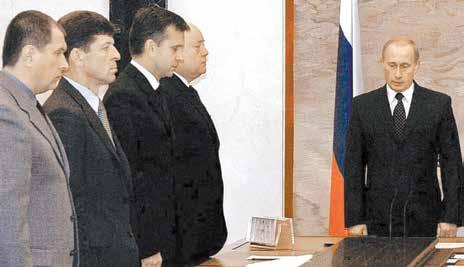 By David Ignatius
By David Ignatius

When people try to comprehend the catastrophe of President Vladimir Putin’s invasion of Ukraine, they often draw a straight line back to his apprenticeship as a KGB spy, his nostalgia for a fallen Soviet Union, and his rage at NATO enlargement. And that may indeed be the way future historians read this tragic story.
But another, more complicated version emerges in some recently declassified documents from the George W. Bush administration. Bush had maintained a surprisingly close relationship with the Russian leader, centered on a counterterrorism alliance. The United States was battling al-Qaeda at the time; Russia was fighting Chechen separatists. But Putin came to believe that America was an unreliable, hypocritical partner – and that belief would curdle into the open feud that has deepened, year by year.
This “alternative history” doesn’t condone or excuse Putin’s horrific crimes in Ukraine. His invasion of his neighbor was the illegal, unjustifiable act of a ruthless authoritarian. But in assessing the roots of such a conflict, it’s useful to understand the mind of the adversary – and to see clearly the pathway to disaster.
So, here are some little-known facts: The Russian-American counterterrorism alliance ruptured after a Sept. 1, 2004, attack by Chechen separatists on a school in Belsan, in the Russian region of North Ossetia. When the Russian authorities regained control on September 3, 333 people were dead, including 186 children, plus 31 attackers. In the aftermath, Putin blamed the United States
for encouraging the separatists by offering asylum to “moderate” Chechens and urging Russia to negotiate with them. A headline in Pravda argued: “How would Americans feel if Russia offered sanctuary to Osama bin Laden?”
Russian overreaction contributed to the slaughter at Beslan. The European Court of Human Rights found in 2017 that Russia had used tanks, grenades, and flamethrowers to crush the hostage-takers, adding to civilian casualties. Russia’s brutal campaign against the Chechens was a foretaste of what was to come in Syria in 2015 and now in Ukraine. But in 2004, Russia and the United States were partners in a “global war on terror.”
Three days after the September 2004 terrorist attack at Beslan, Putin delivered a blistering speech from the Kremlin voicing his indignation at the West in language he hadn’t used before:
“We showed ourselves to be weak. And the weak get beaten.” And then, in an unmistakable reference to the United States, Putin added: “Some would like to tear from us a ‘juicy piece of pie.’ Others help them ... reasoning that Russia still remains one of the world’s major nuclear powers, and as such still represents a threat to them.”
“We never got back on track” after the Beslan incident, argues Thomas Graham, who was Bush’s National Security Council senior director for Russia at the time. “Putin concluded – wrongly in the U.S. view – that the U.S. counterterrorism campaign was just a smokescreen to cover American geopolitical advance in Eurasia at Russia’s expense,” Graham wrote in an afterword to the Russia section of the new book, “HandOff: The Foreign Policy George W. Bush Passed to Barack Obama,” a collection of declassified transition memos pre -
pared for the incoming Obama administration.
This view that Beslan marked a turning point is shared by many other senior officials from the Bush years. “Our relations with Russia were calm, even warm,” wrote Condoleezza Rice in her 2011 memoir, “No Higher Honor.” Rice, a Russian speaker, was Bush’s national security adviser in his first term and then secretary of state. She noted that Bush and Putin developed a “strategic dialogue group” and a “presidential checklist” to address common problems.
From their first meeting, Rice wrote, Putin and Bush were “two men who enjoyed a certain degree of personal chemistry.” Bush expressed this in his now-chilling 2001 encomium: “I looked the man in the eye…. I was able to get a sense of his soul.” But beyond Bush’s overenthusiasm, there were real signs of partnership, as one of the declassified documents explains.
“Not only was Putin the first world leader to reach out to President Bush following the September 11 terrorist attacks, but he was also broadly receptive to President Bush’s initiatives, demonstrating early support for the War on Terror and U.S. operations in Afghanistan,” noted a January 2009, secret memo prepared by the Bush NSC’s Russia Directorate.
To help the CIA organize its post9/11 campaign against al-Qaeda in Afghanistan, “Putin overruled his security people and said that Russia would not block U.S. efforts to find bases in Uzbekistan and Kyrgyzstan,” Graham told me. Russia also provided the United States with intelligence from its network
of agents inside Afghanistan.
One vivid anecdote from that time: Rice recalled in her memoir that when CIA Director George J. Tenet said he needed supplies for Northern Alliance allies fighting the Taliban, she called Sergei Ivanov, the Russian defense minister. Ivanov said his agents would find the Americans some donkeys that could traverse the narrow mountain paths.
Then came Beslan. Did Putin have any grounds for his claim afterward that America was aiding the Chechen separatists? According to a careful review of the evidence by the Belfer Center at the Harvard Kennedy School, Putin was “partially correct.” The Belfer report noted that the United States in 2004 granted asylum to Ilyas Akhmadov, who was foreign minister of a Chechen separatist government in exile. The Bush administration initially opposed Akhmadov’s asylum request but then changed position.
Chechen separatism was a popular cause among some conservatives. The late senator John McCain (R-Ariz.) met with Akhmadov at least three times. The National Endowment for Democracy awarded him a federally funded fel-
lowship. Chechen separatists also raised money in the United States to support their cause, Graham recalled.

Putin later made the extravagant claim that U.S. intelligence agencies had aided the Chechen separatists. The Belfer Center report, again after careful review, found “no evidence of the U.S. government’s direct support for armed
power was slipping around its borders, and Putin was unable to reverse the disintegration.
Though Putin has argued that NATO expansion was the reason he felt betrayed, Bush administration officials say he didn’t express it at the time. “While displeased, Russia swallowed with little acrimony NATO’s admission of seven
have the right to ask: Against whom is this expansion intended?” In 2008, he told William J. Burns, then ambassador to Russia and now CIA director: “Don’t you know that Ukraine is not even a real country?”
Putin’s turn away from the West may have been inevitable. The Russian leader is an authoritarian, and he wanted to protect Russian influence in the former Soviet space. But Graham poses an intriguing query in summarizing the classified record: “Did the United States and Europeans miss something fundamental in the Russian situation and psyche at the time? Did they misread the situation and fail to craft an offer of cooperative relations that adequately accounted for Russian interests and perspectives?”
groups operating in Chechnya and/or other parts of the North Caucasus.”
In late 2004, Putin’s anger at what he saw as the West’s machinations would increase when the Ukrainian opposition leader Viktor Yushchenko won the presidency over the Kremlin-backed candidate, Viktor Yanukovych. Russia’s
Central European states in 2004,” Graham writes.
From 2004 on, the movie begins to roll toward the nightmare scenes of today. In a 2007 speech at the Munich Security Conference, Putin denounced the West. “NATO has put its front-line forces on our borders,” he said. “We
Regardless, a current U.S. official who follows Russia closely argues that “2004 was a turning point, there’s little doubt about it.” By late that year, U.S. intelligence was gathering reports that Putin’s security chiefs were urging him to break decisively with Bush and adopt a more aggressive policy. And ultimately, he did – with a vengeance.

A headline in Pravda argued: “How would Americans feel if Russia offered sanctuary to Osama bin Laden?”
If Pete Buttigieg wants to be taken seriously as a potential presidential contender, he ought to spend some time studying Florida Gov. Ron DeSantis. Compare the transportation secretary’s bungling of the toxic train derailment in East Palestine, Ohio, with DeSantis’s hands-on management of Hurricane Ian, and it’s obvious why the governor’s presidential prospects are rising, while Buttigieg has likely damaged his future chances to win the Oval Office.
When Hurricane Ian ravaged Florida, DeSantis was the very model of a commander-in-chief leading in a time of crisis. Before the storm hit, he was on the ground briefing Floridians on evacuation plans and putting in place strategies to manage gasoline shortages and restore power, internet, and cellphone service. Once the storm had passed, he moved swiftly to restore essential services and rebuild critical infrastructure. He got the bridge to Pine Island rebuilt in three days, reopened the Sanibel Causeway in just two weeks, cleaned up thousands of miles of debris, reopened roads and highways, created a state-run program to get travel trailers to residents whose homes had been destroyed, and offered free mental health services via online therapy to those impacted by the disaster. Even President Joe Biden praised DeSantis’s response to the hurricane as “remarkable.”
His crisis management is one of the reasons he won independent voters in Florida. Even voters who didn’t love his war on wokeness loved how he swung into action and delivered help quickly and effectively when they needed it the most. It’s also why he has a serious shot at the White House in 2024. Americans look at how he managed the response to one of the deadliest hurricanes ever to hit our country and can see him managing the storms and crises facing our nation from the Oval Office.
Buttigieg had a golden opportunity to demonstrate the same kind of leadership when a train carrying toxic chemicals derailed in East Palestine on February 3. He could have been on the ground from Day 1, meeting with local residents and officials,

that he issued his first tweet on the subject. And it was not until February 23 that he finally visited the site of the crash – a day after Donald Trump showed up. Yes, the former president got there before the sitting transportation secretary.
disaster was, according to The Washington Post ’s fact checking, untrue.
Then, Buttigieg tried to downplay the incident, declaring, “While this horrible situation has gotten a particularly high amount of attention, there are roughly 1,000 cases a year of a train derailing.” Even fellow progressives such as Rep. Ilhan Omar, D-Minn., criticized his response, tweeting that the derailment “will have a significant negative impact on the health and wellbeing of the residents for decades,” adding that we need “direct action from @ PeteButtigieg to address this tragedy.”
It’s not just the crisis in East Palestine that Buttigieg has botched. In the fall of 2021, as cargo ships lined up outside U.S. ports and Americans grappled with an unprecedented supply chain crisis – while Congress nearly melted down over the bipartisan infrastructure bill – Buttigieg was mysteriously missing in action. It turned out that he was on unannounced paternity leave for his newborn twins. Ultimately, he seems wholly uninterested in his job, which is probably why he never seems to be able to right things when the you know what hits the fan.
and marshaling federal resources to help a community in need.
Instead, he blew it. Buttigieg did not even mention the crash for 10 days – not a tweet, much less a visit to the disaster site. He spoke publicly, at the National Association of Counties Conference in D.C. on February 13, but failed to so much as mention East Palestine. It was not until February 13
Amazingly, Buttigieg attacked Trump for his visit and tried to deflect blame onto the former president, declaring that it was “somewhat maddening to see someone who did a lot try to gut not just rail safety regulations, but the EPA … then show up giving out bottled water and campaign swag.” His suggestion that the Trump administration’s regulatory rollbacks had contributed to the
The job Buttigieg really seems to be interested in is president. He likely saw the transportation post as a boring but easy steppingstone on his way to the Oval Office. But his shambolic performance has done damage to his presidential aspirations. Americans might look at Buttigieg’s incompetence and think: If he can’t manage a train derailment, how is he going to manage a crisis like the war in Ukraine?
Buttigieg’s feckless crisis management has shown that he’s no DeSantis. And with his performance in East Palestine, his presidential aspirations might have just gone up in smoke as toxic as the stuff wafting from a burning rail car.

With his performance in East Palestine, his presidential aspirations might have just gone up in smoke as toxic as the stuff wafting from a burning rail car.


The Navy SEALs is a unit of specially trained special operations forces within the U.S. Navy, and the average American citizen is familiar with their name. The training that goes into becoming a SEAL is arduous, and most candidates drop out at some point. The SEALs trace their roots back to the Underwater Demolition Teams (UDTs)
and other special maritime units during World War II. Active since 1962, the SEALs first proved themselves during the Vietnam War and have been involved in dozens of engagements for over 60 years. Today, they take on numerous roles including special operations, counter-terrorism, special reconnaissance, hostage rescue, and unconventional warfare.
Some of their operations have become known to the public, although they don’t always make headline news like their raid to kill Osama bin Laden. Here are some of the Navy SEALs whose stories both on and off the battlefield are quite fascinating.
Lieutenant Commander Roy Boehm from Brooklyn started his 30-year navy career as a diver on the destroyer USS Duncan during World War II. He was assigned to dive the sunken wreckage of the USS Arizona at Pearl Harbor and was wounded during the Battle of Cape Esperance in October 1942. After the war, Boehm left the navy for a short while and was on a cruiser that participated during the landings at Inchon during the Korean War. A few years later, he went through UDT training, and the 31-year-old was assigned to UDT-21 at Little Creek, Virginia. He was soon commissioned as an officer. His prior experience as a diver became useful when he was asked to test new types of underwater vehicles and submersibles.
The first commanding officer of SEAL Team Two was Lieutenant Boehm, and he hand-selected the men who were to be in his unit. Boehm believed that SEALs


should not only be highly trained in traditional military skills like shooting, parachuting, diving and demolitions, but they should also be proficient photographers, intelligence gatherers, and lock pickers. In 1963, he was one of the first SEALs to be deployed to Vietnam, although SEAL platoons wouldn’t arrive in the war zone for another three years. His Bronze Star with Valor citation reads in part, “In January 1964, he was instrumental in conducting a successful amphibious landing on a Viet Cong-held island. In the face of heavy small-arms fire, he accompanied the Vietnamese Navy Underwater Demolition Team in routing an enemy force and in destroying six loaded junks.”
In late 1964, Boehm was medically evacuated from Vietnam and returned to the U.S. to teach patrol boat tactics.
Most people would be satisfied with either becoming a doctor, astronaut, or fighter pilot, but for Navy SEAL Jonny Kim, he achieved all of the above before turning 40. The son of South Korean immigrants, Kim joined the navy right after high school and became a SEAL after graduating BUD/S (Basic Underwater Demolition/SEAL) class 247. He was a special warfare operator with SEAL Team

3 and trained as a combat medic, slipper, and navigator.
Kim’s two deployments to the Middle East included over a hundred combat missions, including one where he was cited for bravery on the battlefield. The action occurred on June 26, 2006 in a dangerous neighborhood in Ramadi, Iraq. Tasked as a combat advisor to an Iraqi Army platoon, the Navy SEAL noticed one of the soldiers laying helpless in the street after the unit took on heavy insurgent gunfire. Disregarding his own safety, Kim and another SEAL ran through a hail of enemy fire and dragged the soldier to safety. Then he observed another soldier who was hit in the head, and again, Kim ran through deadly gunfire to save a wounded soldier. Once both wounded soldiers were out of sight from the insurgents, Kim rendered combat aid. His lifesaving actions were recognized, and he was awarded the Silver Star.
In 2016, Kim graduated from Harvard Medical School and became a doctor in emergency medicine. A year later, he was one of twelve candidates chosen by NASA to join Astronaut Group 22 and completed training in 2020. Currently, he is awaiting flight assignment and could be selected for a future moon landing.
There have been a few SEALs awarded the Medal of Honor, and in the case of Michael Thornton, it was for saving the life of another Medal of Honor recipient. Born in South Carolina, Thornton enlisted in the navy in 1967 and served on destroyers. In 1969, he graduated BUD/S class 49 and was immediately assigned
intelligence-gathering mission as well as to capture enemy combatants. They were launched by the Vietnamese navy into a rubber boat and continued on foot once they reached land. The group found themselves further behind enemy lines than originally planned and soon was under heavy enemy fire. The Americans
the head by a bullet and was presumed to have been killed. SEALs don’t leave comrades behind, and Thornton ran back to rescue Norris dead or alive. He put the wounded soldier on his shoulders and ran through open ground, firing back at the enemy. When they reached the surf, Thornton inflated Norris’s life jacket and then helped another member of their group who had also been wounded. After three hours, they were picked up by the South Vietnamese Navy. Incredibly, Norris survived and was also awarded the Medal of Honor in an unrelated rescue mission.
to SEAL Team One. Later that year, he was shipped to Vietnam to start one of his several overseas combat tours. In late 1972, there were only a handful of SEALs remaining in Vietnam as the U.S. involvement in the war was winding down.
Thornton’s Medal of Honor was earned for actions taking place on October 31, 1972. Together with SEAL Lt. Thomas Norris and three South Vietnamese naval personnel, the team was on an
and South Vietnamese found themselves in North Vietnam and were outnumbered by a much larger enemy force. Thornton shot at an enemy soldier, but dozens more started firing back. He used tactics to confuse the enemy into thinking they were facing a larger force but was soon wounded in the back by a grenade.
The battle lasted hours, and the group was finally able to get a navy ship to cover their withdrawal. Norris was then hit in
Most SEAL missions are classified and probably will never be known. As one SEAL said, “My most important mission took place in a country that I will never be able to tell you about.” That being said, the missions by these mostly Forgotten Heroes that are made public is history not be forgotten.
Avi Heiligman is a weekly contributor to The Jewish Home. He welcomes your comments and suggestions for future columns and can be reached at aviheiligman@gmail.com.


SEALs don’t leave comrades behind, and Thornton ran back to rescue Norris dead or alive.































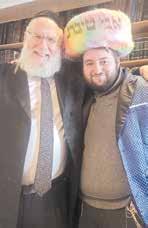






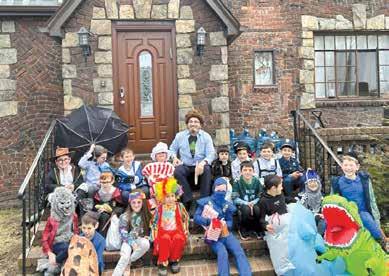































































































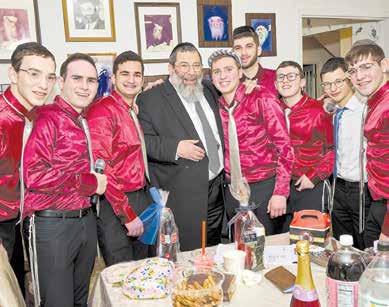











































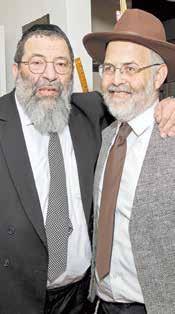







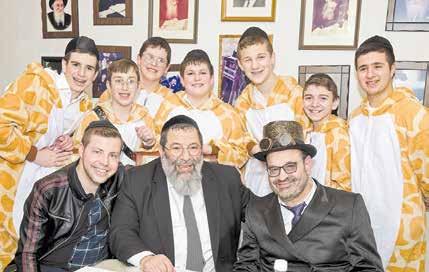












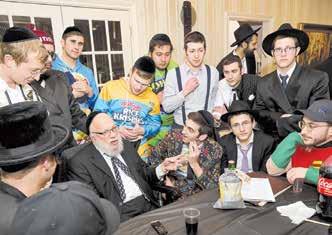
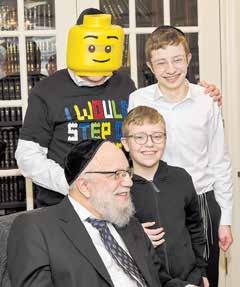
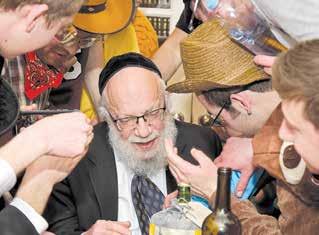



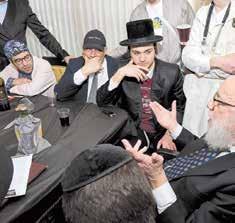



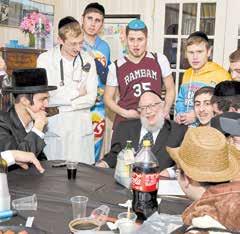































































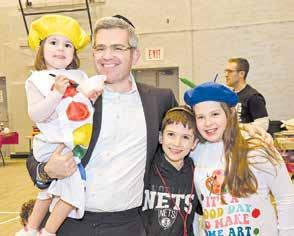





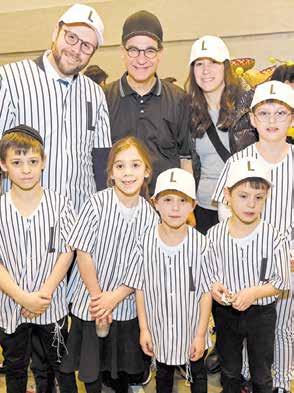





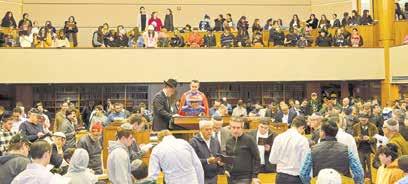
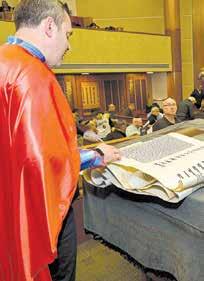

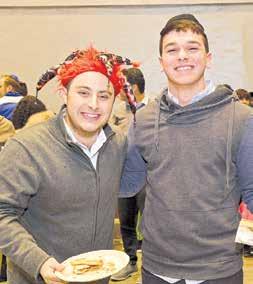

















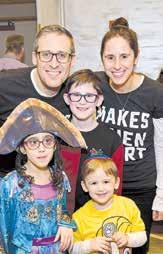































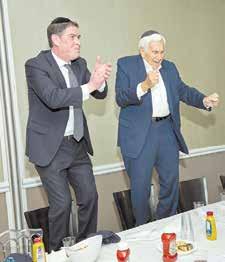












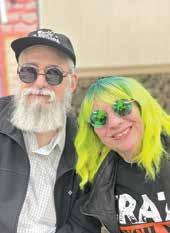



















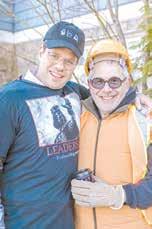






























































PEACEFUL PRESENCE STUDIO
Men’s private yoga, Licensed Massage & Holistic Health Guidance
436 Central Ave, Cedarhurst Info. & free video training
www.peacefulpresence.com
516-371-3715
GERBER MOVING FULL SERVICE MOVING
Packing Moving Supplies Local Long Distance
Licensed Insured
1000’S Of Happy Customers Call Shalom 347-276-7422
HANDYMAN AVAILABLE
For big or small jobs, Sheetrock, carpentry, painting, electrical, plumbing, install & repair appliances
Call Ephraim at 347-593-4691
VACUUM SALES AND REPAIR
All areas call Max Flam 718-444-4904
MANAGEMENT STAFF WILL ASSIST you with: * Obtaining Medicaid and Pooled Income Trust
* In-home Assessments, Individual and Family Counseling
* Securing reliable home care assistance
* Case and Care Management services
Dr. S. Sasson, DSW, LCSW (718) 544- 0870 or (646) 284-6242
HAIR COURSE:
Learn how to wash & style hair & wigs. Hair and wig cutting, wedding styling Private lessons or in a group Call Chaya 718-715-9009
ZEVIZZ WOODTURNING JUDAICA
Challah knifes, batei mezuzah, besamim holder, kiddish cups, havdalah candle holders, yad for sefer torah, pens, stenders, bowls and more 952-356-2228
LOOKING FOR PRIVATE PAY CLIENTS NPhomecare Service
Food prep meals, light house cleaning and laundry. Grocery shopping. Hospital visit. Be Padiatist. Physical Therapist. Educational therapist
Maintains your Independence in the comfort of your own home
Tel: 718 912 6425
Tel: 917 972 1428
Email: npersaud2022@gmail.com
WOODMERE - OLD WOODMERE
3 bedroom 2 full bathroomsSD# 14
Features LG living room with fireplace, den, large dining room, kitchen and dinette area, high ceilings, hardwood floors, primary bedroom plus sitting area plus 2 additional bedrooms, full basement, alarm, sprinkler, close to all. $759K Mark Lipner Associate Broker Berkshire Hathaway Laffey International 516-298-845 mlipner@bhhslaffey.com

DON’T GET STUCK WITH A TWO STORY HOUSE YA KNOW, IT’S ONE STORY BEFORE YOU BUY IT BUT A SECOND STORY AFTER YOU OWN IT!
Call Dov Herman
For An Accurate Unbiased Home Inspection Infrared - Termite Inspection Full Report All Included NYC 718-INSPECT Long Island 516-INSPECT www.nyinspect.com
WOODMERE
Charming Colonial on beautiful tree lined street in the heart of Old Woodmere. Home features 3 bedrooms, 1.5 baths, kitchen, dining area, living room, full basement. Relatively new heating system + hot water tank. Large & beautiful backyard. Great for entertaining. Close to all. $676K Mark Lipner Associate Broker Berkshire Hathaway Laffey International 516-298-8457 mlipner@bhhslaffey.com
CAN’T AFFORD YOUR PROPERTY TAXES? MORTGAGE?
Must sell for any reason?
Call for FREE Consultation. Call now 212-470-3856
Cash buyers available!
WOODMERE NEW TO THE MARKET
Move Right Into This Lovely Home, Totally Renovated Kitchen, SS Appliances, Quartz Countertops, Glass Backsplash, 10Ft Center Island, 2 Sinks, MBR W/Full Bath On The First Floor & 2 Additional Bedrooms + Full Bath. 7 New Split Systems, Hardwood Floors, New Recessed Lighting
Throughout, New Full Finished Basement W/Cedar Closet, Close To The Railroad, Shopping, Restaurants & Houses of Worship. OPEN HOUSE
SUNDAY, MARCH 19 11:30-1:00PM
1045 WEST BROADWAY Mark Lipner
Associate Broker Berkshire Hathaway Laffey International 516-298-8457 mlipner@bhhslaffey.com
WOODMERE
Spacious 5 bedroom 4 bathroom split level in Saddle Ridge Estates Well maintained home home , renovated eat –in-kitchen , formal living room and dining room, den, central air conditioning, hardwood floors, high hats, master bedroom with a custom bathroom and Jacuzzi tub, close to all $995k Mark Lipner Associate Broker Berkshire Hathaway Laffey International 516-298-8457 mlipner@bhhslaffey.com
HEWLETT
Luxurious Exquisite 6 bedrooms, 6.5 bath home situated on approximate 1.8 acre property in prestigious Hewlett Bay Park. Formal Living room and dining room, library, chefs Eat-in Kitchen, extraordinary great room leads out to veranda. large Gunite built-in pool + pool house with full bath, large slate patio, impressive sprawling property, school district #14 Hewlett-Woodmere. Close to all. P.O.R. Mark Lipner Associate Broker Berkshire Hathaway Laffey International 516-298-8457 mlipner@bhhslaffey.com
NORTH WOODMERE JUST LISTED Move Right Into This Beautifully Maintained and Updated Three Bedroom, 2.5 Baths Large Split Situated on an Oversized Park-like Lot Overlooking the Pond. Home Features naturally bright lit rooms with a Ground Level Den Leading to Patio, With Another Lower Level With Partially Finished Basement. Hardwood Floors Throughout Updated Kitchen With Granite Counters in School District 14 and Close to all Houses of Worship. $949k Mark Lipner Associate Broker Berkshire Hathaway Laffey International 516-298-8457 mlipner@bhhslaffey.com
WOODMERE: NEW TO THE MARKET
Well maintained 4 bedroom home on a cul-de-sac in Old Woodmere SD#14. Features central air conditioning, gas heat, eat -in -kitchen with stainless steel appliances, very spacious den, 2 car garage, hardwood floors, high hats, magnificent yard with an in-ground saltwater pool, close to the railroad, shopping and houses of worship. Call for a private showing. Mark Lipner Associate Broker Berkshire Hathaway Laffey International 516-298-8457 mlipner@bhhslaffey.com
LAWRENCE
Stunning One of a Kind Mid Century Modern 6 Bedroom, 6.5 Bath, Contemporary Ranch. Resort Style Home on Over an Acre of Property in Back Lawrence. Incredible Views, Regulation Size Tennis Court - Deco Turf. IG-Gunite Pool, Low Taxes, 5318 sq. ft. of Main Floor Living Space. Plus 5000 sq. ft. Basement With Very High Ceilings. Call Mark 516-298-8457 for more details Mark Lipner Associate Broker Berkshire Hathaway Laffey International 516-298-8457 mlipner@ bhhslaffey.com
WOODMERE
New to the market move right in 8 bedrooms 3 full bathrooms on a lot size 57x112. prime location features eat in kitchen with 2 sinks, new stainless steel appliances, gas heat, hardwood floors, possible mother daughter with permits, close to the railroad, shopping and houses of worship. Mark Lipner Associate Broker Berkshire Hathaway Laffey International 516-298-8457 mlipner@bhhslaffey.com
HEWLETT BAY PARK
Six bedroom home in highly desirable Hewlett Bay Park on 3/4 of an acre with an inground gunite pool and tennis court, en-Suite bathrooms and bedrooms on both floors, 1st floor Master Suite with steam shower and Jacuzzi tub, Eat-in Kitchen, with SS appliances, 2 sinks, 2 dishwashers, double oven, formal living room, formal dining room, den with fireplace. Close to railroad, shopping, and houses of worship. SD#14. Great house for entertaining. Park-like Property. P.O.R. Mark Lipner Associate Broker
Berkshire Hathaway Laffey International 516-298-8457 mlipner@bhhslaffey.com
WOODMERE
Spectacular 5 bedroom, 5 bath renovated home in SD#14 with in-ground pool & pool house, lot size 111 x 107. Formal living room & dining room, magnificent kitchen with SS appli-ances, tremendous den with fireplace and 4 skylights, vaulted ceiling, LED lighting, master suite, new CAC, new roof. Outside totally redone with Stone and Stucco. Backyard with new pavers, park-like property, sandbox, great home for entertaining. Close to all. $1,489,000 OPEN HOUSE SUNDAY, MARCH 19 1:30-3:00PM 562 SUNSET DR. Mark Lipner Associate Broker
Berkshire Hathaway Laffey International 516-298-8457
mlipner@bhhslaffey.com
WOODMERE
Great Home on a Cul-De-Sac, SD #15, Features 4 Bedrooms, 3 New Full Bathrooms, Gas Heat, Central Air Conditioning, Renovated Gourmet EIK w/2 Sinks, Granite Countertops, New Stainless Steel Appliances Leading out to a New Deck, Elegant Formal Dining Room, New Flooring, Moldings, and New Wood Bannister
Leading to the Bedrooms, Spacious Master Bedroom Suite w/Jacuzzi Tub, Sep Stall Shower, and a Large Walk-In Closet. Generously Sized Den Leading Out to a Magnificent Backyard With a New Pergola, Great Home for Entertaining, High Hats Throughout, New Front Walkway Leading to a Nice Front Porch, New Front Windows Close to RR, Shopping, Houses of Worship. P.O.R. Mark Lipner Associate Broker Berkshire Hathaway Laffey International 516-298-8457 mlipner@ bhhslaffey.com
HEWLETT BAY PARK
Prestigious Center-Hall Colonial in Hewlett Bay Park, Set Back on Private Property. This Stately Home Features a Grand Entry Foyer, Formal Living Room, Formal Dining Room, Chef’s Kitchen, Large Den, Master Bedroom suite with Sitting Room + 2 Baths (His & Hers) and Loft and Additional 3 Bedrooms + Bonus Rooms. Exquisitely Manicured Park-like property. Award Winning School District #14. Too Many Features To List. Will Not Last!
P.O.R. Mark Lipner Associate Broker Berkshire Hathaway Laffey International 516-298-8457 mlipner@bhhslaffey.com
WOODMERE
Charming Colonial on beautiful tree lined street in the heart of Old Woodmere. Home features 3 bedrooms, 1.5 baths, kitchen, dining area, living room, full basement. Relatively new heating system + hot water tank. Large & beautiful backyard. Great for entertaining. Close to all. $676K OPEN HOUSE
SUNDAY, MARCH 19 • 3:00 – 4:30 PM
58 CENTRE ST. Mark Lipner Associate Broker Berkshire Hathaway Laffey International 516-298-8457 mlipner@ bhhslaffey.com
WOODMERE
Beautiful, brick, colonial boasting 5 bdr 3.5 Bth in pristine condition. Excellent location, near all! Move right in! RCUSA 516-512-9626
In the heart of Cedarhurst (Close to Woodmere , Lirr & Cedarhurst Park)
EIK Kosher Kitchen/ Dr/Lr/Family Room/ Playroom/ 4 Bedrooms, 3 Full Baths/ Basement:
2 Bedrooms, 1 Full Bath, Kitchenette, Separate Entrance
Asking $1.3m
Whatsapp Text Only:
845-213-0002 No Brokers
FAR ROCKAWAY REDUCED!
Moller Realty Group
Corner Lot for Sale. 40x100. Approved Plans. Legal 2 Family. Asking $499k
*Adjacent lot with existing legal 2 also available Both lots Asking 1.4m
Motivated Seller Call or Text 516-506-3347
WOODMERE
Move right in. 4 bedrooms, 4 bathrooms split level. Features eat-inkitchen with stainless steel appliances, granite countertops, formal living room and dining room, main floor family room with fireplace, 2 master bedrooms with full bathrooms, central a/c, gas, heat, hardwood floors, recessed lighting, cedar closet, sauna, generator and much more.
$1,115,000 OPEN HOUSE SUNDAY MARCH 19 1:30-3:30PM Mark Lipner
Associate Broker Berkshire Hathaway Laffey International 516-298-8457
mlipner@bhhslaffey.com
WOODMERE
House for rent, fully renovated located in Woodmere 4 bedroom 2 full bath split level. 2 car garage +driveway. Backyard on water. SD#14 917-324-9292.
WOODMERE
Move Right In. Renovated 8 Bedroom Colonial, Prime Location in SD#14Old Woodmere. Smart Home, Camera System, New CAC System, AG Pool, Large Eat-in Kitchen with Pantry. Finished Basement. Mark Lipner Associate Broker Berkshire Hathaway Laffey International 516-298-8457 mlipner@bhhslaffey.com
WOODMERE HOUSE RENTAL
Lovely Split Level on Quiet Residential Tree Lined Street. Huge Park-like Property. Four Bedrooms, Two Full Baths, deck & playroom. Close to all. Mark Lipner Associate Broker Berkshire Hathaway Laffey International 516-298-8457 mlipner@bhhslaffey.com
WOODMERE
Apartment for rent. SD#14. 2 bedroom apt fully renovated separate utilities water view. Walking distance to shul. 347-517-3552

CEDARHURST MOVE RIGHT IN. Totally Updated One Bedroom Townhouse Apartment on the First Floor. Featuring 1.5 Bathrooms, Central Air Conditioning, Washer/ Dryer in the Unit, Kitchen With SS Appliances, Hardwood Floors, and Recessed Lighting. Freshly Painted. Super on Premises. Underground Parking is $95/month. This spacious rental is managed by a responsible landlord. Great Courtyard. Close to the Railroad, Shopping, Restaurants, Post Office, Cedarhurst Park + Houses of Worship. NO BROKERS FEE Mark Lipner Associate Broker Berkshire Hathaway Laffey International 516-298-8457
mlipner@bhhslaffey.com
WOODSBURGH
Magnificent 2K Sq. Ft. Co-Op. 3Br/2Bth, Eik, Lr, Dr, W/D In Unit, Gar, 2 Stor Units, Elev, Near All $775K 516-846-1032 No Brokers
LAWRENCE
Spacious 2BR, 2 Full Bath Apt with an enclosed terrace in the heart of Lawrence. Well maintained & manicured building. New hardwood floors, updated Eat-in Kitchen with gas stove. warming draw, dishwasher & microwave. New windows on the enclosed terrace & one of the bedrooms. 3 New A/C Units & New Refrigerator. Close to shopping, transportation, library, schools, and houses of worship. $339K OPEN
HOUSE SUNDAY FEBRUARY 19 2:003:30PM 284CENTRAL AVE B-5 Mark Lipner Associate Broker Berkshire Hathaway Laffey International 516298-8457 mlipner@bhhslaffey.com
CEDARHURST
Move Right In. Totally updated 2BR, 2 Bath, Apt. on the 1st Floor. Private Entrance, CAC, W/D in Unit, Kitchen with SS Appliances, Hardwood Floors, Recessed Lighting, Freshly Painted, Great Courtyard, Parking $95/Mo. Close to Railroad, Shopping, Restaurants, Cedarhurst Park + Houses of Worship NO

BROKERS FEE Mark Lipner Associate
Broker Berkshire Hathaway Laffey International 516-298-8457 mlipner@bhhslaffey.com

LAWRENCE
Spacious 2BR, 2 Full Bath Apt with an enclosed terrace in the heart of Lawrence. Well maintained & manicured building. New hardwood floors, updated Eat-in Kitchen with gas stove. warming draw, dishwasher & microwave. New windows on the enclosed terrace & one of the bedrooms. 3 New A/C Units & New Refrigerator. Close to shopping, transportation, library, schools, and houses of worship. $339K Mark Lipner
Associate Broker Berkshire Hathaway Laffey International 516-298-8457
mlipner@bhhslaffey.com
CEDARHURST
New to the market Nice 2 bedroom apartment in the heart of town. Spacious rooms, eat –in-kitchen, L/rD/r, 3 ac units. Laundry on premises, underground parking, storage, close to the railroad, shopping, schools, houses of worship & park $299k Mark Lipner Associate Broker Berkshire Hathaway Laffey International 516-298-8457
mlipner@bhhslaffey.com
Beautiful & Spacious 2 Bedroom Apartment Across From The Golf Course. Elevator Building, Updated Kitchen, Gas Cooking, Granite Countertops, Washer/Dryer In Unit, High Ceilings, Great Closet Space, Storage in Basement, Close To RR, Shopping & Houses Of Worship.$349K
Mark Lipner Associate Broker
Berkshire Hathaway Laffey International 516-298-8457
mlipner@bhhslaffey.com
LAWRENCE
One Bedroom Renovated Apartment In Prime Lawrence. Efficiency Kitchen, Renovated Bathroom. Sunken LR, Dining Room, Close to All, Transportation, Shopping, Worship. $275k Mark Lipner Associate Broker Berkshire Hathaway Laffey International 516-298-8457 mlipner@ bhhslaffey.com
HEWLETT
3 bedroom 2 bath co-op with central air conditioning, terrace, washer dryer, hardwood floors, recessed lighting, magnificent kitchens, ss appliances, l/r, d/r, close to the railroad, shopping, and houses of worship. $319k OPEN HOUSE


SUNDAY, MARCH 19 11:00-1:00PM 1201 EAST BROADWAY H-23Mark Lipner Associate Broker Berkshire Hathaway Laffey International 516298-8457 mlipner@bhhslaffey.com
HEWLETT
Totally renovated 1 and 2 Bedroom, Apartments with washer/dryer, kitchen with quartz countertops, stainless steel appliances. Recessed lighting, hardwood floors, storage in basement. Close to RR, shopping, and houses of worship. Mark Lipner Associate Broker Berkshire Hathaway Laffey International 516-298-8457 mlipner@bhhslaffey.com
HEWLETT
Hewlett House 1 Bedroom Co-op. Unit Includes 1 Parking Spot + Storage Unit, W/D Outside of Unit. Close to Shopping, Schools, Houses of Worship, Restaurants + Parks.
Prime Location in the Heart of Hewlett. $109k Mark Lipner Associate Broker Berkshire Hathaway Laffey International 516-298-8457 mlipner@bhhslaffey.com
CEDARHURST
1, 2 and 3 bedroom apartments, totally renovated private entrance , central air conditioning, hardwood floors, washer/dryer, garage parking, dishwasher, recessed lighting, private playground, close to railroad, park, shopping and houses of worship. Call for more details
Mark Lipner Associate Broker Berkshire Hathaway Laffey International 516-298-8457 mlipner@bhhslaffey.com

This amazing two-bedroom two full bathroom condo Features a luxurious lifestyle in the beautiful city of Lawrence. What more could you ask for? The building has a 24-hour doorman and elevator access, with a social room, library, washer/dryer inside the unit, and terrace. Plus, the added benefit of having a live-in super to ensure maximum safety and security! And don’t forget about your new kitchen complete with a gas stove, refrigerator, microwave, and even two dishwashers! The living room and dining room are spacious and have recessed lighting installed throughout. Both bedrooms feature lots of closet space for storage. To top it off, there’s even garage parking available to make your life just that much easier! Don’t miss out on this incredible opportunity. Please call for a private showing Mark Lipner Associate Broker Berkshire Hathaway Laffey International 516-2988457 mlipner@bhhslaffey.com
Classic Center Hall, with Lg Main level Den and EIK, Master Suite plus 2 Bdrms, 3 New Baths plus Finished Basement. Beautiful fenced yard with Deck and Summer Kitchen plus Pro Inground Basket ball hoop. New Roof All New Exterior and New Tankless Hot
Suite with Luxurious Bath and Walk in closet,+4 Bdrms and 2 Beautiful Bths ,2nd Flr
Laundry Rm , Full Finished Basement with 10 ft Ceilings Huge Playrm 2 Bdrms and Bth laundry Rm storage, Beautiful Manicured Garden.

WOODMERE
1 bedroom apartment, elevator building, eat-in kitchen, full bath, hardwood floors, plenty of closet space. Ceiling fan in bedroom & kitchen, laundry room in the basement. Close to the railroad, shopping, and houses of worship
$168k Mark Lipner Associate Broker Berkshire Hathaway Laffey International 516-298-8457



mlipner@bhhslaffey.com
WOODMERE
Totally renovated bright and sunny 1 bedroom corner unit apartment with a washer/dryer. Features quartz countertops, ss appliances, recessed lighting, bathroom with chrome fixtures, close to the railroads, shopping and houses of worship. Call for details Mark Lipner Associate Broker Berkshire Hathaway Laffey International 516-298-8457 mlipner@bhhslaffey.com

WOODMERE
Move right in!! 2 Bedroom Apartment, Elevator Bldg in SD #14, Pre War Bldg, Pet Friendly, Laundry Room in Basement, Wood Floors, New Windows, Corner Apartment, Beautiful Renovated Kitchen w/SS Appliances, 3 A/C Units, Close to RR, Shopping & Houses of Worship. A must-see! $199k
CEDARHURST
1 bedroom 1 bathroom apartment, elevator building, eat-in kitchen, spacious rooms throughout, laundry room on-premises, garage parking, close to all Mark Lipner Associate Broker Berkshire Hathaway Laffey International 516-298-8457 mlipner@bhhslaffey.com
BOOKKEEPER
Excellent growth potential, Frum environment, Excellent salary & benefits. Email resume to: resumetfs1@gmail.com
SEEKING ELA TEACHER
Immediate opening. ELA teaching position for Gr. 5. Mon.-Thurs., afternoon hours. Far Rockaway/5T area. Competitive salary, warm, supportive environment. All teaching materials provided. Teachersearch11@gmail.com.
A YESHIVA IN QUEENS is looking for an experienced part/ full time secretary, 2-year-old morah, kindergarten morah, kindergarten morah assistant and Pre-1A English teacher for the 2022-2023 school year. Nice and timely pay. Please email resume to mshelt613@gmail.com or call/text 718-971-9799.
BRIGHT FUTURES
Has openings for providers. Work one on one with children towards their goals and earn great money doing what you love! Respite, sports, art, etc. We pay $50/hr for providers with a Bachelor’s and $25/ hr for providers with a HS diploma. Email info@brightfuturesny.com or text/call 347-970-9531
MDS REGIONAL NURSE: 5 Towns area Nursing Home management office seeking a Regional/Corporate level MDS Nurse to work in our office. Must be an RN. Regional experience preferred. 2-3 years MDS experience with good computer skills required. Position is Full Time but Part Time can be considered. Great Shomer Shabbos environment with some remote options as well. Email: officejob2019@gmail.com
DEVELOPMENT ASSISTANT
A multi-tasker needed for general office work. The ideal candidate is someone who is detail-oriented, responsible, and can take ownership. Looking for someone who is eager to learn, and expand his/her skill set while possessing the ability to work independently and as part of a team. Experience with Excel required. Five Towns location. In-office position only, not remote. Please send resume to 5tpart.timecareer@gmail.com
YESHIVA ATERES EITZ CHAIM
Boys HS Cedarhurst, seeking GS teacher for afternoons, M-TH. Warm and supportive environment. Competitive salary based on experience. Please email resume to aecrabbioppen@gmail.com.
IMMEDIATE OPENING
ELA teaching position for Gr. 5. Mon.-Thurs., afternoon hours. Far Rockaway/5T area. Competitive salary, warm supportive environment. Teachersearch11@gmail.com
5 TOWNS BOYS YESHIVA SEEKING ELEM GEN ED TEACHERS

Excellent working environment and pay. Only lic/exp need apply. Email resume to yeshivalooking@gmail.com
LOOKING FOR A DRIVER
Business looking for someone that has a large van or sprinter that can work a full day on Wednesdays on a weekly basis throughout the year in Brooklyn. Please do not call if you do not have a large van or a sprinter 347.992.7411
This tax season, Americans are grumbling over the usual government forms, bureaucratic red tape, and looming deadlines. But it’s worth stepping back to realize the IRS isn’t responsible for the mess. That fault lies with Congress, where lawmakers spend their days conferring with their constituents, debating weighty issues, marking up legislation, and who are we kidding? They spend their days grubbing for campaign cash and their nights spouting talking points on cable news. (If an ambitious young senator were to write an update to JFK’s Profiles in Courage, who would he write about in today’s Congress? Discuss among yourselves.)
It’s also worth remembering that some of the best (or worst) ideas come bubbling up from state and local governments, aka “laboratories of democracy.” Love/hate Obamacare? It started out as Romneycare in Massachusetts. New York has a complicated tax system, with a 10.9% top bracket, that just happens to chase millionaires down to Florida. Meanwhile, Texas has no state income tax, nicer roads, and a faster-growing economy. So let’s take a look at a couple of ideas percolating out where real people live.
Arizona is full of snowbirds from colder, frostier places where the wind comes sweeping down the plains. Many of them
are retirees, living on fixed incomes, and struggling with inflation. State Representative Rachel Jones has introduced a bill to make their lives easier by eliminating property taxes for people who own their primary residence outright. But the current draft raises important questions. For example, there’s no exemption for reverse mortgages that let older owners tap the equity in their homes without having to
1 . The Bel Air house includes 12,130 square feet, with seven bedrooms and 14 bathrooms on 1.3 acres with views of the ocean. There are two infinity pools (because having just one pool is for peasants), an indoor atrium with a water wall, a -12seat theatre, and an indooroutdoor gym.

Why the April deadline? In 2022, Los Angeles voters passed a mansion tax to
Naturally, planners are already floating ideas to skirt the tax. How about splitting a sale into two transactions, one for the land and one for the structure? What if a buyer splits the purchase with a trust, taking two separate tenancy-in-common interests on two separate closing dates? (It sounds silly, but that’s why tax lawyers drive Jaguars.)
Both of these proposals run counter to federal law. The 2017 tax act limited deductions for state and local taxes, including the property taxes Arizona might eliminate, to just $10,000 per year. And federal law currently lets homeowners exclude up to $500,000 gain selling their primary residence. No mansion tax there!
make payments or move. And, while Arizona boasts one of the lowest property tax rates in the country, there’s no provision for replacing the revenue the state would lose from the bill.
Further west, in Los Angeles, Million Dollar Listing Los Angeles star Josh Altman is dangling a 1 $ million bonus to any agent who can help close escrow on a 27.9$ million property before April
fund affordable housing and tenant assistance programs. That tax is four percent on sales above $5 million and increases to 5.5% on sales above $10 million. Notably, it applies to the entire sale price, not just the amounts above those thresholds. And you owe even if you lose money on the sale. If Altman’s listing sells for the asking price after March 31, his seller pays 1.53$ million.
You already know that having a plan is the best way to pay less tax. But it’s important to keep that plan up to date as laws change, and your own circumstances change. If you’re thinking of moving up or down, call us before you sign a contract so we can help you keep as much as you can!
Further west, in Los Angeles, Josh Altman is dangling a $1 million bonus to any agent who can help close escrow on a $27.9 million property before April 1.
Where is it? I just had it a minute ago!
This is how most of us spend our lives.
We keep wishing for a tracking device to be placed on everything we own so we can find it again. But then the problem arises that we need to be able to find the thing that finds the thing.
And most of the time, we’re the thing that winds up needing to find it because we usually cannot locate the tracking device either.
For instance, we have trouble locating our iPad to help us signal to our cell phone. After all, you’d probably be using your iPad, if you had any idea where it was!

So we look for ways to keep not losing our thing in the first place.
Cellphones have certainly become the number one thing we tend to find ourselves hunting for probably followed up by our pocketbooks or wallets, or keys, or glasses, or shoes! And often, “the book I was just holding.”
Am I speaking your language?
This becomes a daily challenge.
For instance, “Where’d I put my cellphone? I had it a second ago” is probably the most recited sentence today.
A few months ago, my waterproof phone fell in the water. Whatever wa -
terproof meant, it didn’t mean it for my phone. After spending a comfy night in a bed of rice and then apparently being charged too soon, it needed to be replaced.
Challenge number 1: what phone to get now? Do I need a bargain price or all the new features?!
Also, do I want one I can locate by size
That was along with my purse, which was in the same spot for the same reason.
I was sufficiently strapped up. However, when I got into the car, that meant that when the no seat belt indicator started buzzing, I thought it wasn’t for me. I saw so many straps across my chest I thought I was absolutely buckled in. Luckily, the car didn’t agree with me or give up on me
want to strangle myself.
And on top of that, I bought a bright red cover for my phone. And I made sure its red rim showed from the front as well. That way, just in case I did put it down, I created a fighting chance that I’d find it.
It helps – as long as nothing gets put on top of it by anyone.
Still, even in those cases, I have a backup: I see the strap dangling out. Sounds great, huh?! Well, last week I was so happy to see the strap hanging out that I grabbed for it – enthusiastically – only to realize I was dangling my 2-year-old nephew by his suspenders.
The point is whether it’s our shoes, phones, purses or whatever, we need to find a better system than the ones we have for locating them or we are going to drive ourselves stir crazy.
or one that I can actually still lift? Without a crane, that is!
My solution was get rid of my attached battery pack which allowed me to order a strap that kept the phone hanging from me all day.
Great solution – now I always knew where my phone was. The accompanying problem was it was often dead !
Oh, and then there were the other issues. Firstly, when I got it, I placed it across my chest so it wouldn’t slip off.
that readily, and so I recognized I was in need of some more straps across my chest!
That created my next issue! Since I’m in and out of the car so quickly, my phone and purse now get trapped under the safety belt. After all, who has time to unravel that whole mess?
Therefore, if I get a phone call or need to pay a toll, my EZ-Pass or Bluetooth better be on their best behavior or I’m going nowhere and talking to no one. Unless, I
I’d say call me if you have any great suggestions, except, I don’t want to create another situation where you would need to going looking for your phone!
Rivki Rosenwald is a Licensed Marriage & Family Therapist working with both couples and individuals and is a certified relationship counselor. Rivki is a co-founder and creator of an effective Parent Management of Adolescent Years Program. She can be contacted at 917705-2004 or at rivkirosenwald@gmail.com.
“Where’d I put my cellphone? I had it a second ago” is probably the most recited sentence today.

